- Travel & transport

Air travel in the 60s
Glamour, luxury and style?

Flying is not what it used to be. In the 60s it was glamorous and stylish. To fly meant you had arrived, you were part of the jet set. Certainly flying was still for the privileged few, but was it that glamorous?
In the 1969 film, "Billion Dollar Brain", Harry Palmer (Michael Caine) received a telephone call on an old Bakelite black telephone. A talking computer told him to go to West London Air Terminal and pick up a package from a locker. He took a taxi to West London Air Terminal at Cromwell Road, Kensington. In the locker were a thermos flask and an air ticket to Helsinki.
West London Air Terminal, built in 1963, was a modern, efficient looking building. It had a departure lounge and check-in desks, but no aeroplanes ever landed or took off from there. After check-in passengers and their luggage were transported by bus to Heathrow. The terminal was used exclusively by British European Airways (BEA).
Air travel had an image of glamour and excitement in the 60s. Air travel was for the rich and famous. The 1963 film "The VIPs" tells the story of a group of wealthy people stranded at Heathrow by bad weather. As well as Harry Palmer, the most famous 60s spy, James Bond, travelled by plane to Jamaica (in "Dr No") and Miami (in "Goldfinger"). The phrase "Jet Set" conjures up an image of well-healed and sophisticated international travellers. Today air travel seems far from glamorous. Yet even as far back as the 'fifties flying was opening up to ordinary people as well.

The effect of this change was that by the end of the sixties the actual experience of flying was already losing some of its appeal. Subscribers to "Which?" magazine picked up on a few of today's favourite moans: queues, crowding, delays whilst waiting for luggage and damaged luggage. The airlines themselves had been wrestling for years with the problem of transporting increasingly large numbers of people.
In the early 'fifties there was only one class of travel: first or better than first class. Such luxuries as cocktail bars, and even beds had been provided on transatlantic flights. Fares were expensive and passengers were either very wealthy or claiming the trip on expenses. By the end of the fifties, there were four classes of travel, deluxe (better than first), first class, tourist class and economy class.
Deluxe services gave passengers the very best that the airlines could offer. On the new jets, there were no flat beds or separate bars. Passengers, instead, had wide reclining seats and superb gourmet catering. BOAC's Monarch service was flying from London to New York with Boeing 707s in 1960. The advert stressed the Rolls Royce Conway engines that powered the 707, confirming that BOAC was still buying British. The 707s had just replaced Comets on this route. It also suggested that this was the Rolls Royce of air services. BOAC claimed that it was the finest service in the world.
The four class arrangements did not last long. Pan American only offered first and economy on its transatlantic jet service by 707 from 1958. In the sixties economy and tourist were much the same. Most European flights offered passengers a choice of first or economy/tourist. British European Airways offered passengers first and tourist. Tourist class passengers were given a seat with 34" pitch. First class passengers enjoyed 42" pitch and greater seat width, together with better food and drink. In Len Deighton's "The Ipcress File", the Harry Palmer character (he had no name in the book) told readers a free drink and an extra 6" of seat width made first class worth the extra money; if it was on expenses that was!
How much more money was it? A flight from London to Helsinki, a trip also made by Harry Palmer, cost 114 first class return and 80 economy by SAS in 1967 (1277 and 896 adjusting for inflation). If you are wondering, the same trip costs 289 economy and 820 business today. There are two interesting points here. Certainly, the trip cost more in the sixties to travel in economy than it does today to travel business class, but business only offers the same legroom as economy did in the sixties. The other important factor is that the price differential is much greater today. If you were able to afford the sixties' economy fare, you might think it was worth paying about forty percent more for greater comfort and better food and a more enjoyable trip. Nowadays it would be hard to justify paying nearly three times as much for the business class fare.
First class menus from the 60s were fantastic. This is from a Swissair menu, from 1966:
- Hors d'oeuvre
- Imported Malossol Caviar, Melba Toast, Butter
- Slices of Foie Gras de Strasbourg, Pumpernickel, Butter
- Fresh, Cold Lobster Bellevue, Chef's Sauce
- Glaced Asparagus Spears, Air-dried Ham, Sauce Mayonnaise
- Thin Slices of Smoked Salmon, Fluffy Horseradish Sauce
- New Zealand Shrimp Cocktail, Cocktail Sauce
- Real Turtle Soup
- Cold Vichyssoise
- Main Courses
- Prime Filet Mignon with Truffles, Potato Balls, Artichoke Bottoms, Grilled Tomato, Salad
- Veal Steaks, Swiss-Italian Style, with thin Layer of Swiss Cheese, Noodles in Butter, Braised Lettuce with Chipolata, Salad
- Poached Breast of Chicken in Curry, Pilaw Rice, Buttered, early June Peas, Salad
- Chops and Cotelette of Spring Lamb, Miniature Potatoes, Buttered String Beans, Salad
- Roast Pheasant en Cocotte, Sauce Smitane, Mascotte Potatoes, Leaf Spinach, Salad
- Swiss Speciality of Minced Veal with Button Mushrooms in Cream Sauce, Spaetzlis in Butter, Salad
- Saute of Filet of English Sole with Truffles, Diced Artichokes, Olive Potatoes, Salad
Travelling economy in the sixties could vary from airline to airline, just as it does today. In 1965 a journalist writing for 'The Aeroplane' made a round the world trip in economy class. He found that six-abreast seats with 34" pitch did not offer enough comfort to sleep. Some airlines even allowed more than the regulation 34" and some even served champagne to economy passengers. Free food for tourist and economy passengers had become common in the sixties. The seats in BOAC's VC10s had a reputation for being particularly comfortable so much so, that this writer felt that they solved the legroom problem. He also found that economy passengers were often infrequent flyers, and that they did not mix well with more seasoned travellers.
One innovation from the sixties that made flying more bearable in the less comfortable parts of the plane was in-flight movies, or IFE (in-flight entertainment). There had been experimentation with in-flight movies as early as 1925. However, TWA was the first airline to regularly show in-flight movies. Their first offering was 'By Love Possessed', shown in 1961.
Passenger experience of in-flight movies in the 60s was vastly different from today. They were only shown on popular long-haul routes. Not all airlines did them, although there was increasing competitive pressure to do so. There could only be one movie per cabin. It was either a video, or a 16mm cine film. United offered a 16mm colour cine system and the choice of several audio channels as an alternative.
Films shown by airlines were necessarily bland. They had to offend no-one and attempt to entertain as many passengers as possible. By 1966 there were over 200 daily feature length movies being shown by the airline industry. They were usually somewhat behind what was on offer in the cinemas. Nevertheless, passengers showed a distinct liking for them.
At the end of the 60s there were two radical developments that promised to shape the future of air travel: jumbo jets and super sonic travel. Concorde demonstrated supersonic travel in 1969 and the airlines were primed to take up Boeing's new 747 jumbo jet. At the time it seemed that supersonic travel would soon be a part of our lives, but it was the jumbo that really set the pace for the future. The first airline to fly the Boeing 747 was Pan Am. Their first commercial flight was in January 1970.
So was air travel in the 60s more glamorous? If you were flying first class, possibly yes. Paradoxically first class was more affordable in the 60s than today. Against that you had to make do with a mere 42" pitch, bettered in most business class seats on long haul flights today. There were fewer people flying in the 60s, so there was probably a greater chance of being next to an empty seat in economy than today. Some economy seats were better than others and most offered the regulation 34" pitch, putting most of today's carriers to shame. But with limited in-flight entertainment and no free drinks, it was hardly that much better than economy travel today. It was more a question of attitude. Flying itself was exciting. It isn't today.
Your comments
Add comment.
- Terms & conditions
- Privacy policy
Mid Century â Facts & Figures â Collectibles

- Pounds, shillings & pence
- Imperial weights & measures
- Prices & incomes
- Babies' names
- Social history
- Food & drink
- Collectibles
- Vintage technology
- School days from the past
- Shops & shopping
- About Retrowow
â Mid Century â Facts & Figures â Collectibles â
Simple Flying
The golden age of flying: how things have changed.

Your changes have been saved
Email is sent
Email has already been sent
Please verify your email address.
You’ve reached your account maximum for followed topics.
- Flying in the 1950s and 1960s was luxurious and glamorous, with spacious cabins and no class distinctions.
- Amenities on board included beds, lounges, and sophisticated meals prepared by esteemed chefs.
- Flight attendants were young, glamorous, and focused on passenger comfort, until safety became a priority in the 1980s and 1990s.
The golden age of travel in the 1950s and 1960s was the epitome of glamour and luxury. Flying was a huge event and only for the relatively wealthy. It was a prestigious and glamorous experience to have. What made it so special and different to air travel today? Let's go back in time.
In the cabin
Aircraft cabins were less crowded and the seats had more legroom and space to move around. The seats were large and comfortable, no matter how long or short your flight. You could recline your seat without offending anyone. The seat pitch was between 36–40 inches today compared to that of 28 inches today. The aisle was much wider than today's aircraft. There was no distinction between first class and economy, it was all one cabin.
Love aviation history ? Discover more of our stories here!
Other amenities onboard
Some aircraft had beds on board like bunks with a privacy curtain in which passengers could sleep. It was not unusual for passengers to find a piano lounge or bar on the aircraft, where they could relax and socialize. Cocktails were served at sophisticated parties and the passengers could enjoy themselves and possibly forget their fear of flying. Passengers were given 'postcards from the sky' to send to friends and family, which became very collectible.
The experience
Traveling on an aircraft was a luxury experience that followed the cruise liner experience. Airlines focused on comfort and luxury, and it was not just a seat getting you from A to B. It was something to enjoy and tell your friends about. There were no pajamas allowed onboard, it was a fashion show with everyone dressed in their finest attire. Passengers dressed in a very smart and formal manner. There were no baggage limits or fees and items were delivered by courier back to their homes.
Inflight meals
There was no sign of meals in a foil tray back in the day. Menus were created by esteemed restaurant chefs. Mealtimes were a gourmet experience and there were multiple courses. Ice sculptures adorned with caviar were normal. Soup would be served from a tureen and lobster was often an appetizer. Roast beef and prime rib could be freshly hand carved from the silver trolley. Of course, white linen, silver cutlery and fine china were the order of the day. Champagne, brandy and fine French wine were abundant.
Inflight smoking
In the 1950s and 1960s, smoking onboard an aircraft was completely normal. Flight attendants would hand out cigarettes and cigars and light them for the passengers. Onboard fires became an issue when hot cigarettes would catch light to hand towels in the lavatory, enforcing fire detectors and suppressors in later years. The last smoking flight took place in 2000.
How Have Aircraft Tugs Evolved Over Time?
Tugs are common for jet aircraft pushback now, with use expanding significantly since the development of jets.
Flight attendants
The flight attendants were young, single and glamorous and had to retire before the age of 30. They led a glamorous lifestyle, jetting around the world on extensive trips. They had designer uniforms, often with gloves and a hat and could never put on weight. The emphasis was on comfort in the cabin and making it a great experience for the passengers. This changed in the 1980s and 1990s, when safety became the focus of the role.
Aviation safety
Security at the airport was a relatively simple process, a bit like going to a bus stop, until hijacking became more common during the late 1960s. In the US alone, between 1968 and 1971, there were 130 hijackings. People were scared of flying as it was a relatively new form of travel for most. In fact, it was quite a dangerous time to fly and accidents were common. The aircraft cabin was often unpressurized, so it could be loud in the cabin. Cigarettes and alcohol had probably quelled fears.
Being A Flight Attendant In The Golden Age Of Flying
Living the jet set lifestyle.
In the 1970s, flying became more affordable for the public. A TWA flight in 1953 from Chicago to Phoenix cost $138, which would be $1200 in today's money. People saved up money in order to fly. In the 1980s, ticket prices came down even further, allowing more people to be able to fly. In the 1970s and 1980s, there was a lot of change in the aviation industry and there was no need for glamour and luxury anymore. The golden age of travel was truly over but bringing with it a chance for more people to fly than ever before and, of course, better safety standards.
- flight attendants
- Search Please fill out this field.
- Manage Your Subscription
- Give a Gift Subscription
- Newsletters
- Sweepstakes
- Travel Tips
What Travel Looked Like Through the Decades
:max_bytes(150000):strip_icc():format(webp)/maya-kachroo-levine-author-pic-1-2000-1209fcfd315444719a7906644a920183.jpg)
Getting from point A to point B has not always been as easy as online booking, Global Entry , and Uber. It was a surprisingly recent event when the average American traded in the old horse-and-carriage look for a car, plane, or even private jet .
What was it like to travel at the turn of the century? If you were heading out for a trans-Atlantic trip at the very beginning of the 20th century, there was one option: boat. Travelers planning a cross-country trip had something akin to options: carriage, car (for those who could afford one), rail, or electric trolley lines — especially as people moved from rural areas to cities.
At the beginning of the 1900s, leisure travel in general was something experienced exclusively by the wealthy and elite population. In the early-to-mid-20th century, trains were steadily a popular way to get around, as were cars. The debut regional airlines welcomed their first passengers in the 1920s, but the airline business didn't see its boom until several decades later. During the '50s, a huge portion of the American population purchased a set of wheels, giving them the opportunity to hit the open road and live the American dream.
Come 1960, airports had expanded globally to provide both international and domestic flights to passengers. Air travel became a luxury industry, and a transcontinental trip soon became nothing but a short journey.
So, what's next? The leisure travel industry has quite a legacy to fulfill — fancy a trip up to Mars , anyone? Here, we've outlined how travel (and specifically, transportation) has evolved over every decade of the 20th and 21st centuries.
The 1900s was all about that horse-and-carriage travel life. Horse-drawn carriages were the most popular mode of transport, as it was before cars came onto the scene. In fact, roadways were not plentiful in the 1900s, so most travelers would follow the waterways (primarily rivers) to reach their destinations. The 1900s is the last decade before the canals, roads, and railway plans really took hold in the U.S., and as such, it represents a much slower and antiquated form of travel than the traditions we associate with the rest of the 20th century.
Cross-continental travel became more prevalent in the 1910s as ocean liners surged in popularity. In the '10s, sailing via steam ship was the only way to get to Europe. The most famous ocean liner of this decade, of course, was the Titanic. The largest ship in service at the time of its 1912 sailing, the Titanic departed Southampton, England on April 10 (for its maiden voyage) and was due to arrive in New York City on April 17. At 11:40 p.m. on the evening of April 14, it collided with an iceberg and sank beneath the North Atlantic three hours later. Still, when the Titanic was constructed, it was the largest human-made moving object on the planet and the pinnacle of '10s travel.
The roaring '20s really opened our eyes up to the romance and excitement of travel. Railroads in the U.S. were expanded in World War II, and travelers were encouraged to hop on the train to visit out-of-state resorts. It was also a decade of prosperity and economic growth, and the first time middle-class families could afford one of the most crucial travel luxuries: a car. In Europe, luxury trains were having a '20s moment coming off the design glamour of La Belle Epoque, even though high-end train travel dates back to the mid-1800s when George Pullman introduced the concept of private train cars.
Finally, ocean liners bounced back after the challenges of 1912 with such popularity that the Suez Canal had to be expanded. Most notably, travelers would cruise to destinations like Jamaica and the Bahamas.
Cue "Jet Airliner" because we've made it to the '30s, which is when planes showed up on the mainstream travel scene. While the airplane was invented in 1903 by the Wright brothers, and commercial air travel was possible in the '20s, flying was quite a cramped, turbulent experience, and reserved only for the richest members of society. Flying in the 1930s (while still only for elite, business travelers) was slightly more comfortable. Flight cabins got bigger — and seats were plush, sometimes resembling living room furniture.
In 1935, the invention of the Douglas DC-3 changed the game — it was a commercial airliner that was larger, more comfortable, and faster than anything travelers had seen previously. Use of the Douglas DC-3 was picked up by Delta, TWA, American, and United. The '30s was also the first decade that saw trans-Atlantic flights. Pan American Airways led the charge on flying passengers across the Atlantic, beginning commercial flights across the pond in 1939.
1940s & 1950s
Road trip heyday was in full swing in the '40s, as cars got better and better. From convertibles to well-made family station wagons, cars were getting bigger, higher-tech, and more luxurious. Increased comfort in the car allowed for longer road trips, so it was only fitting that the 1950s brought a major expansion in U.S. highway opportunities.
The 1950s brought the Interstate system, introduced by President Eisenhower. Prior to the origination of the "I" routes, road trippers could take only the Lincoln Highway across the country (it ran all the way from NYC to San Francisco). But the Lincoln Highway wasn't exactly a smooth ride — parts of it were unpaved — and that's one of the reasons the Interstate system came to be. President Eisenhower felt great pressure from his constituents to improve the roadways, and he obliged in the '50s, paving the way for smoother road trips and commutes.
The '60s is the Concorde plane era. Enthusiasm for supersonic flight surged in the '60s when France and Britain banded together and announced that they would attempt to make the first supersonic aircraft, which they called Concorde. The Concorde was iconic because of what it represented, forging a path into the future of aviation with supersonic capabilities. France and Britain began building a supersonic jetliner in 1962, it was presented to the public in 1967, and it took its maiden voyage in 1969. However, because of noise complaints from the public, enthusiasm for the Concorde was quickly curbed. Only 20 were made, and only 14 were used for commercial airline purposes on Air France and British Airways. While they were retired in 2003, there is still fervent interest in supersonic jets nearly 20 years later.
Amtrak incorporated in 1971 and much of this decade was spent solidifying its brand and its place within American travel. Amtrak initially serviced 43 states (and Washington D.C.) with 21 routes. In the early '70s, Amtrak established railway stations and expanded to Canada. The Amtrak was meant to dissuade car usage, especially when commuting. But it wasn't until 1975, when Amtrak introduced a fleet of Pullman-Standard Company Superliner cars, that it was regarded as a long-distance travel option. The 235 new cars — which cost $313 million — featured overnight cabins, and dining and lounge cars.
The '80s are when long-distance travel via flight unequivocally became the norm. While the '60s and '70s saw the friendly skies become mainstream, to a certain extent, there was still a portion of the population that saw it as a risk or a luxury to be a high-flyer. Jetsetting became commonplace later than you might think, but by the '80s, it was the long-haul go-to mode of transportation.
1990s & 2000s
Plans for getting hybrid vehicles on the road began to take shape in the '90s. The Toyota Prius (a gas-electric hybrid) was introduced to the streets of Japan in 1997 and took hold outside Japan in 2001. Toyota had sold 1 million Priuses around the world by 2007. The hybrid trend that we saw from '97 to '07 paved the way for the success of Teslas, chargeable BMWs, and the electric car adoption we've now seen around the world. It's been impactful not only for the road trippers but for the average American commuter.
If we're still cueing songs up here, let's go ahead and throw on "Lifestyles of the Rich and Famous," because the 2010s are when air travel became positively over-the-top. Qatar Airways rolled out their lavish Qsuites in 2017. Business class-only airlines like La Compagnie (founded in 2013) showed up on the scene. The '10s taught the luxury traveler that private jets weren't the only way to fly in exceptional style.
Of course, we can't really say what the 2020 transportation fixation will be — but the stage has certainly been set for this to be the decade of commercial space travel. With Elon Musk building an elaborate SpaceX rocket ship and making big plans to venture to Mars, and of course, the world's first space hotel set to open in 2027 , it certainly seems like commercialized space travel is where we're headed next.
:max_bytes(150000):strip_icc():format(webp)/Ellie-Nan-Storck-00d7064c4ef24a22a8900f0416c31833.jpeg)
Related Articles

Switch to the dark mode that's kinder on your eyes at night time.
Switch to the light mode that's kinder on your eyes at day time.
Soaring to New Heights: Air Travel in the 1960s.
Air travel in the 1960s continued to grow in popularity and saw further advancements in technology and infrastructure. The decade saw the introduction of wide-body airliners, such as the Boeing 747, which significantly increased the capacity and efficiency of air travel. Airlines continued to expand their routes and destinations, and air travel became even more accessible to the general public.
During the 1960s, air travel became even more luxurious, with airlines offering more premium services and amenities. First-class cabins became more spacious and offered more luxurious amenities, and many airlines began to offer lounge access for first-class passengers. With the introduction of audio and video systems, in-flight entertainment also became more sophisticated.
Passenger services during this time continued to improve, with airlines offering more in-flight meals, drinks, and entertainment. Many airlines also began to offer flights with longer durations, and they added more layover destinations to make travel easier for passengers. Airlines also began to offer loyalty programs and rewards for frequent flyers, encouraging passengers to fly with them more often.
The flight crews of the 1960s were composed of highly trained and experienced pilots, co-pilots, and flight engineers. With the introduction of wide-body airliners, flight crews were also larger than before, with a pilot, co-pilot, flight engineer, and sometimes a flight attendant as a standard crew.
Overall, the 1960s marked a continuation of the growth and expansion of air travel, with the introduction of wide-body airliners greatly increasing the efficiency and comfort of air travel. The experiences, services, flight crews, and passengers were all quite different from what we see today, and air travel was rapidly evolving to become the global transportation network that it is today.
#1 Sylvie Vartan and Johnny Hallyday in an airplane in 1963, with Vartan wearing a flight attendant’s hat and Hallyday wearing a pilot’s cap.
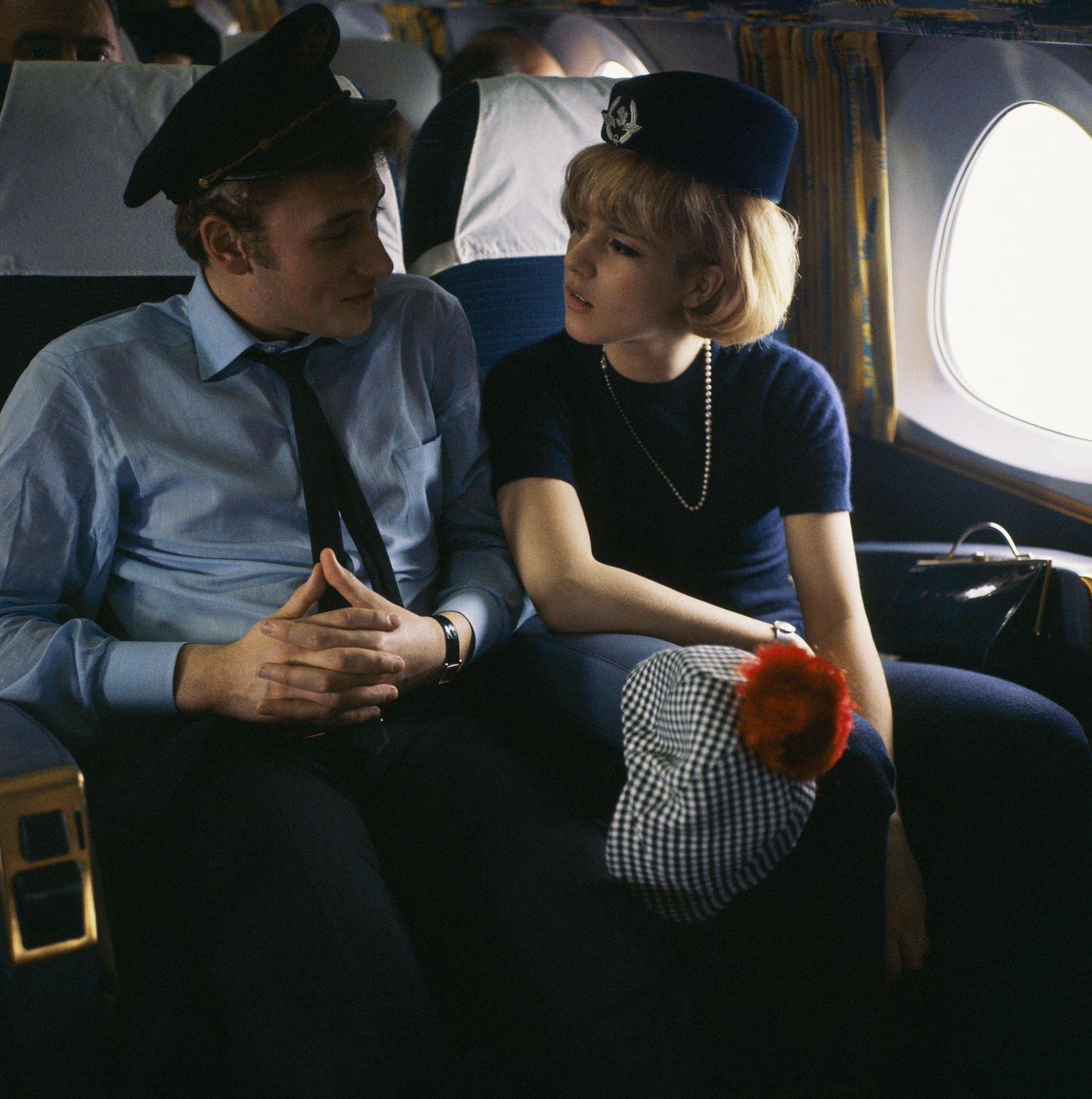
#2 First-class airline service with a chef serving food, Germany 1960s.
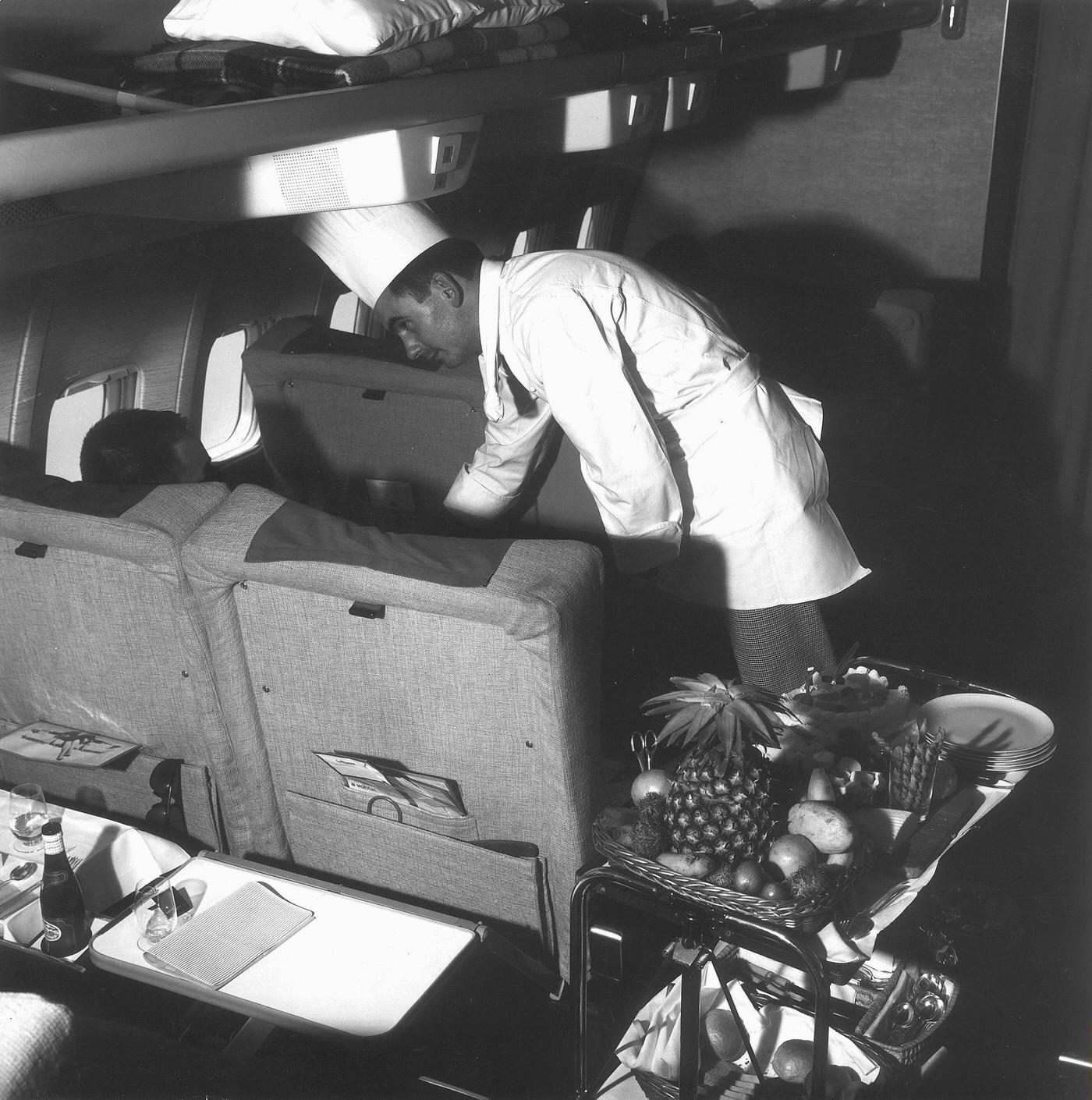
#3 Georges Pompidou smoking a cigarette with his eyes closed, sitting near a window on an airplane during his 1969 presidential campaign.
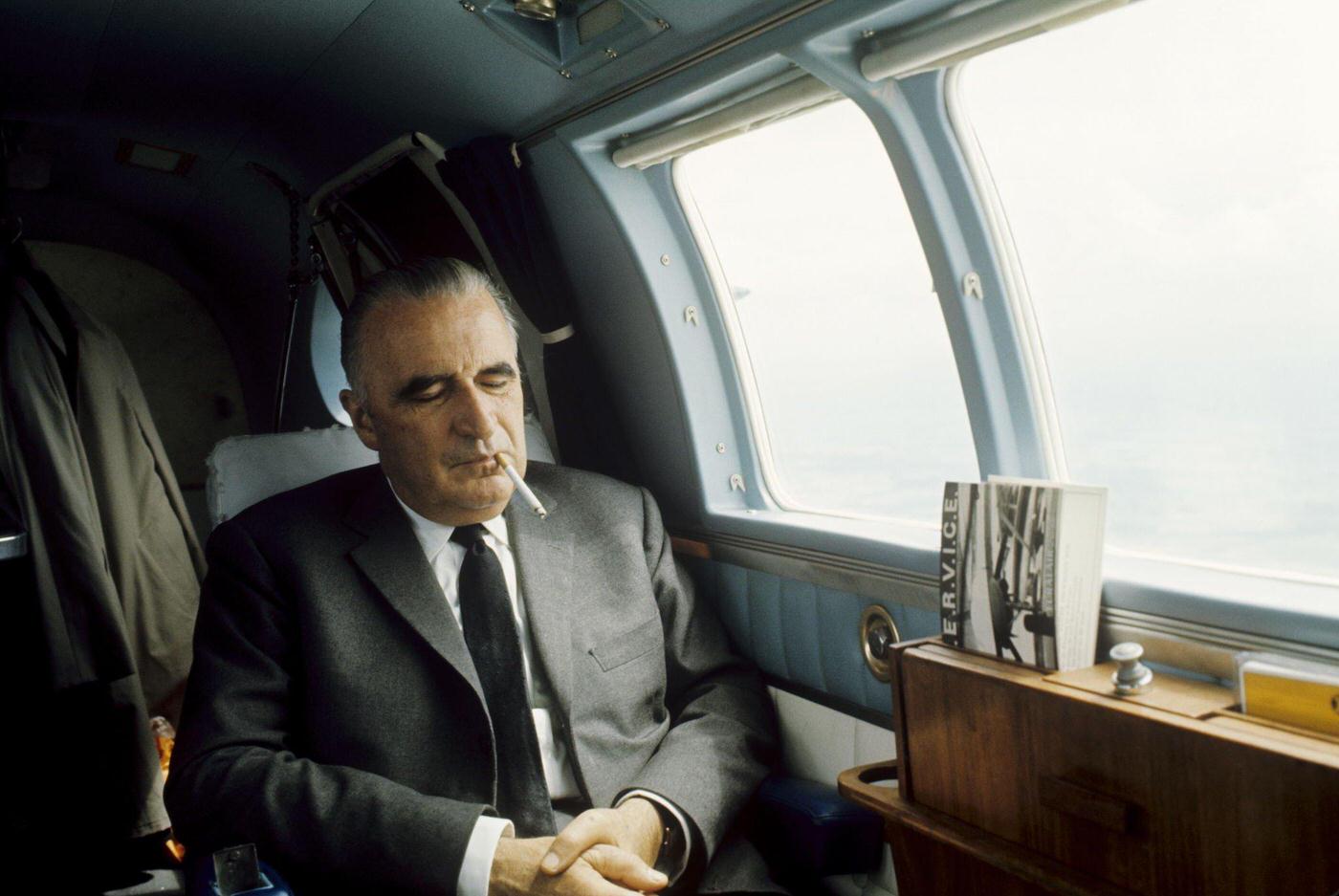
#4 Sheila smiling next to the pilot of an airplane that brought her from Paris to Nice for the world premiere of the film “Bang-bang” in 1967.
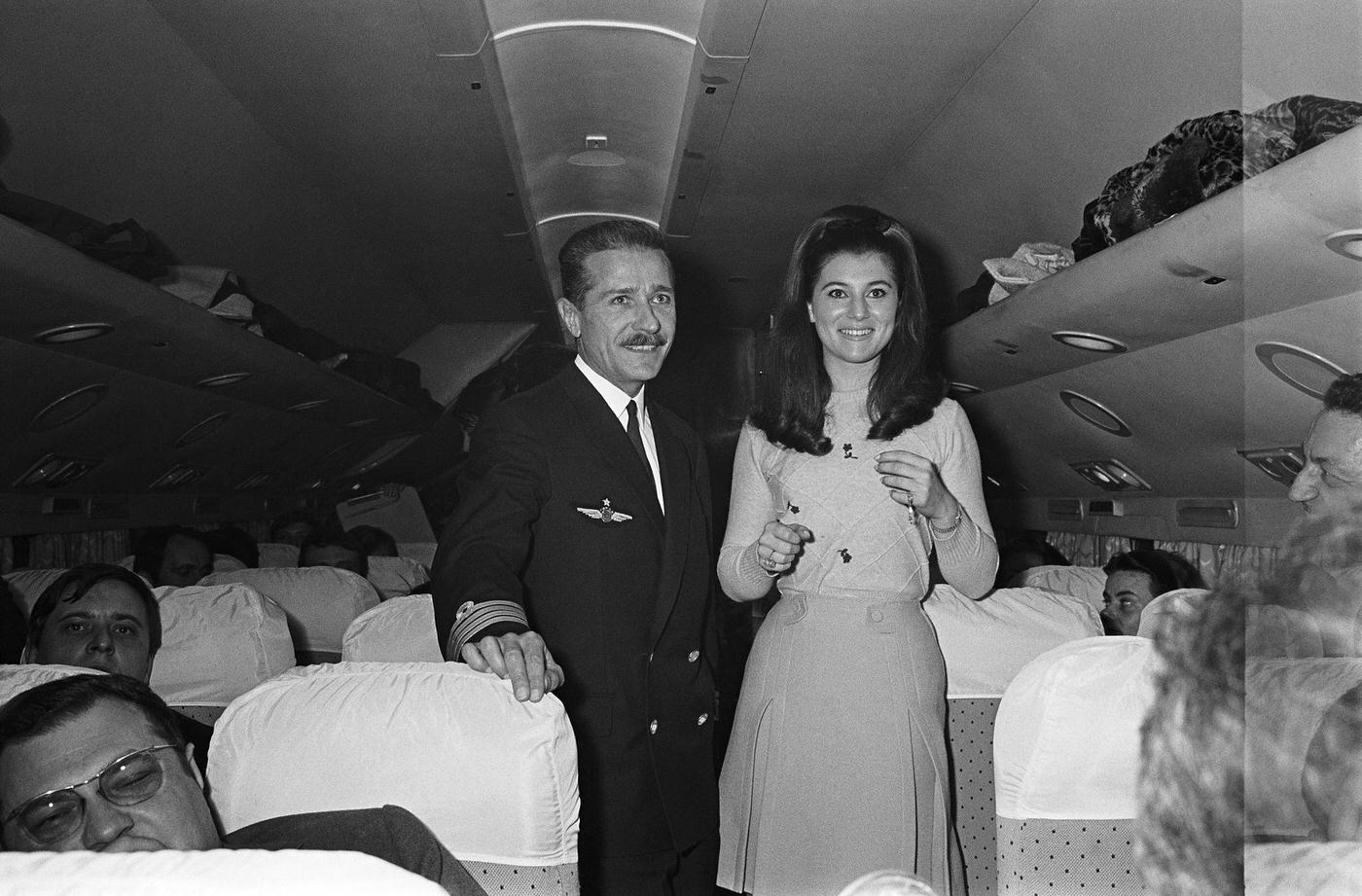
#5 Passengers sitting in a waiting area of the British Eagle International Airlines terminal at Knightsbridge Air Terminal, London, 1960
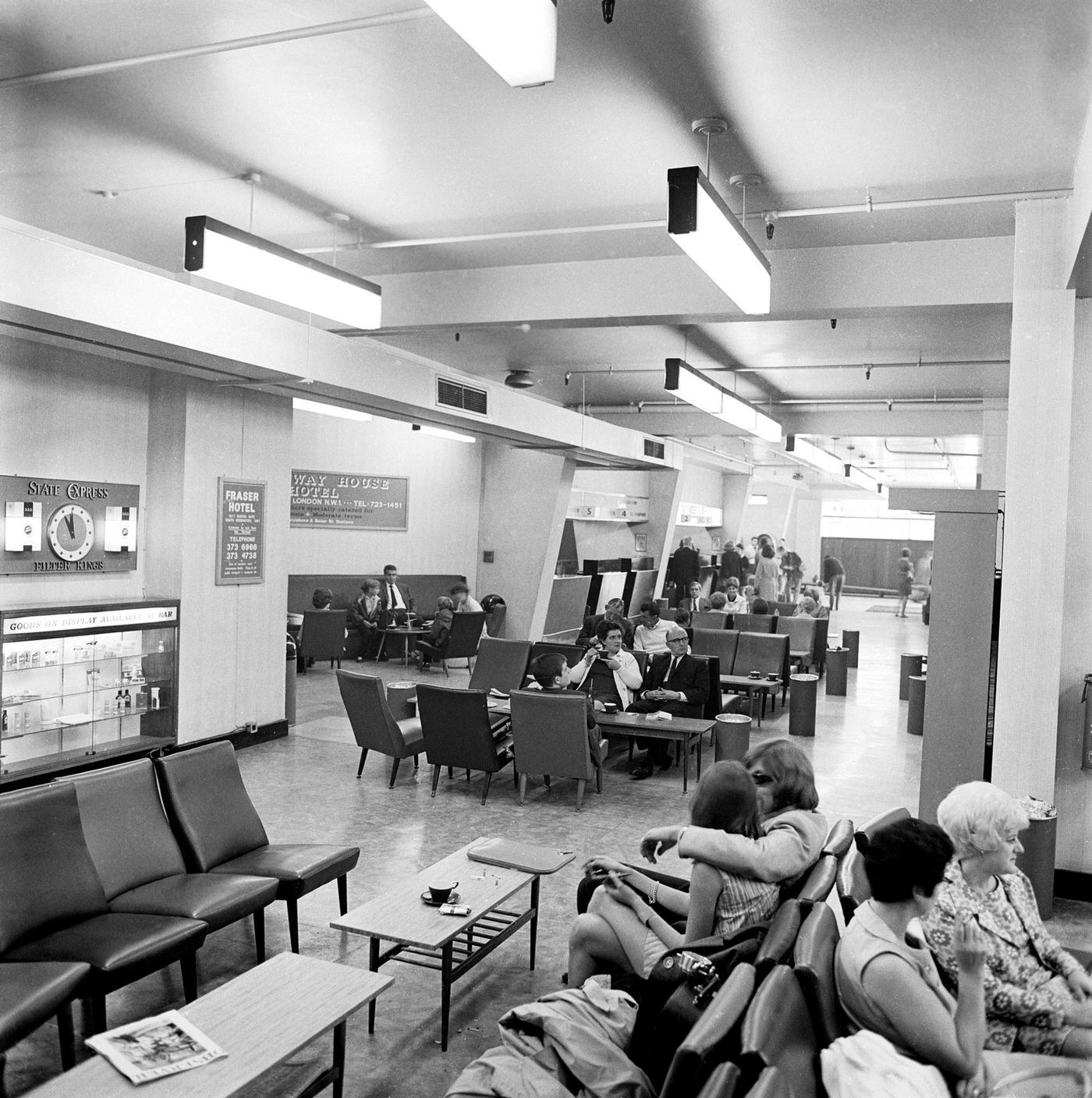
#6 Passengers and flight attendants inside a mock-up interior of a Lockheed L-1011 TriStar passenger aircraft during its development work and design in the United States in 1968.
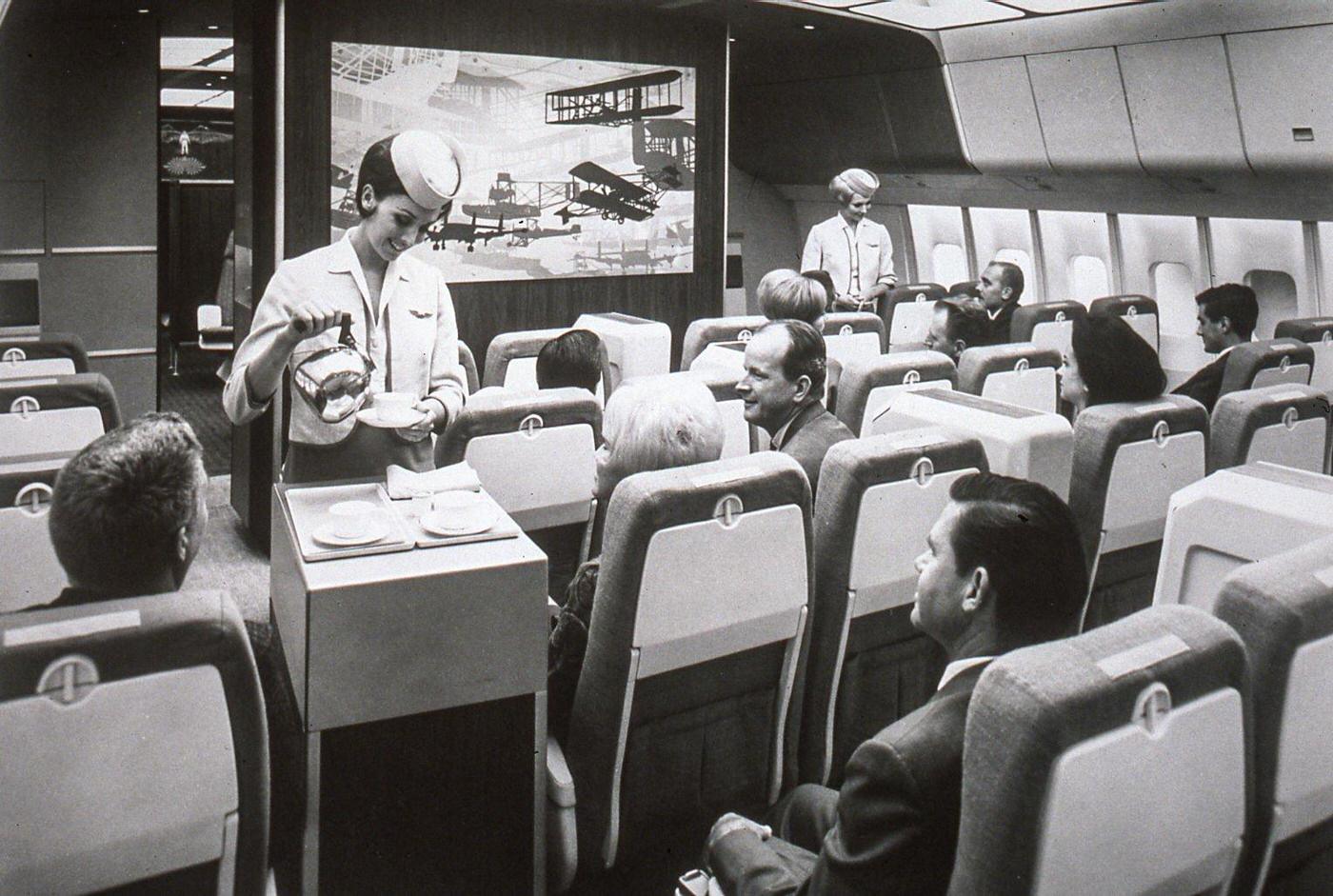
#7 Actors from the Teatro alla Scala company relaxing by chatting and playing chess during air travel in September 1964.
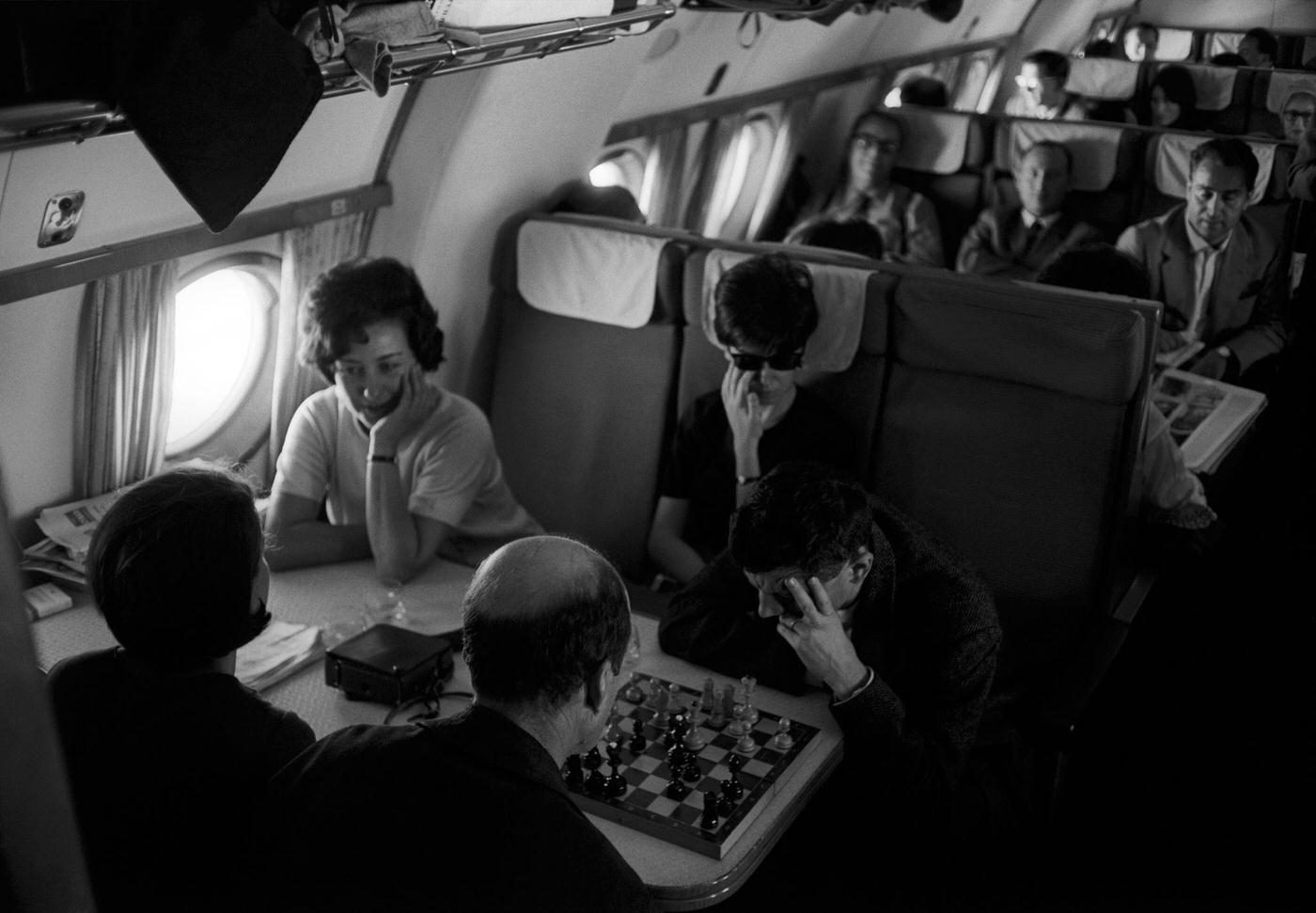
#8 Eighty Greek passengers who left on a Lufthansa Jet for Athens in April 1967 may not reach their destination due to the airport being closed to all traffic.
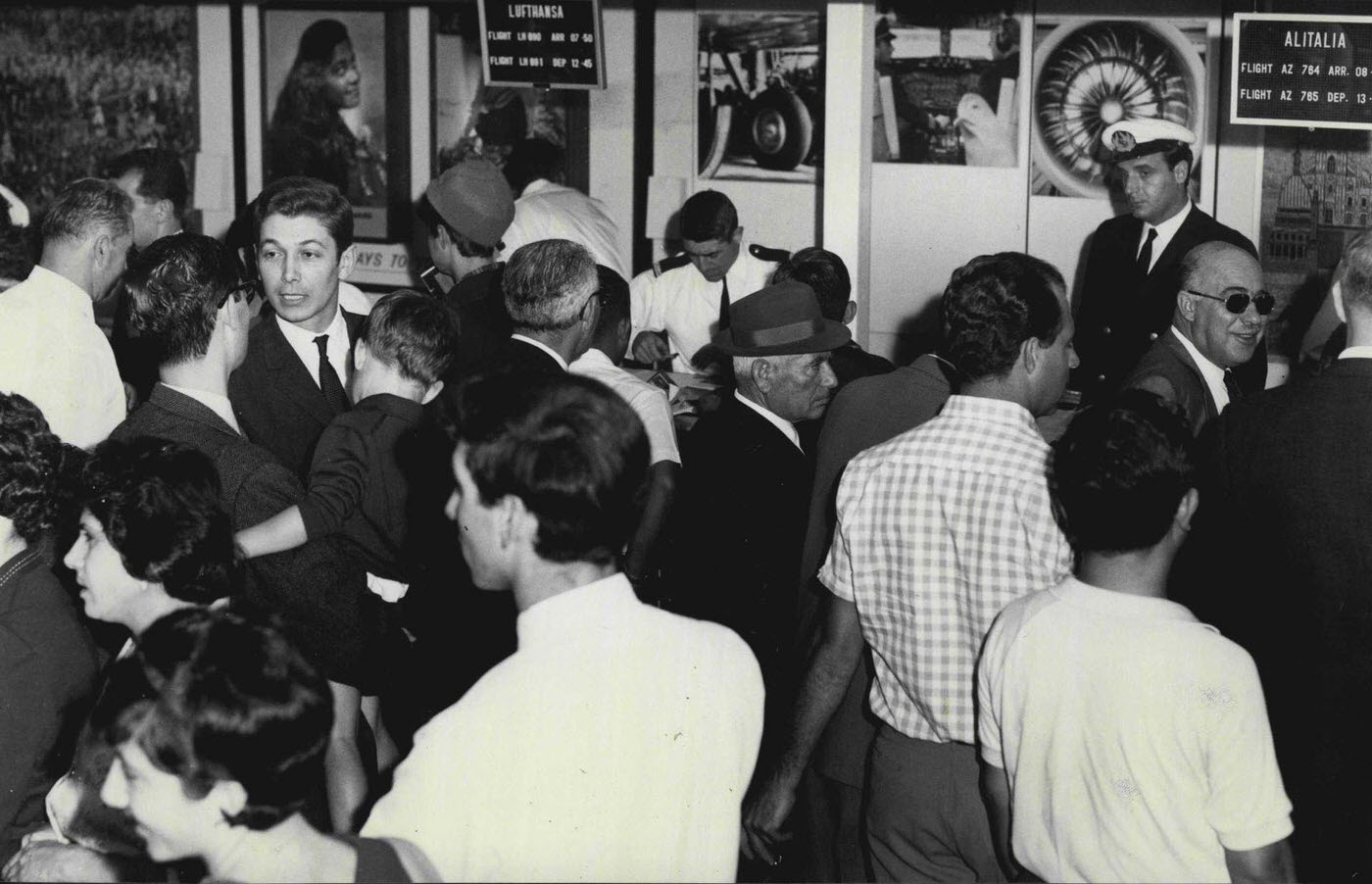
#9 Brigitte Bardot playing cards on a flight from New York to Los Angeles in December 1965.
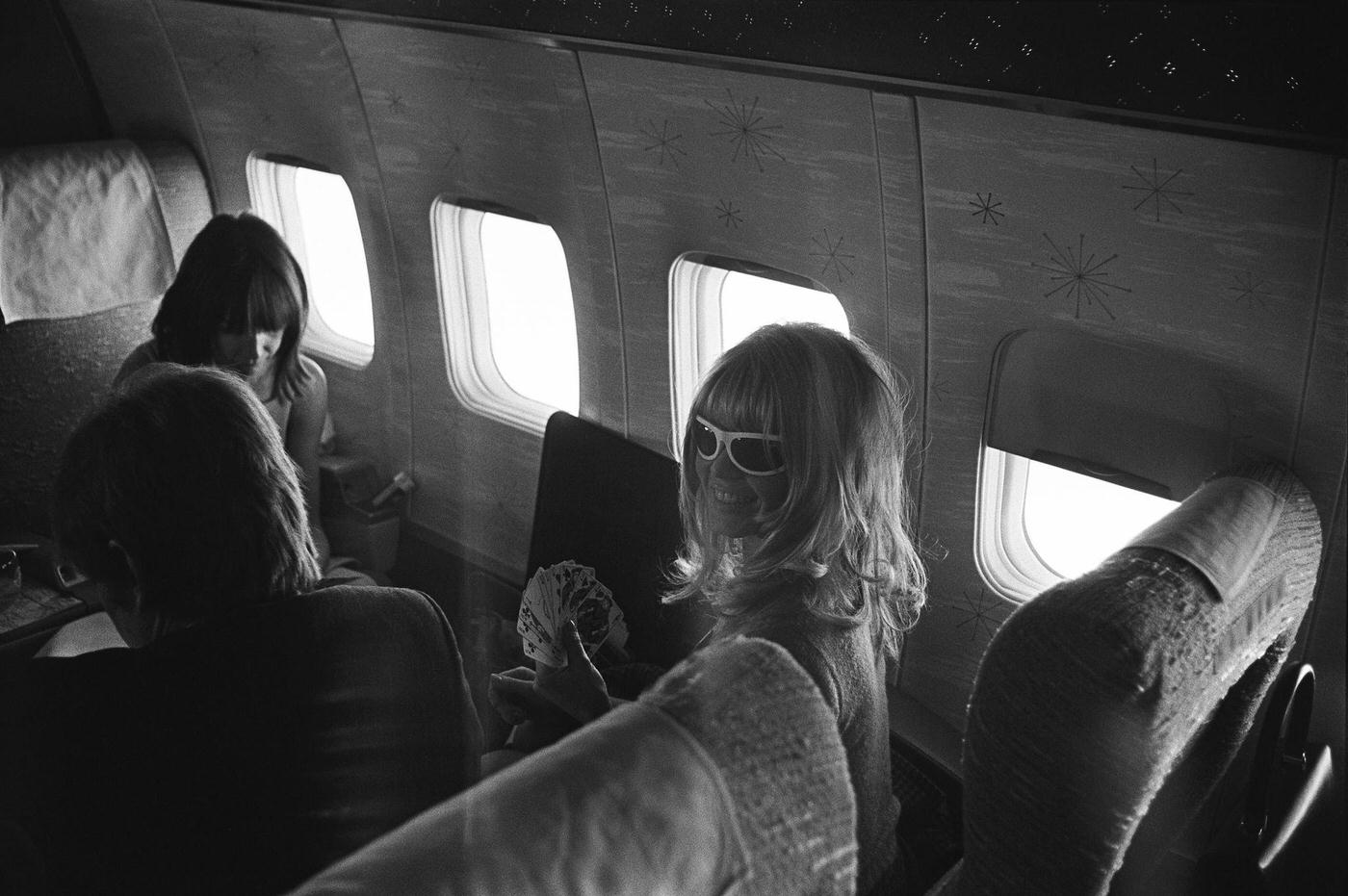
#10 A woman on a plane in 1960.
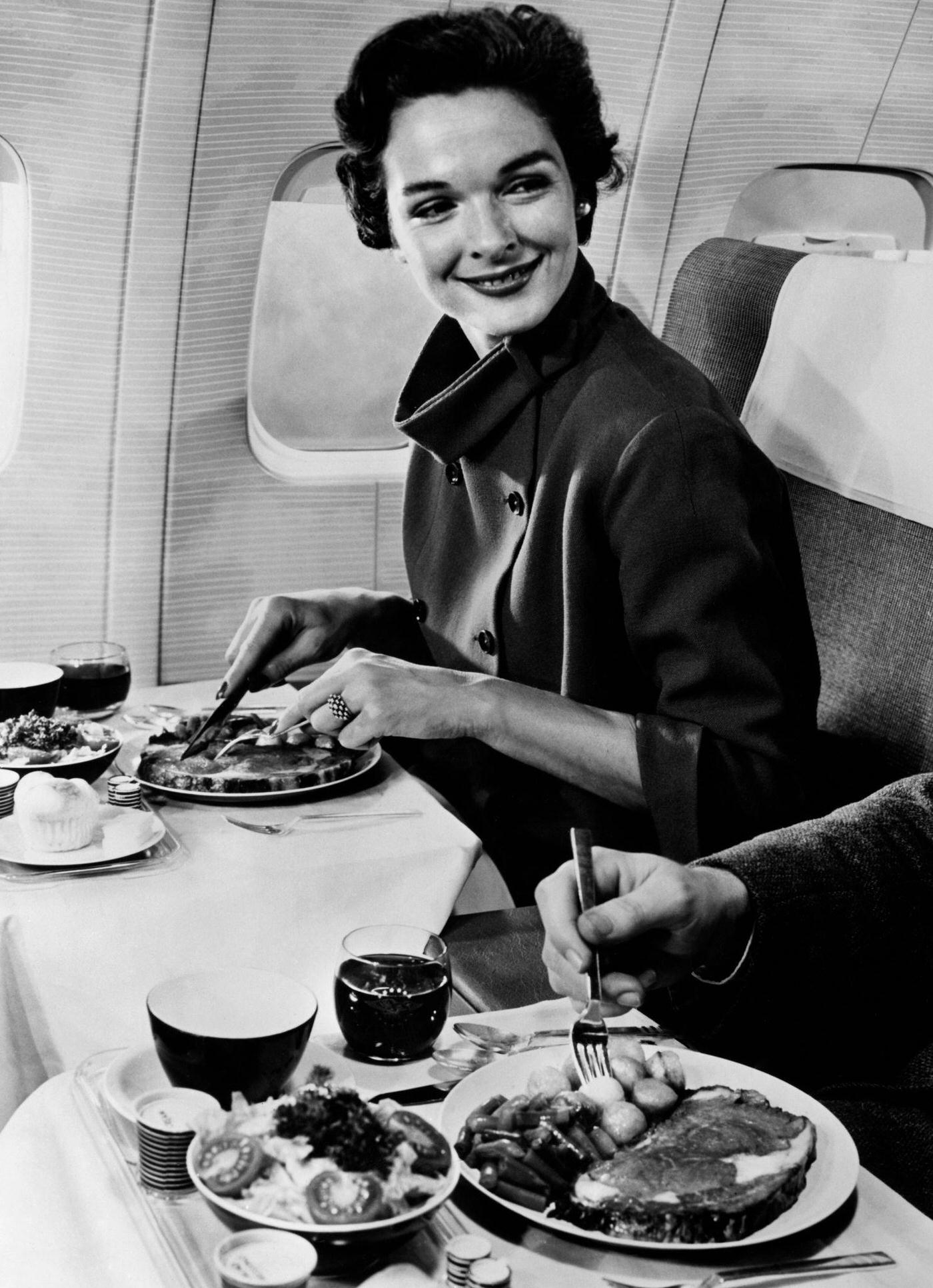
#11 Overseas airline passengers waiting to be cleared by the U.S. Customs Department at Logan Airport in Boston in May 1961.
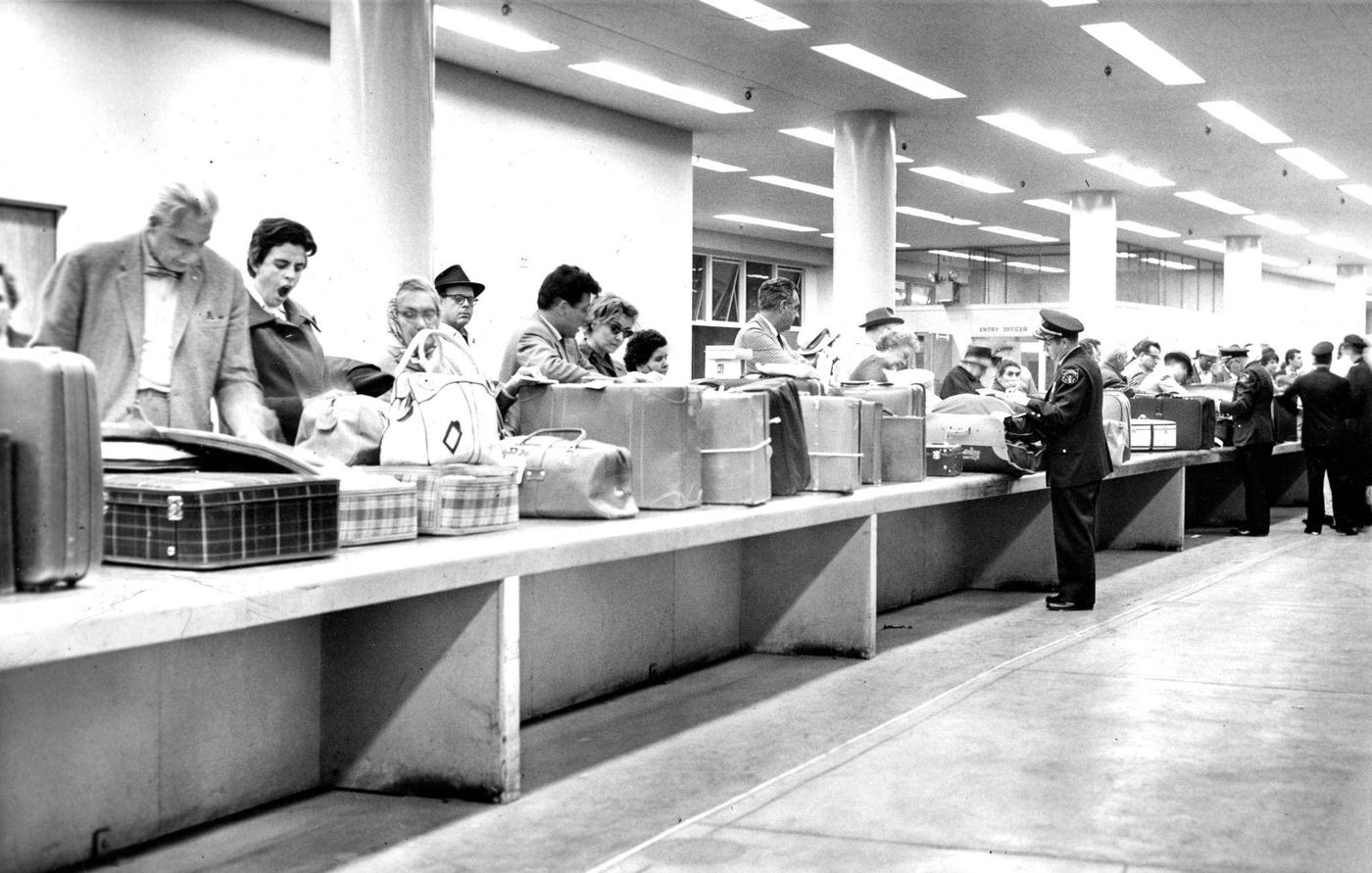
#12 Members of The Beatles on board a plane bound for Paris in January 1964, left to right: manager Brian Epstein, Paul McCartney, John Lennon, and George Harrison.
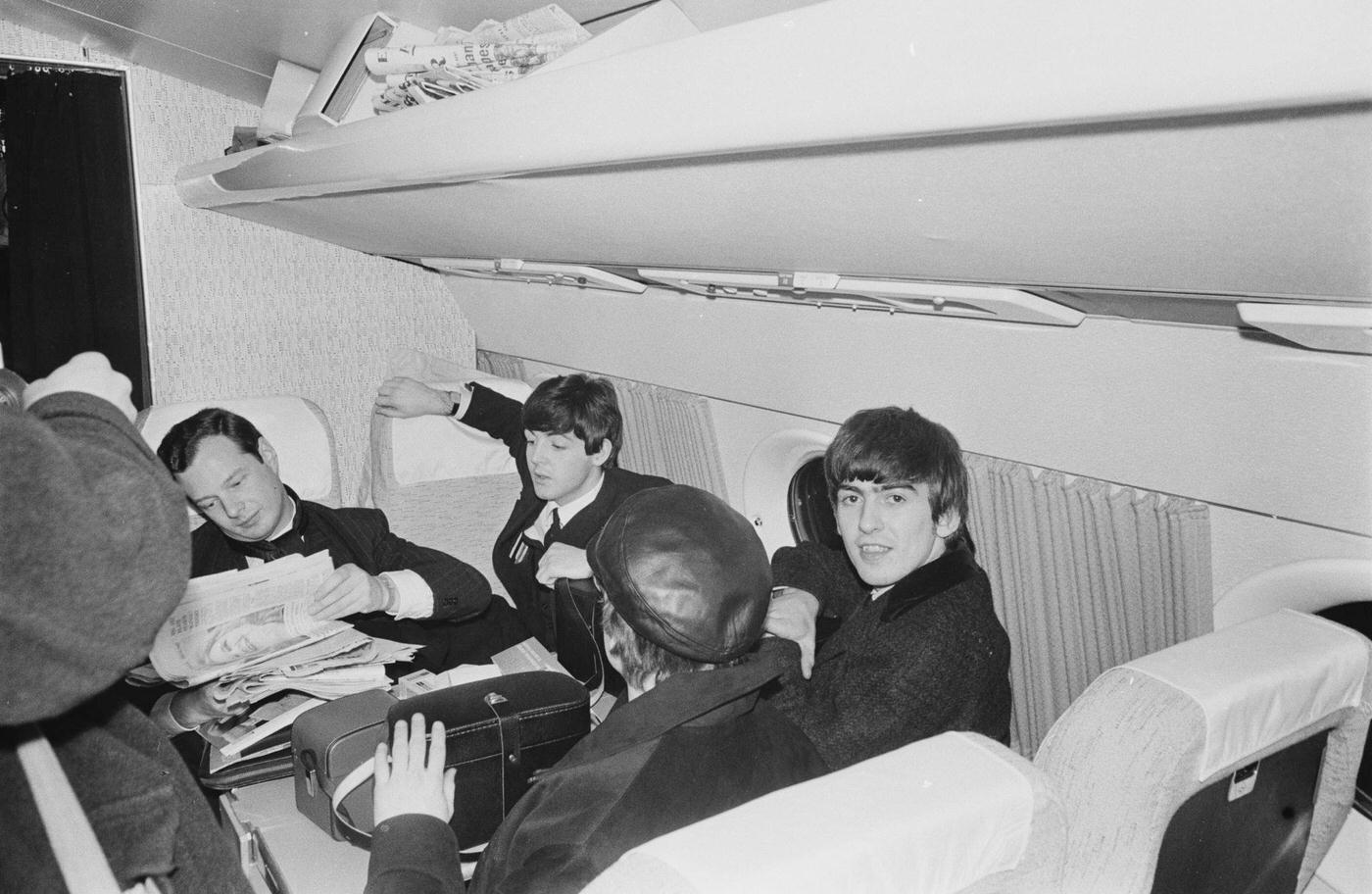
#13 Passengers sitting in one of the living rooms of a tourist class Boeing 747 during the 28th Paris Air Show at Le Bourget in 1969.
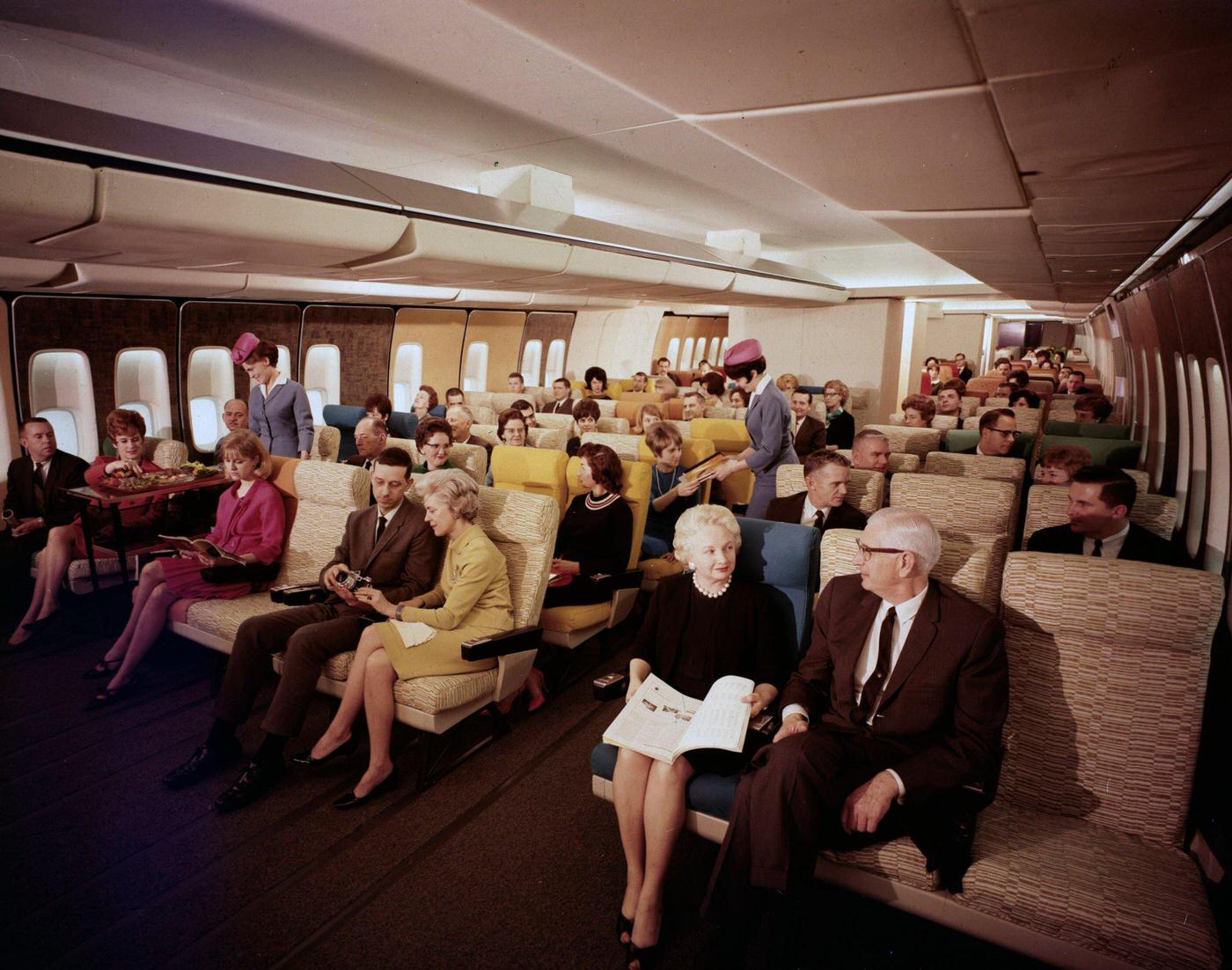
#14 Brigitte Bardot in a Boeing airplane during a flight from New York to Los Angeles in December 1965.
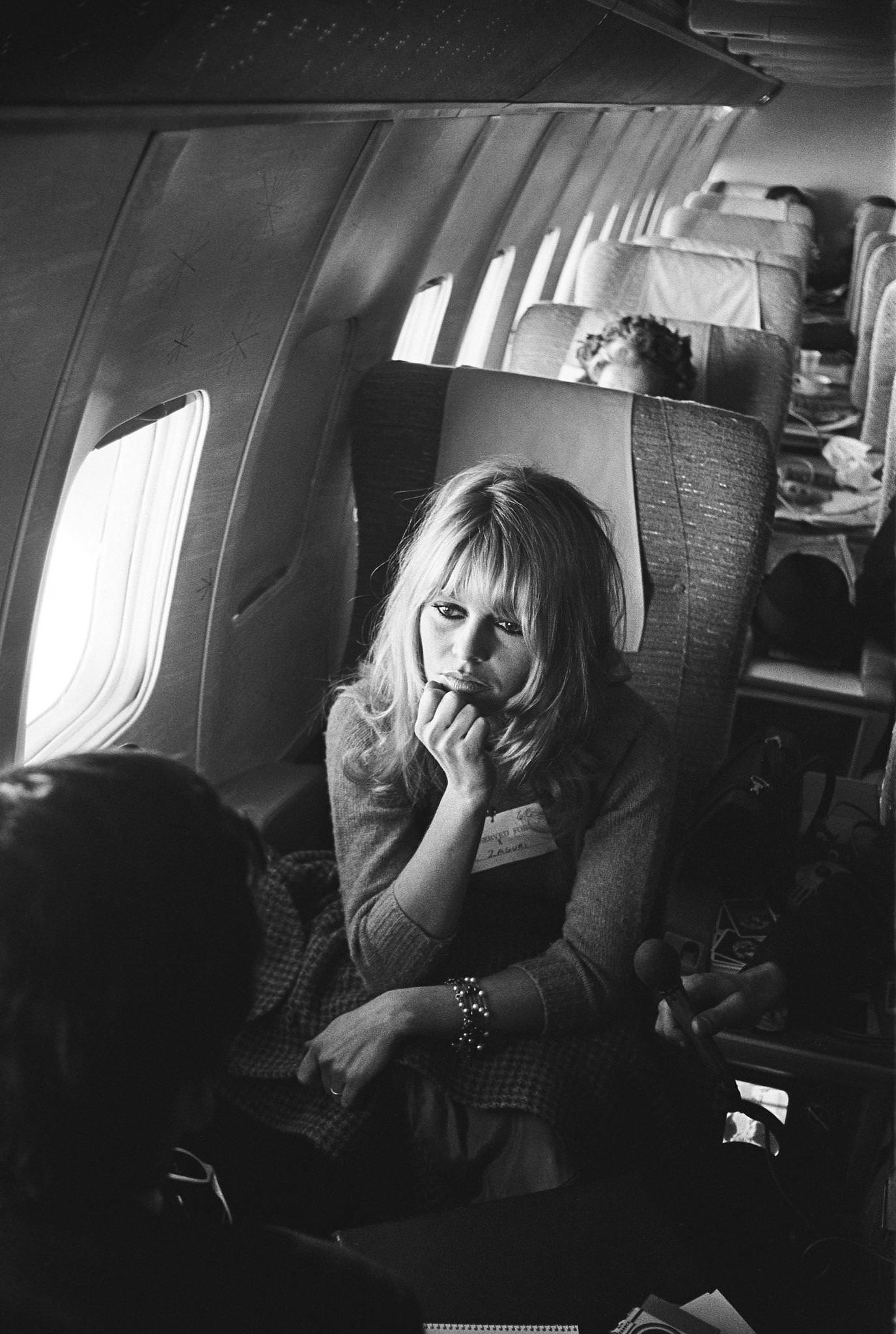
#15 Passengers on a jumbo jet in 1960.
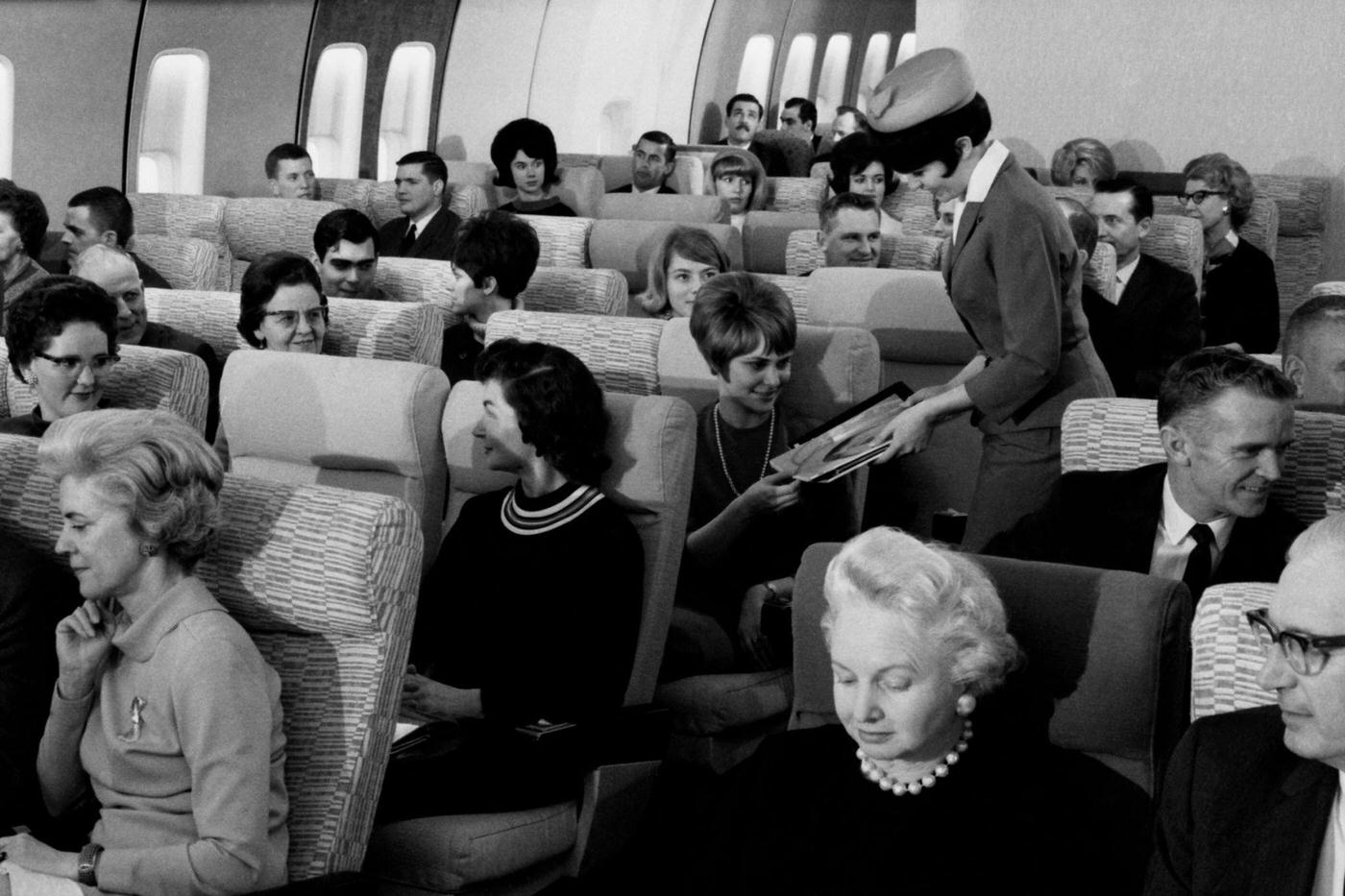
#16 William Sylvester unconscious and Angela Lovell standing in a lobby card for the movie “The Hand of Night” (aka “Beast of Morocco”) in 1968.
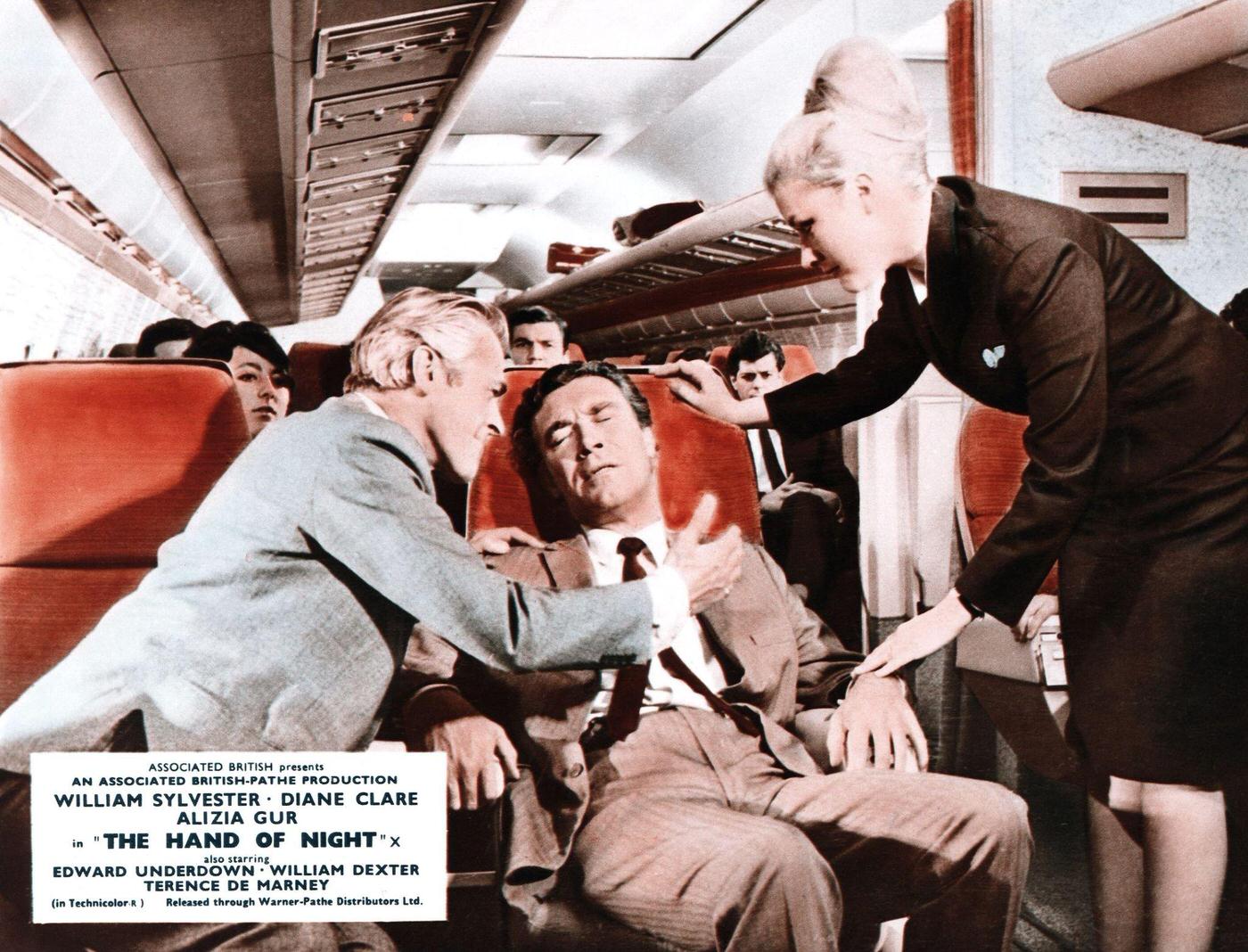
#17 A couple on a British Overseas Airways Corporation plane in 1960.
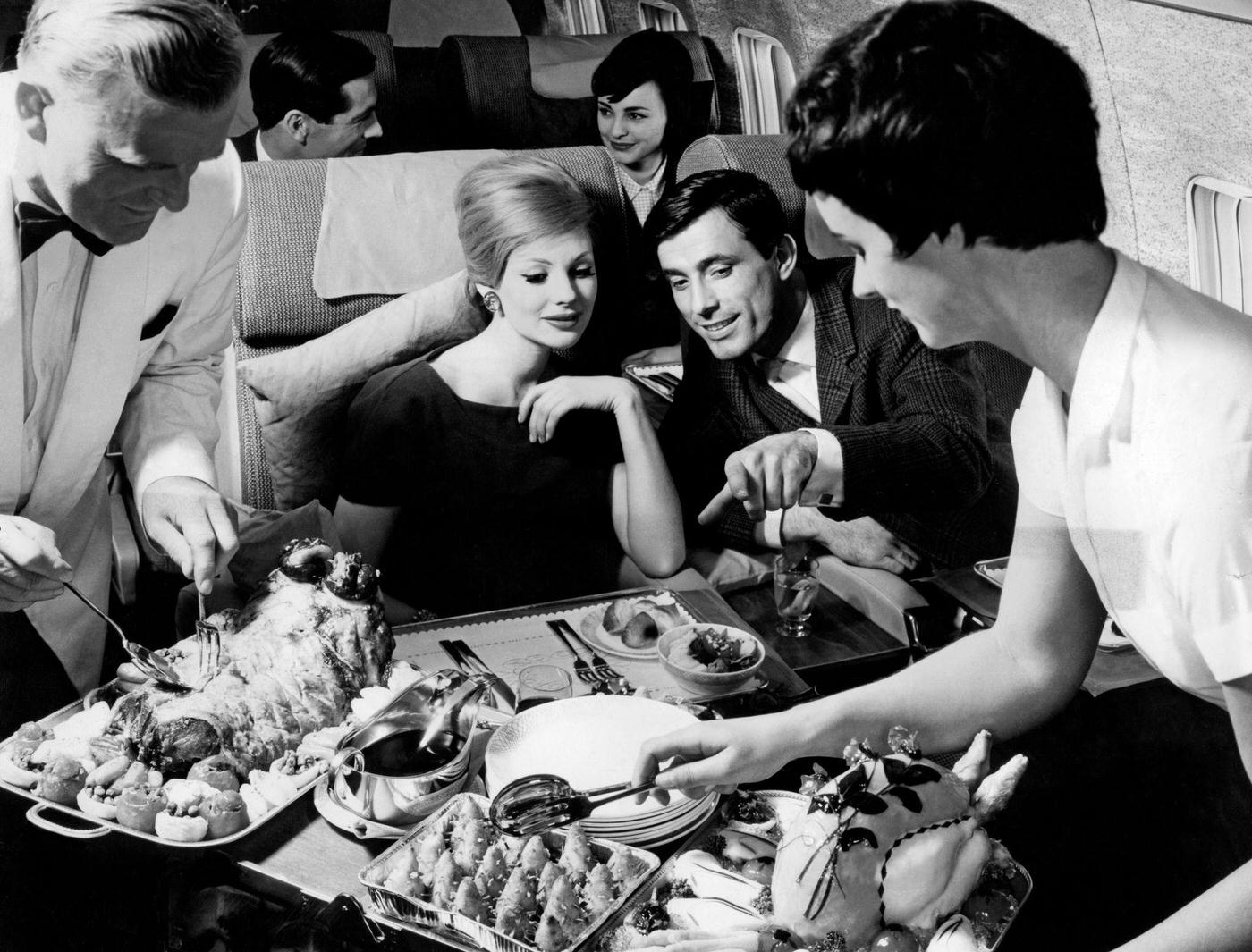
#18 A model of an Air France Boeing 747 Jumbo Jet interior with passengers in 1966.
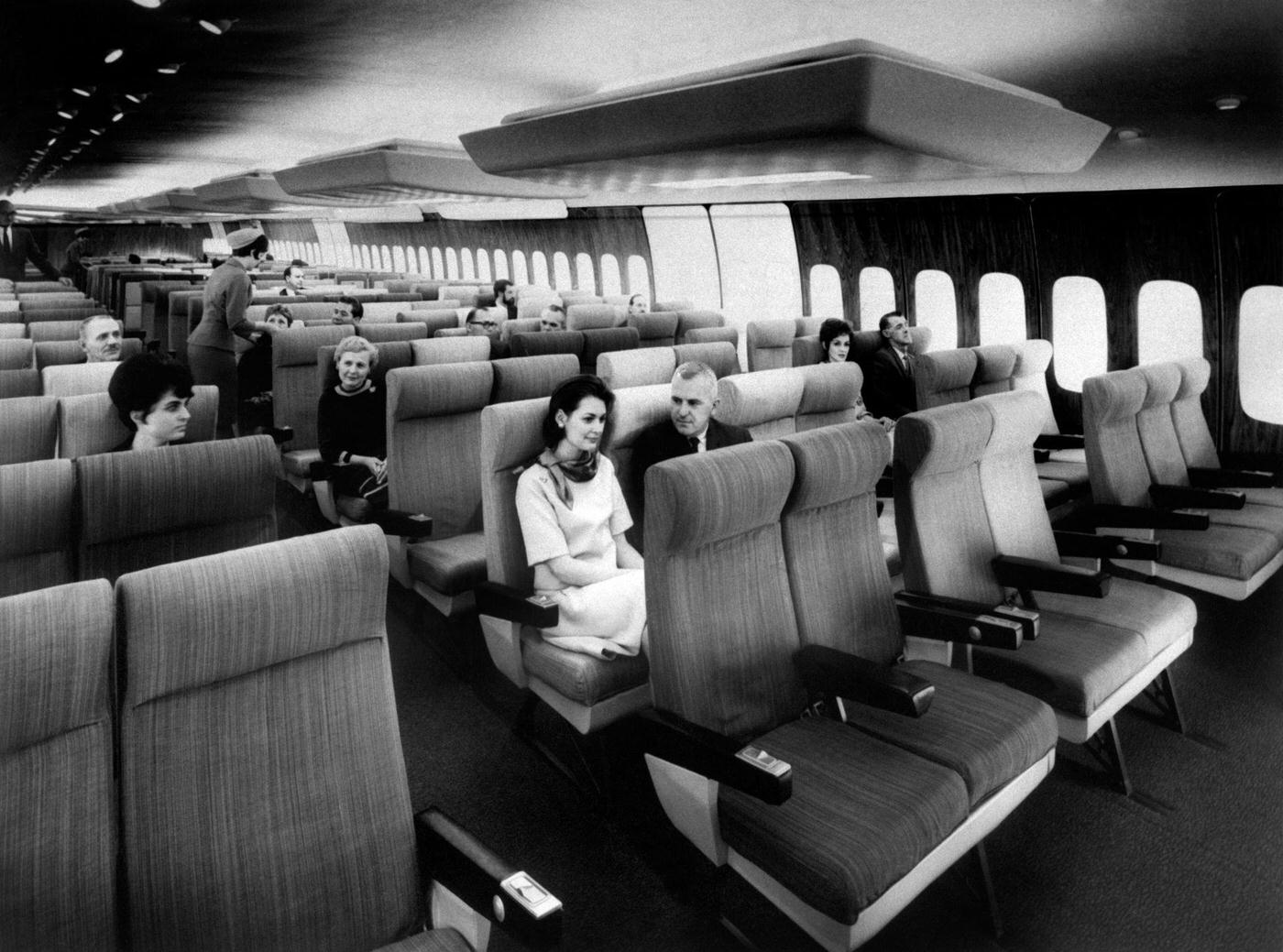
#19 A US soldier wounded during the Vietnam War receiving an emergency blood transfusion on board a medical helicopter.
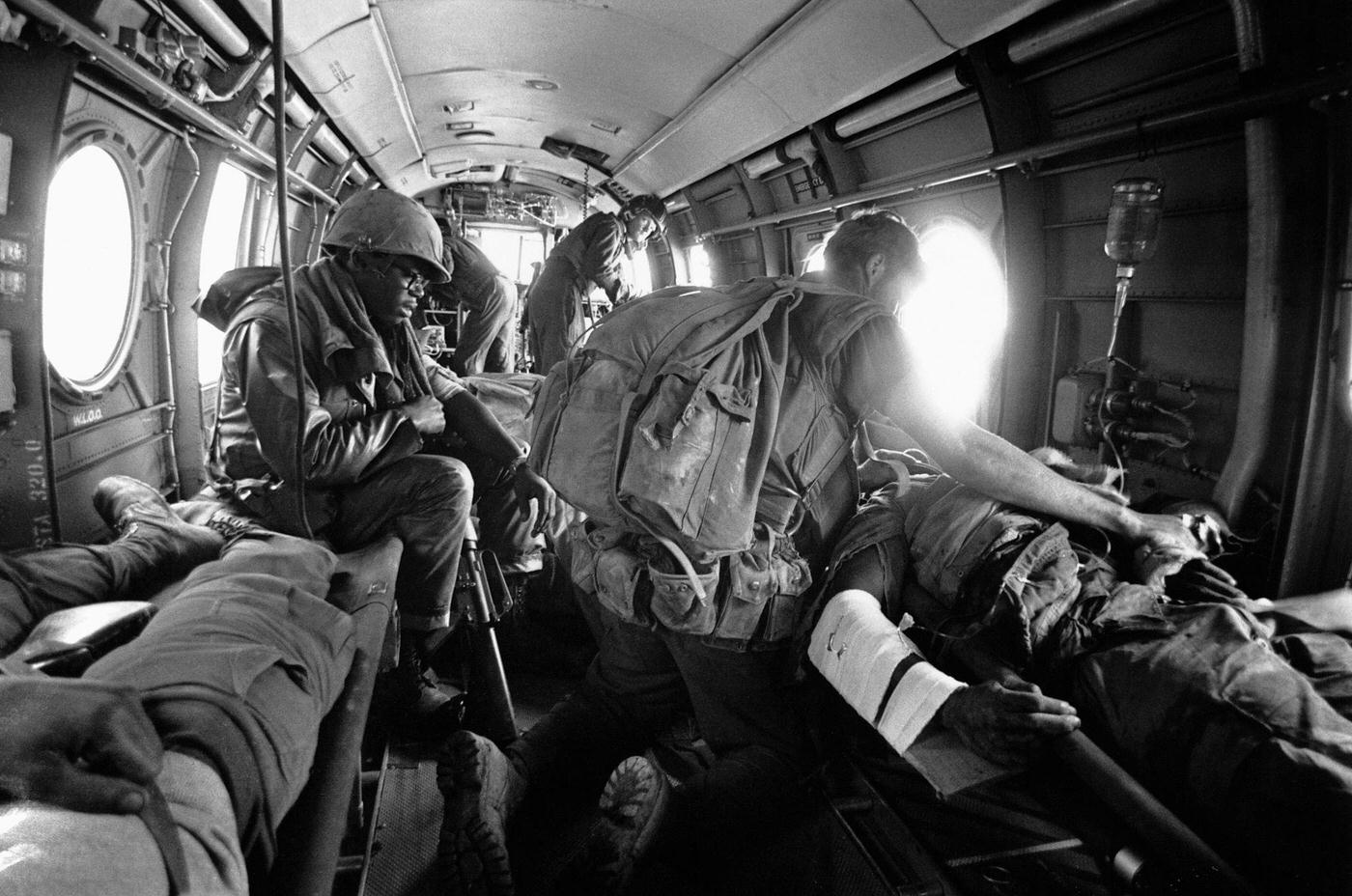
#20 Passengers sitting and relaxing in the mock-up cabin of a Lockheed L-1011 TriStar in Burbank, California, in 1967.
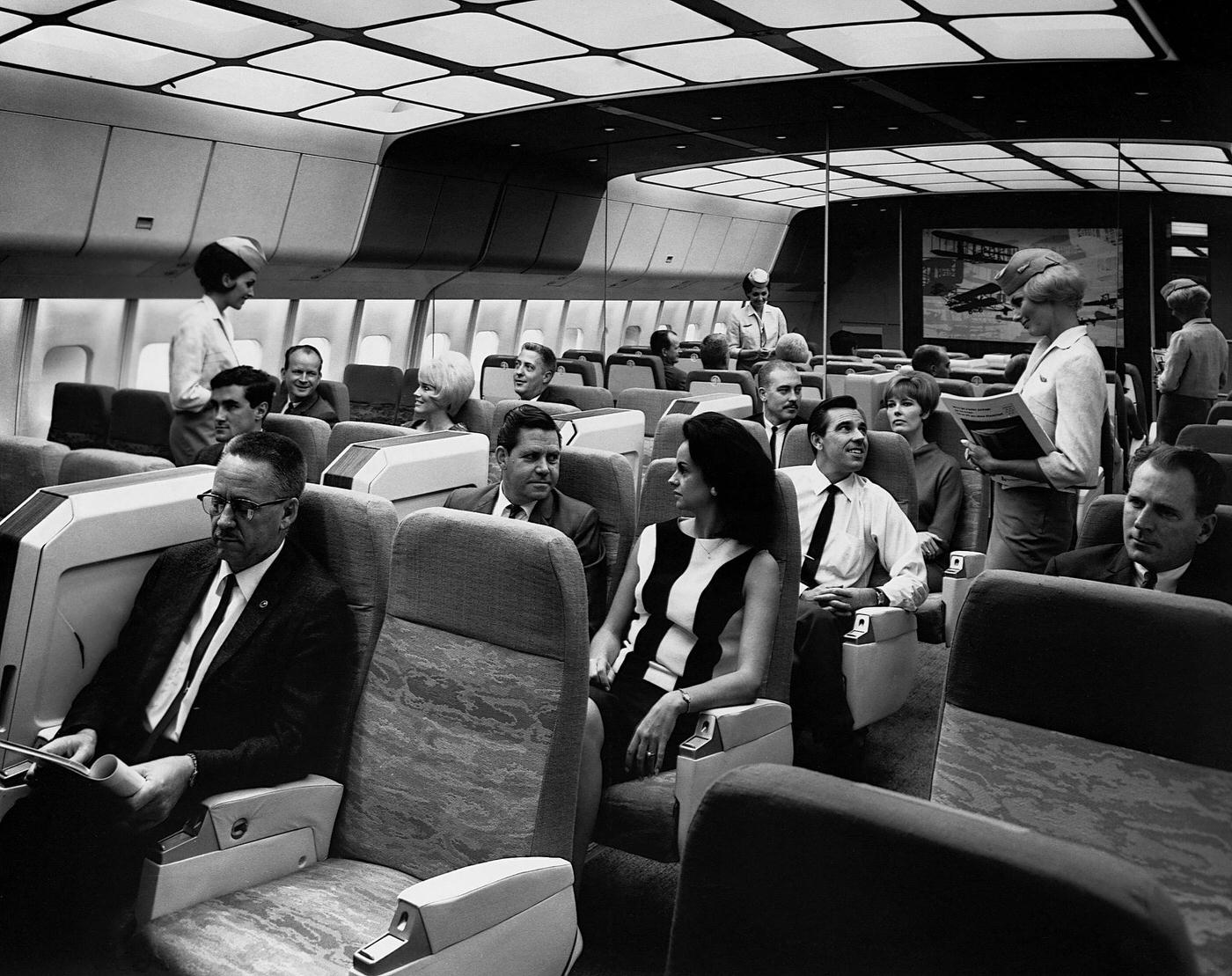
#21 Bodies of the passengers of the Aer Lingus Viscount plane crash being brought ashore in County Wexford on March 24, 1968.
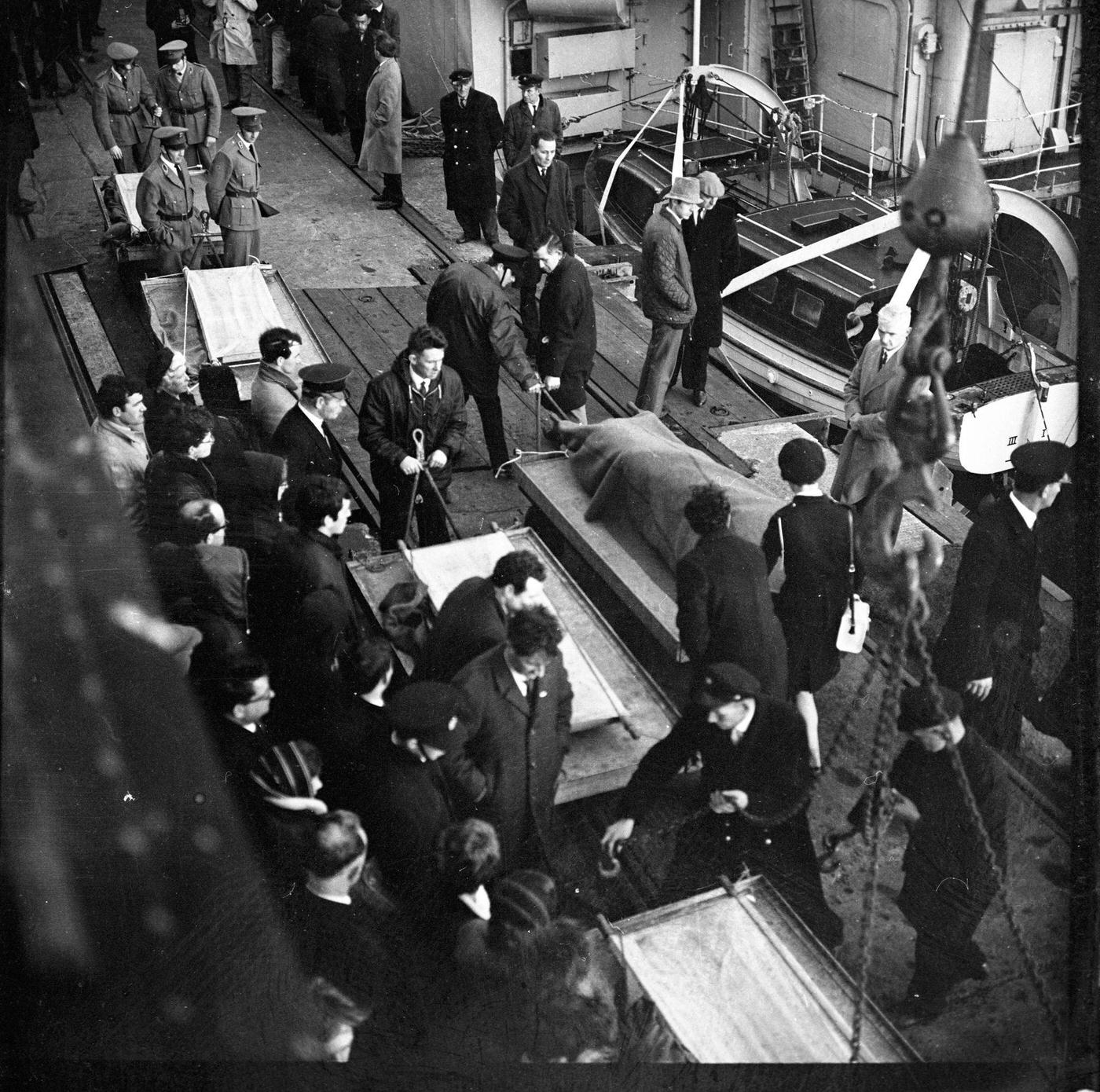
#22 Passengers and flight attendants inside a mock-up interior of a Lockheed L-1011 TriStar passenger aircraft during its development work and design in the United States in 1968.
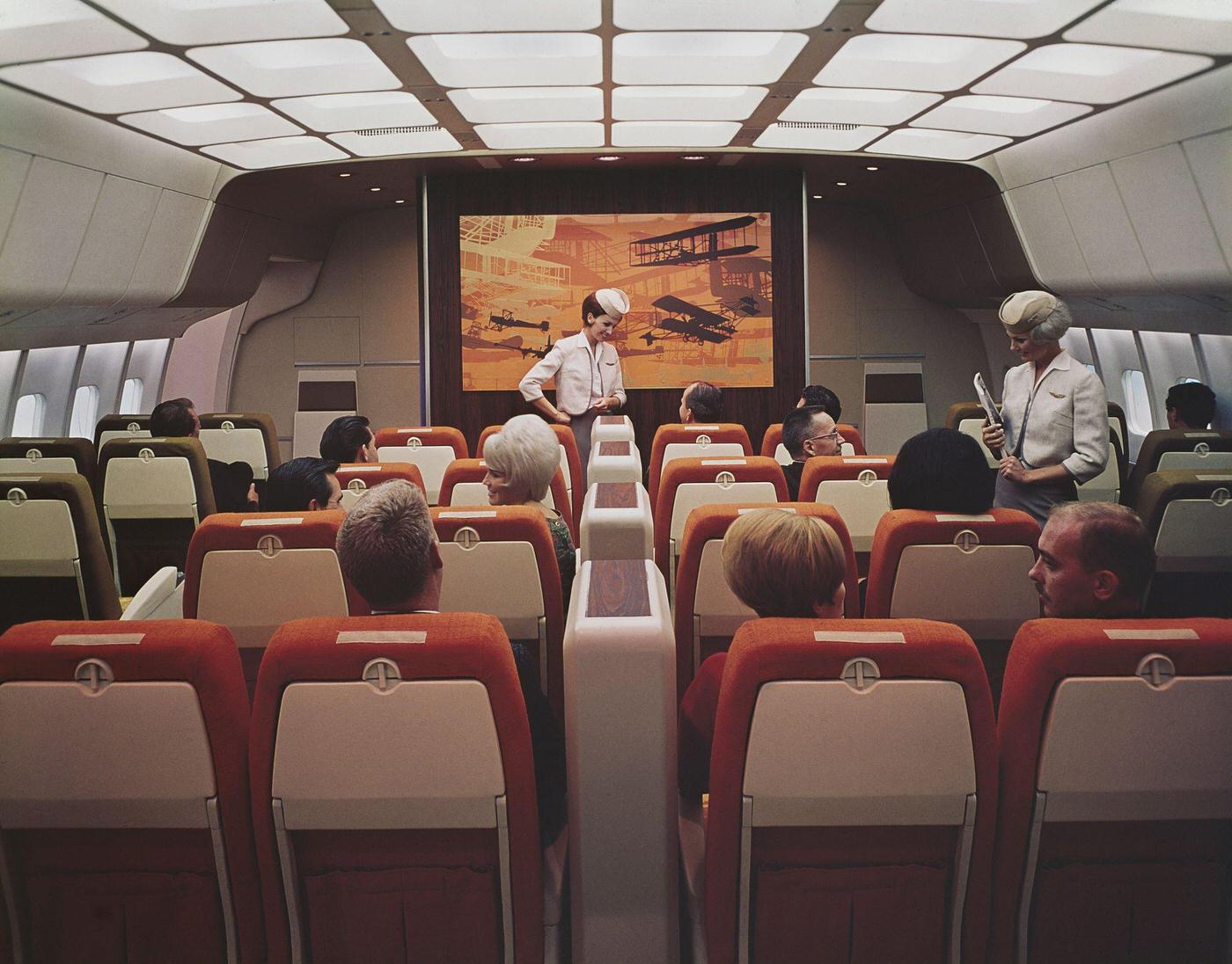
#23 John F. Kennedy resting in the passenger cabin of an airplane during his 1960 campaign.
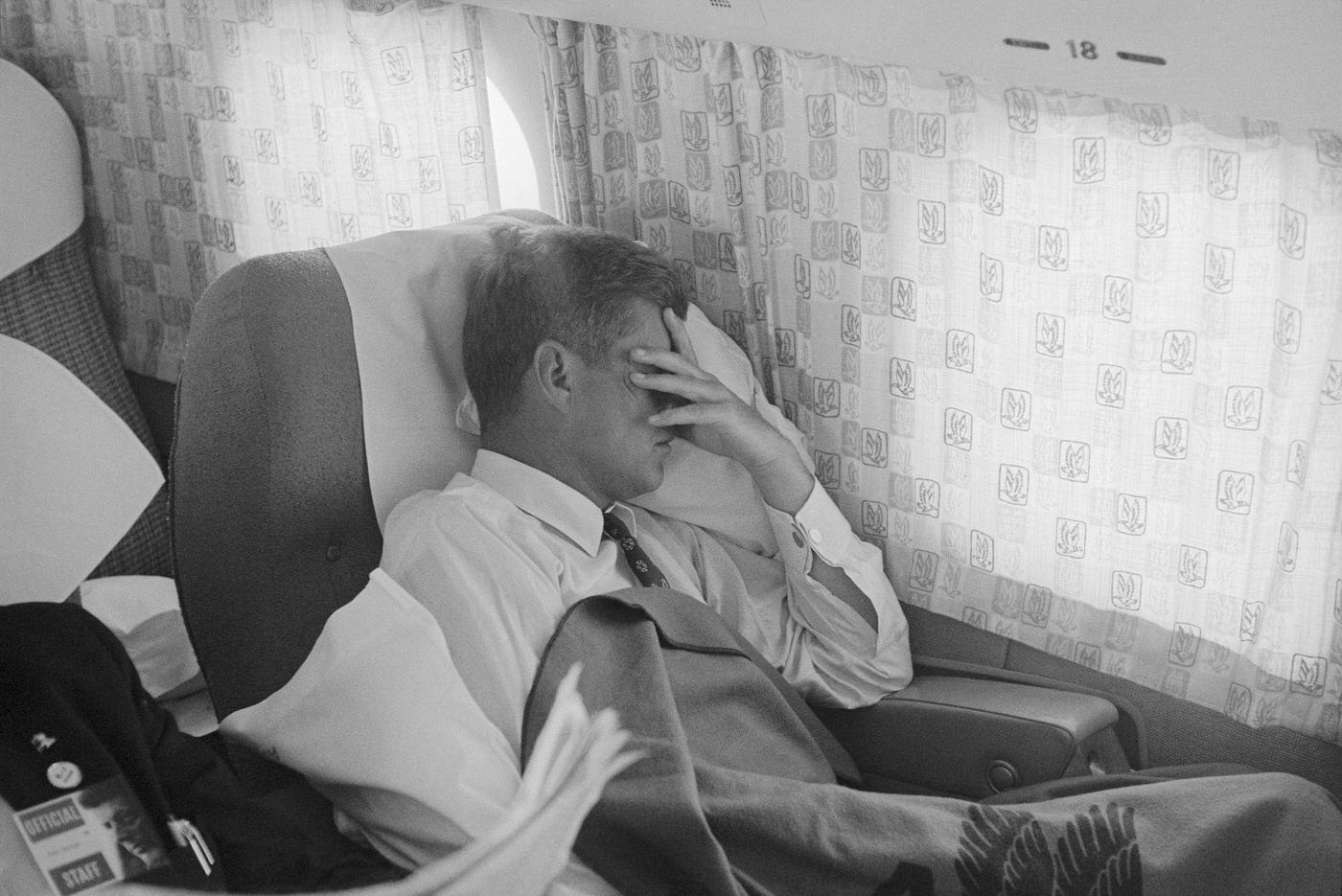
#24 Sheila Hancock playing the role of an air hostess in scenes being shot for the comedy series “The Bed-Sit Girl” at BBC Studios on February 21, 1965.
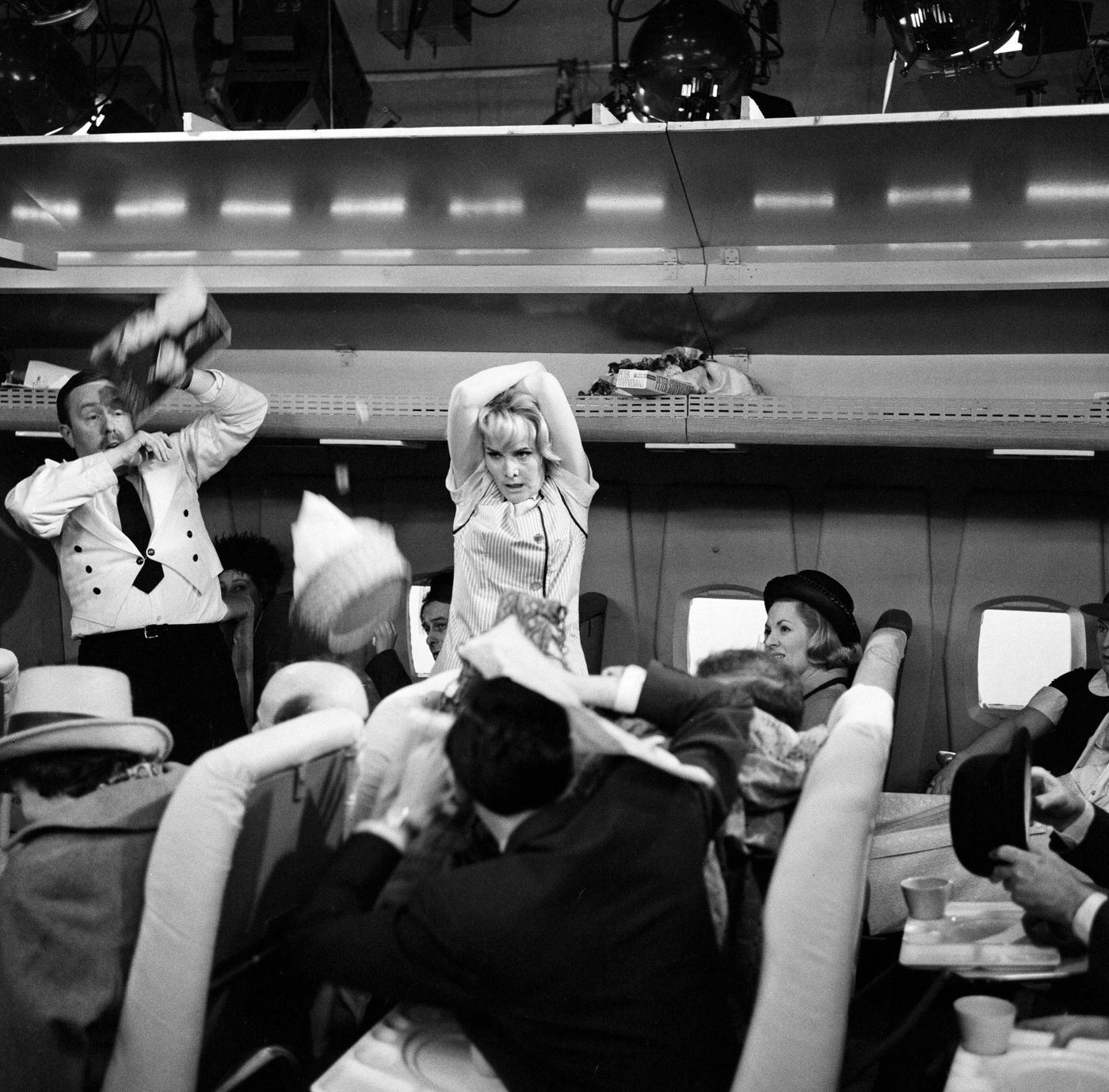
#25 Mrs. James Webb, wife of a passenger on a Continental Airlines jet that crashed over Unionville, sitting with her children.
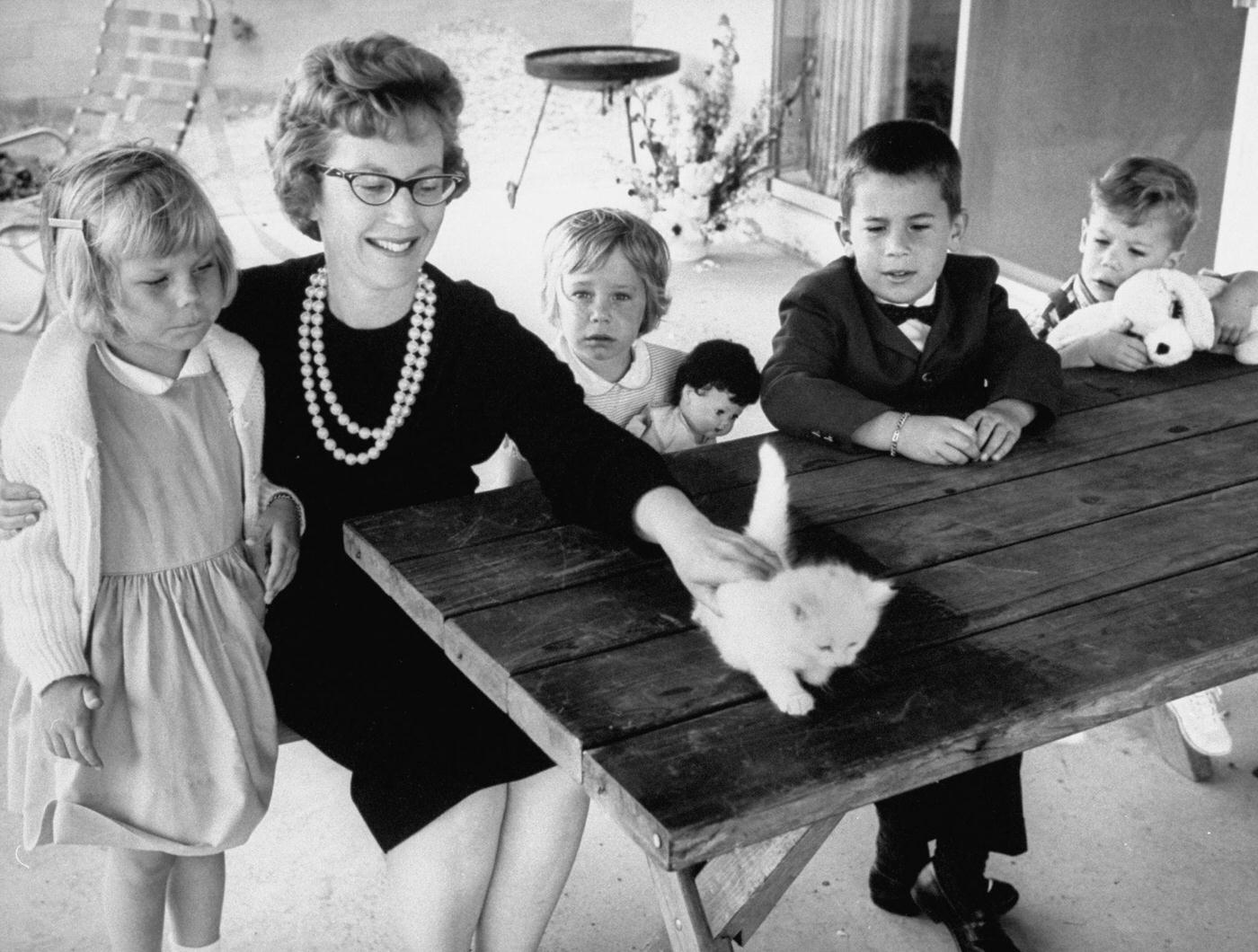
#26 Sheila Hancock playing the role of an air hostess in scenes being shot for the comedy series “The Bed-Sit Girl” at BBC Studios on February 21, 1965.
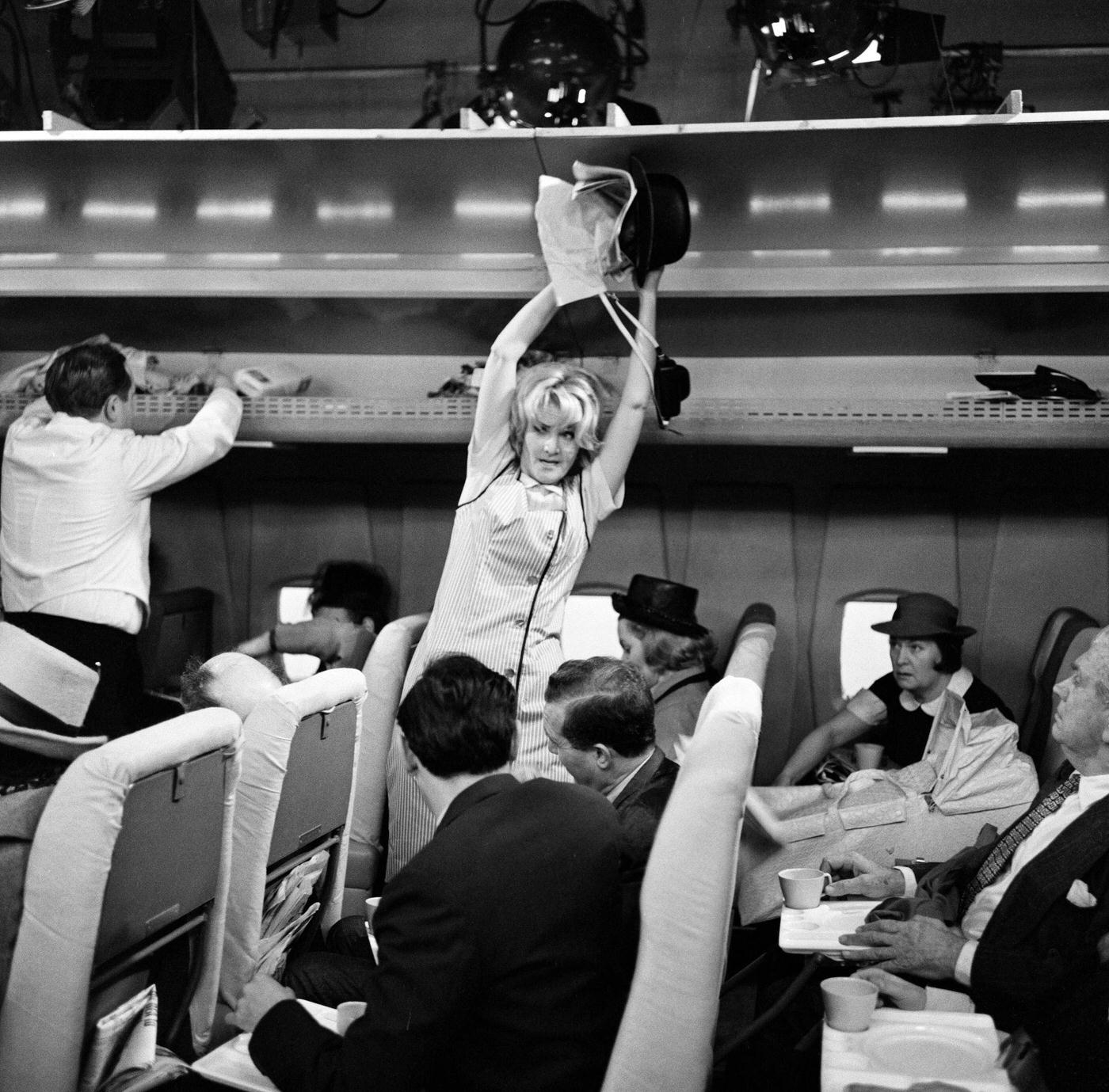
#27 President Lyndon Johnson’s grandson, Patrick Lyndon, typing on a typewriter with journalist Helen Thomas on Air Force One during a flight to New York City in the 1960s.
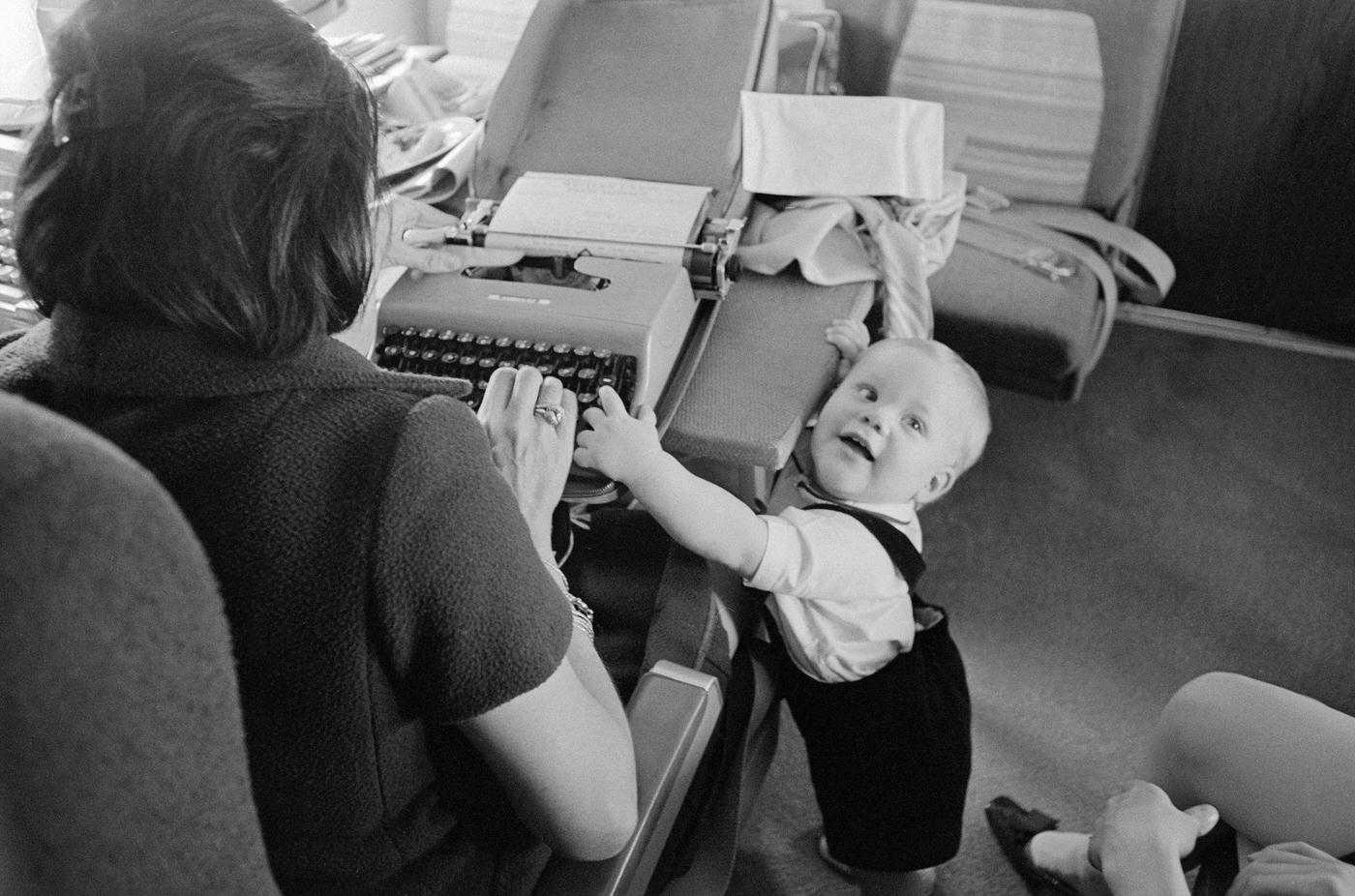
#28 Anita Ekberg playing glamorous movie star Sylvia in Federico Fellini’s “La Dolce Vita” in 1960.
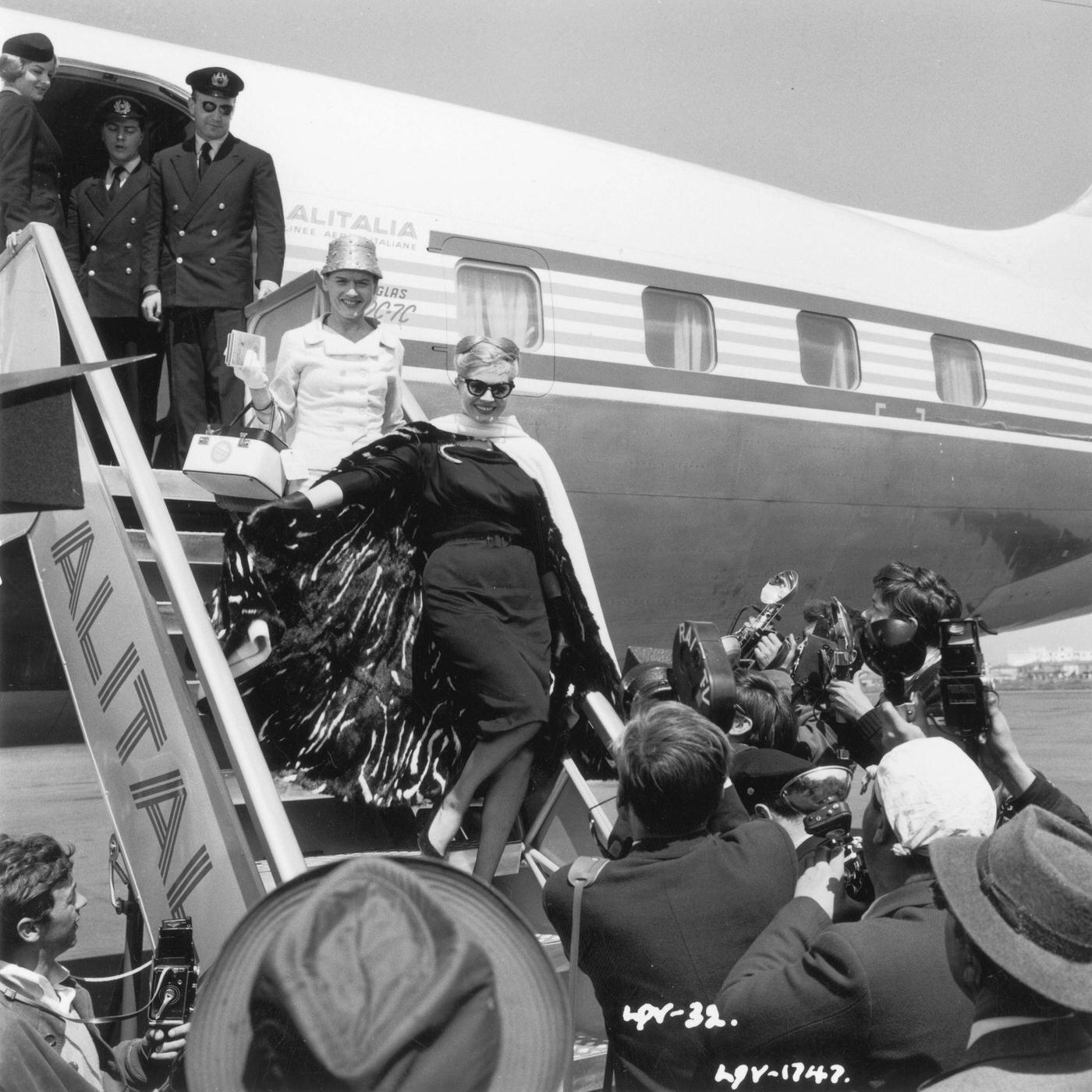
#29 Sheila Hancock playing the role of an air hostess in scenes being shot for the comedy series “The Bed-Sit Girl” at BBC Studios on February 21, 1965.
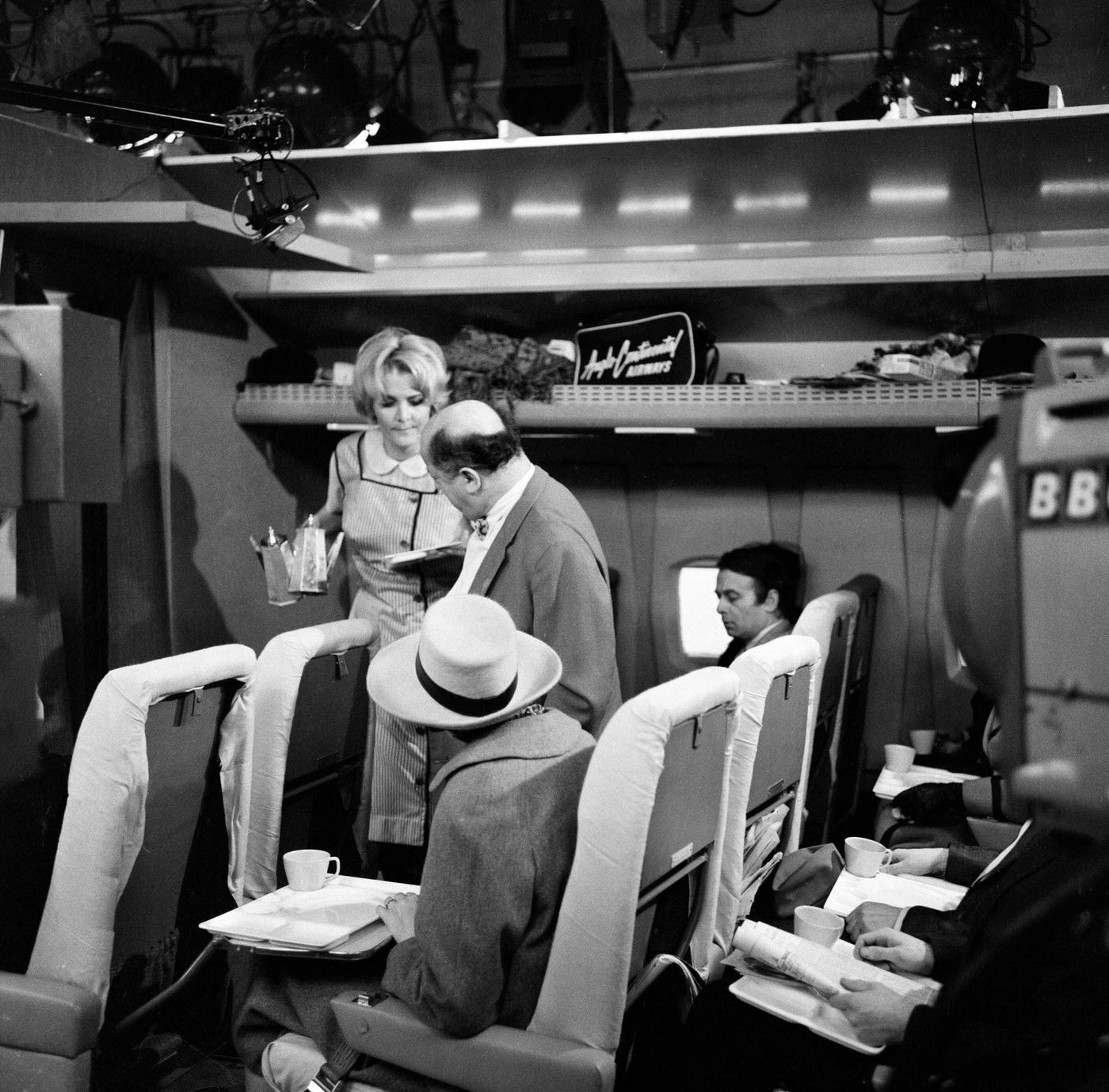
#30 Sheila Hancock playing the role of an air hostess in scenes being shot for the comedy series “The Bed-Sit Girl” at BBC Studios on February 21, 1965.
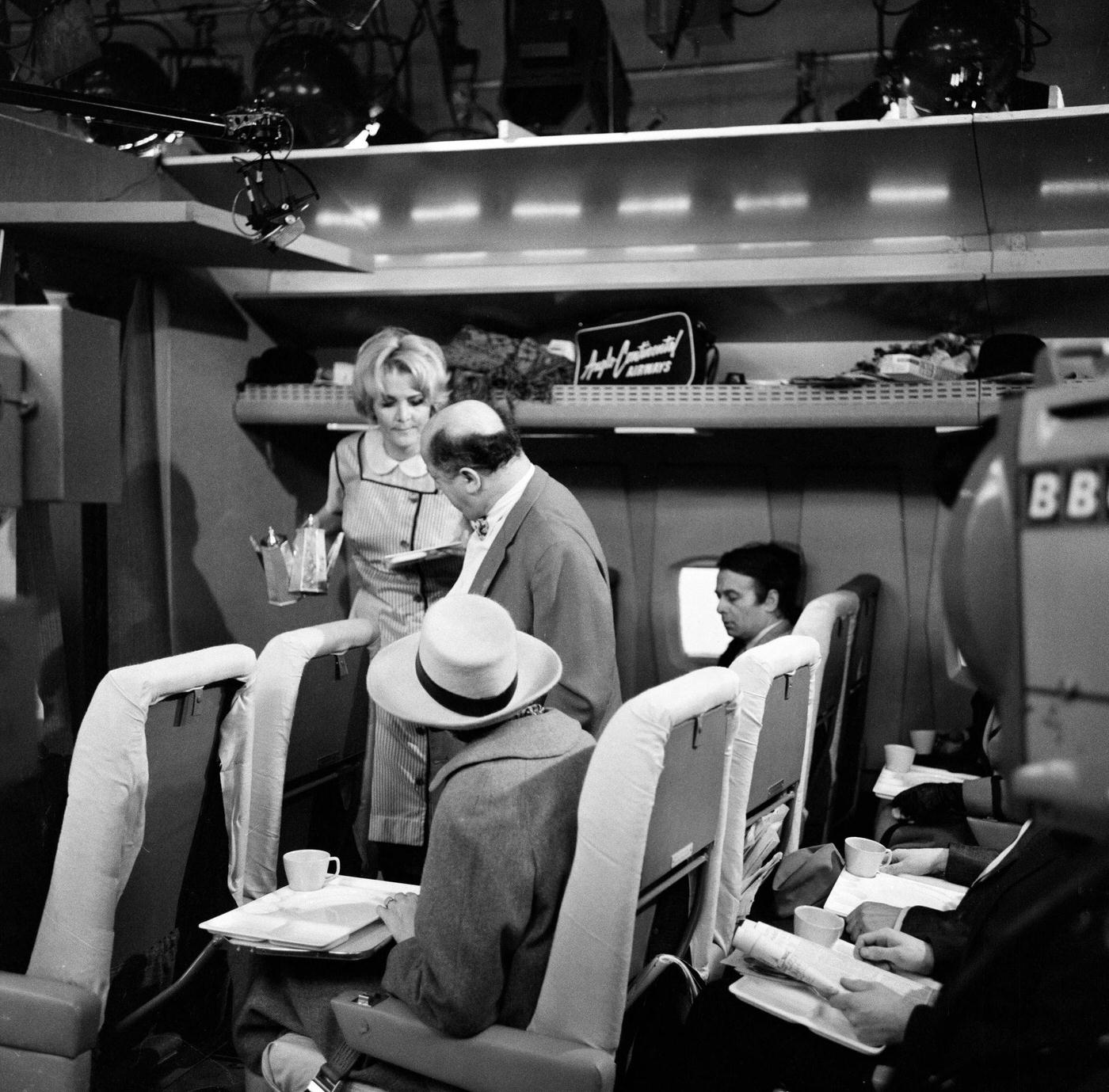
#31 Edward Heath, Conservative Party leader, joining in the fun on board an aircraft during his 1966 electioneering campaign on March 23, 1966.
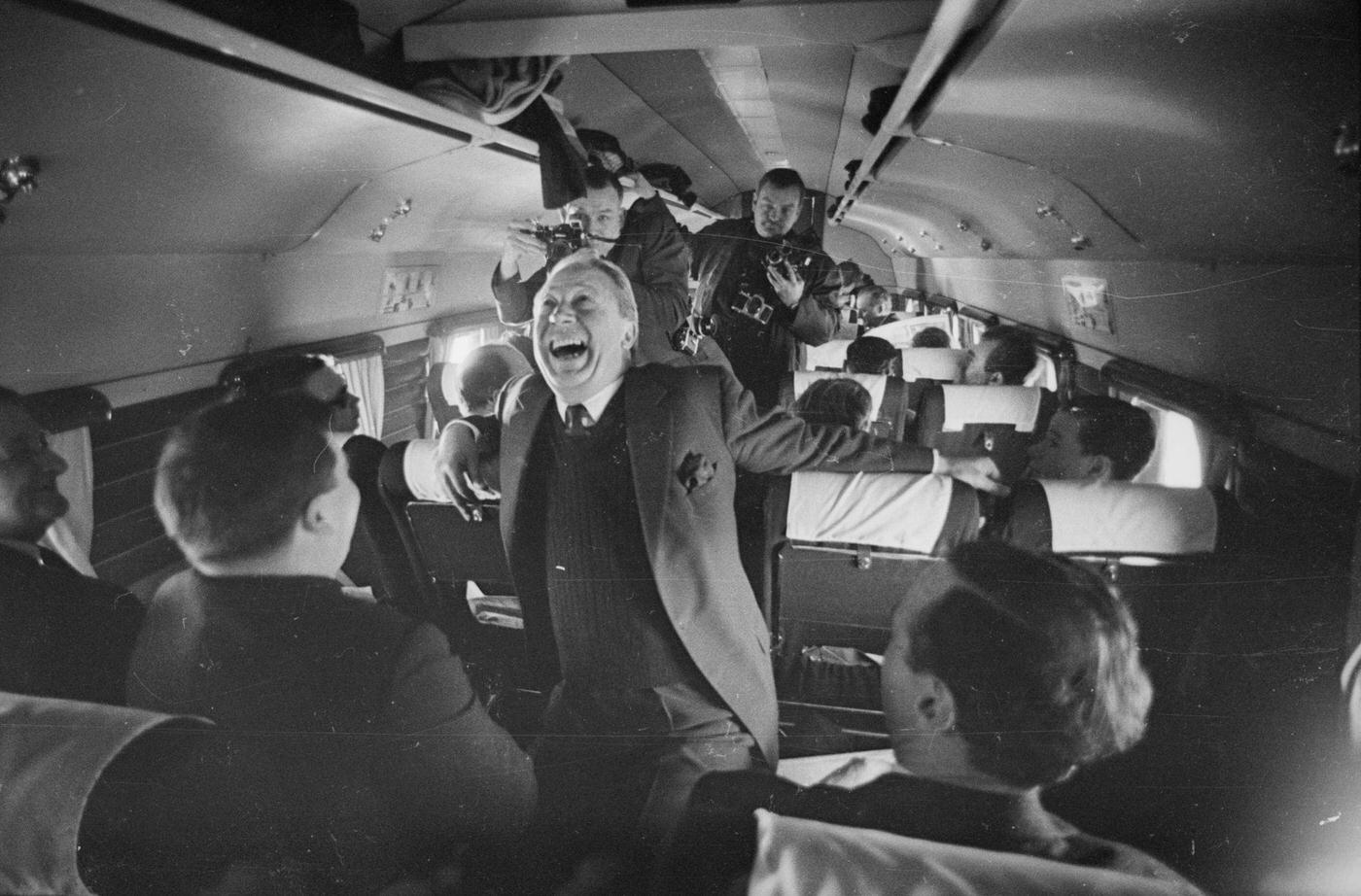
#32 Grace Kelly, Monaco princess, at Orly Airport on March 18, 1961.
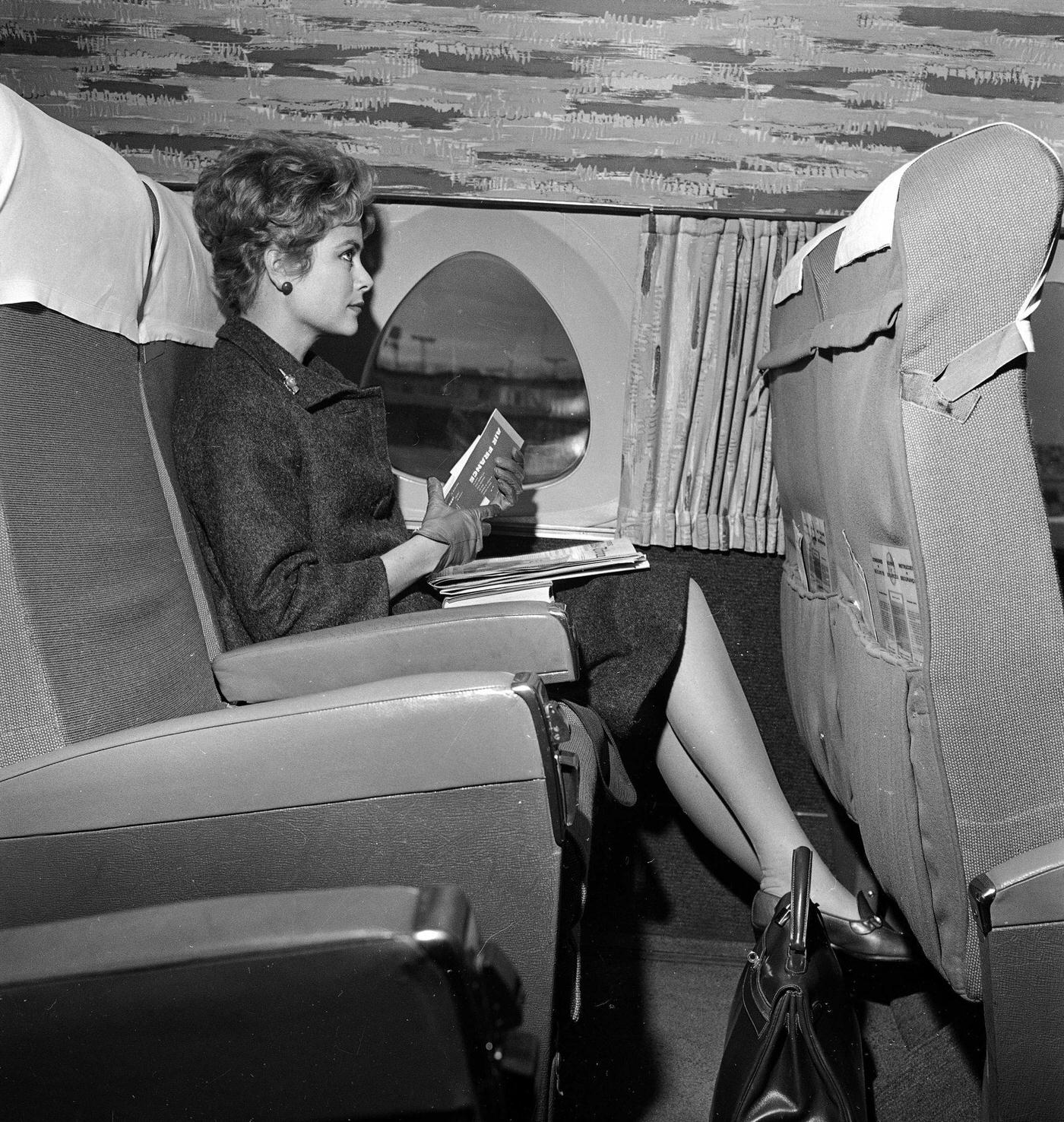
#33 Pope Paul VI blessing fellow travellers on a flight to India on December 4, 1964.
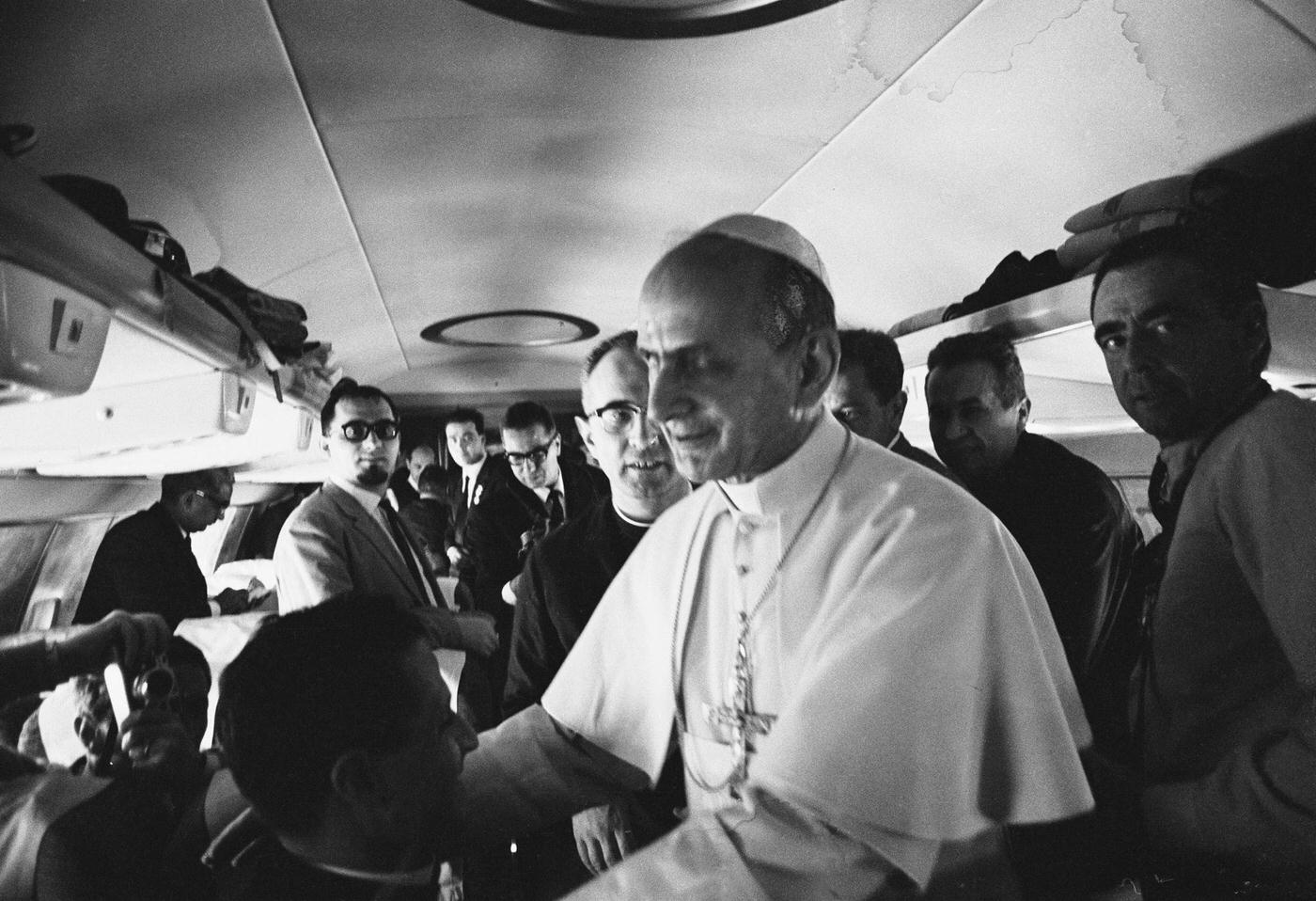
#34 John F. Kennedy entertaining his nephew Bobby Kennedy Jr. on a flight from the Democratic National Convention.
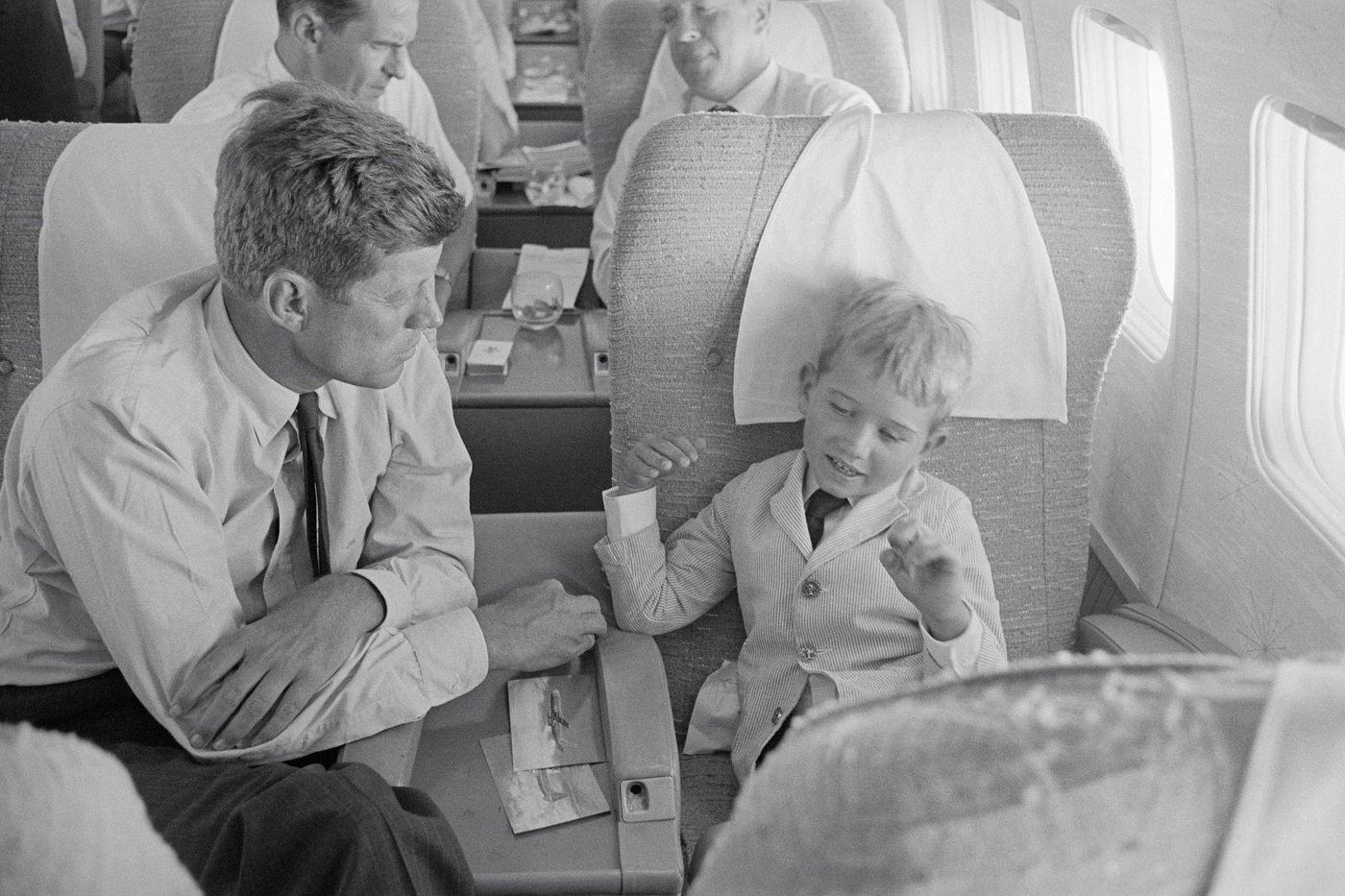
#35 Passengers aboard a spacious Lockheed L-1011 TriStar jetliner mock-up, which provides each passenger with seven square feet of space, almost 17% more than the largest transport flying at the time, in Los Angeles, California in the 1960s.
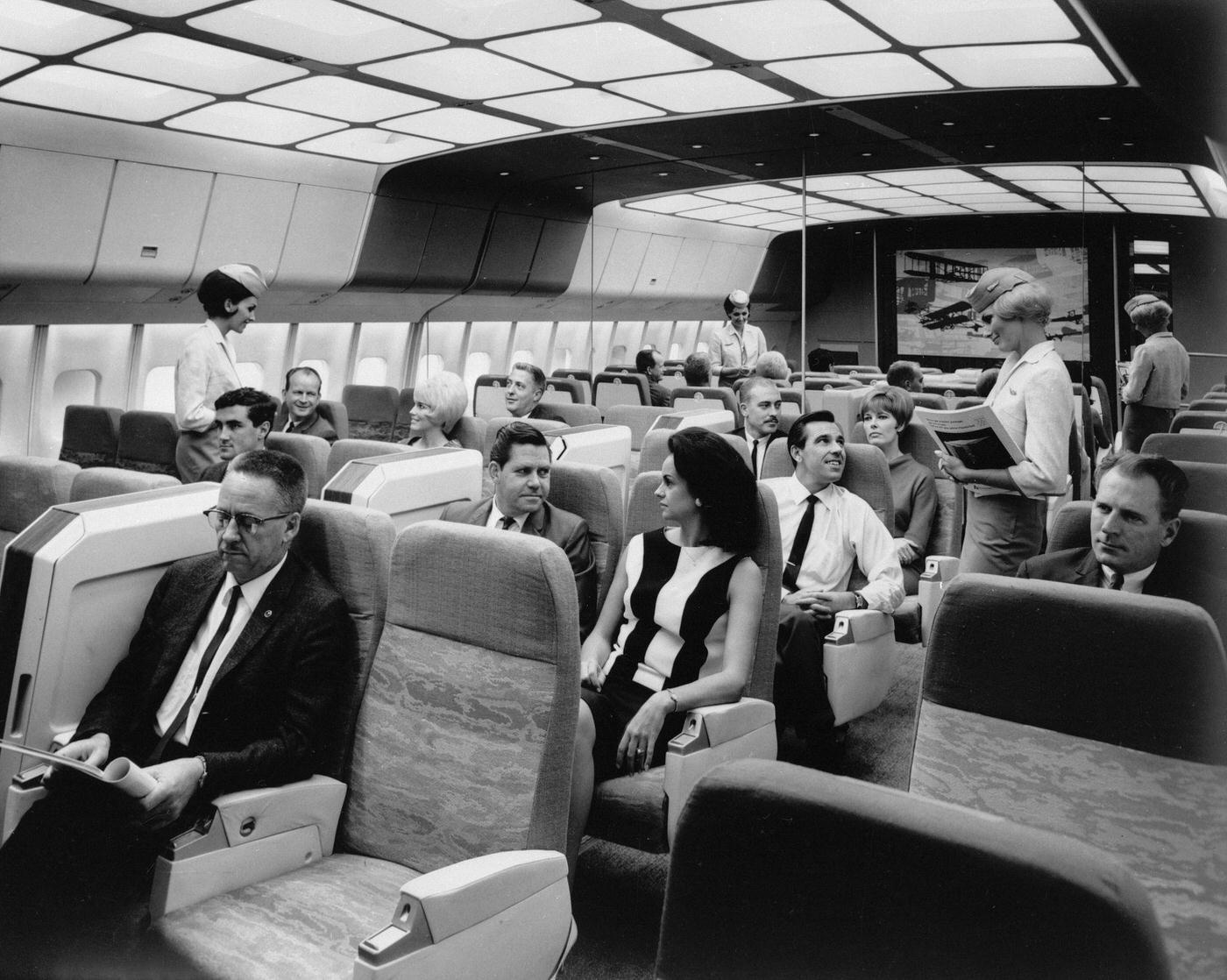
#36 Hugh Hefner, Editor and Publisher of Playboy, and Cynthia Maddox, the blond cover girl on the February issue of his magazine, arriving by TWA superjet from Chicago in New York City on January 29, 1962.
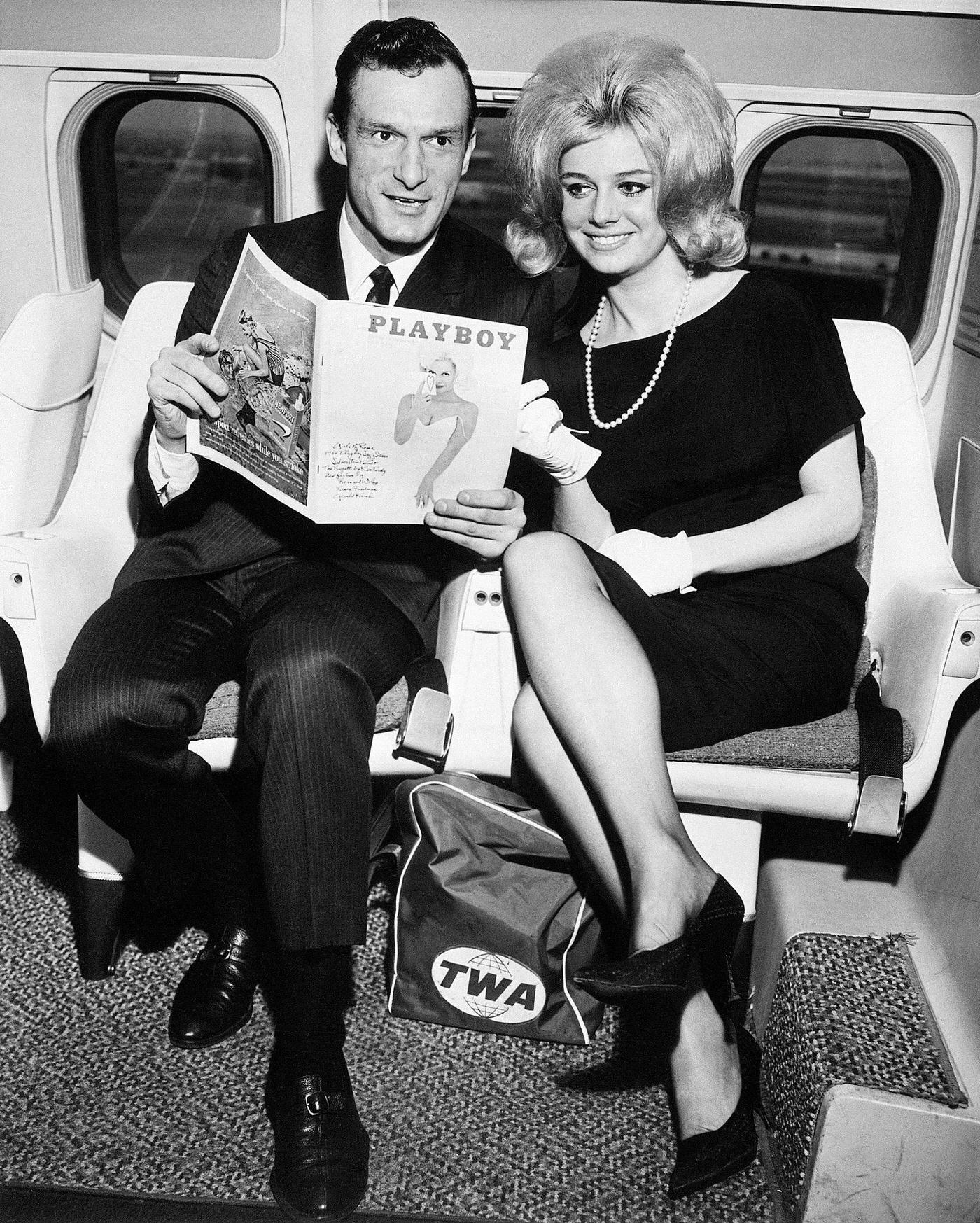
#37 A lineup of air stewardesses from different airlines attending to passengers on board the supersonic jet Concorde, standing in front of a scale model of the aircraft.
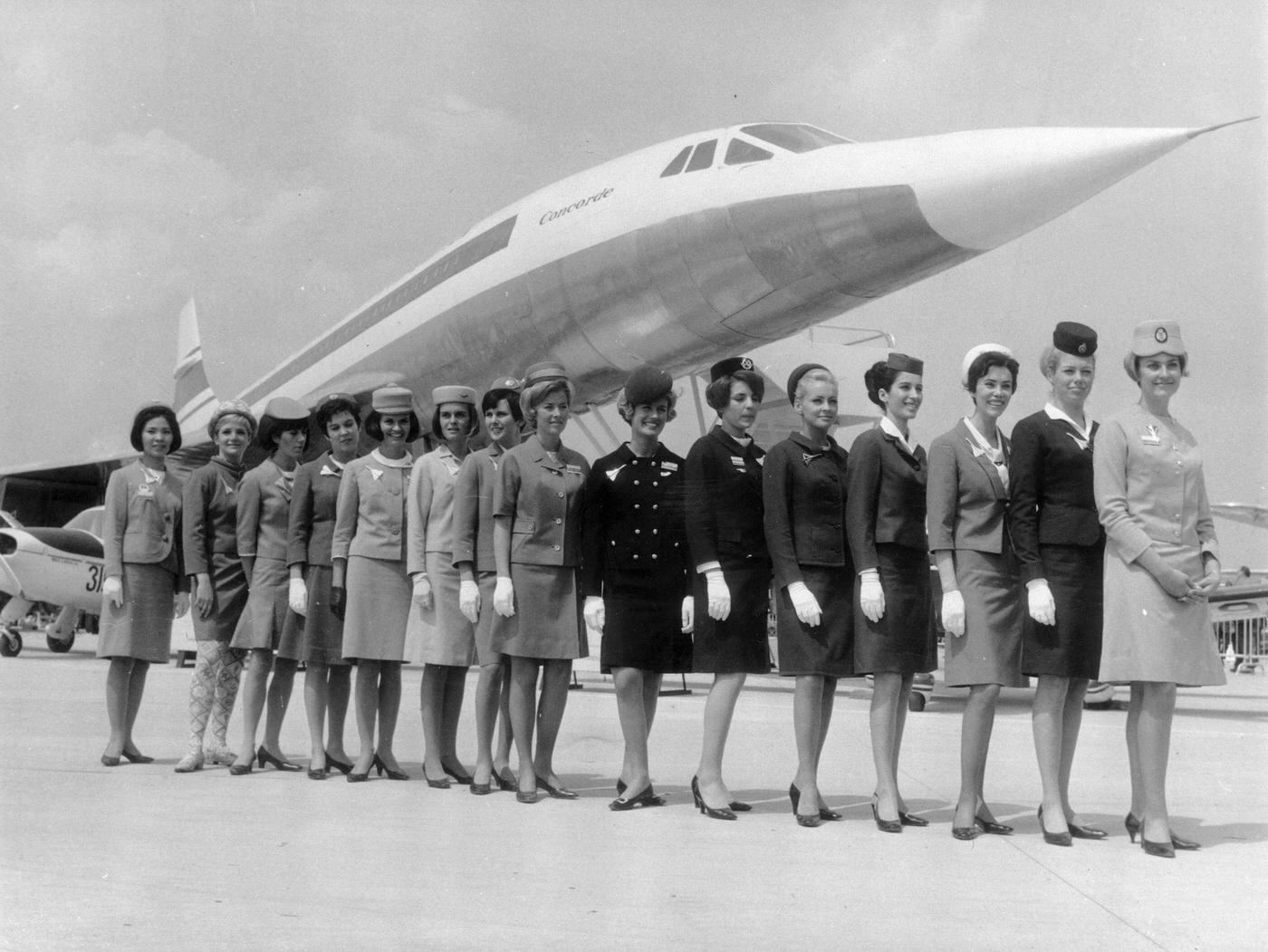
#38 A demonstration of the new Boeing 747 passenger plane under development, which will carry up to 490 passengers in luxurious seats and include a stairway between decks, on May 13, 1968.
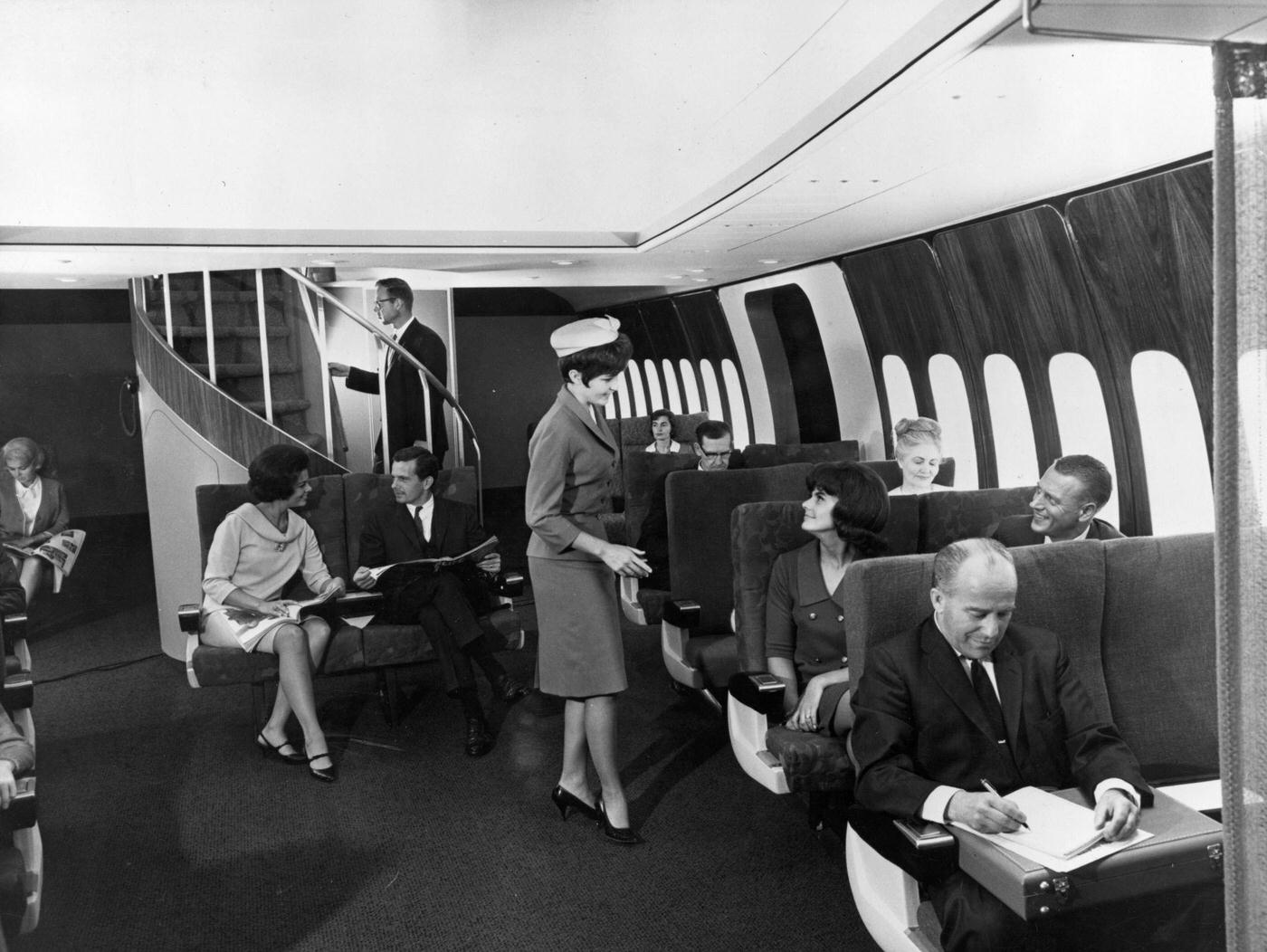
#39 Test flight of a new Pan American Airlines plane fitted with television sets in the hand luggage racks for the entertainment of passengers, 1965.
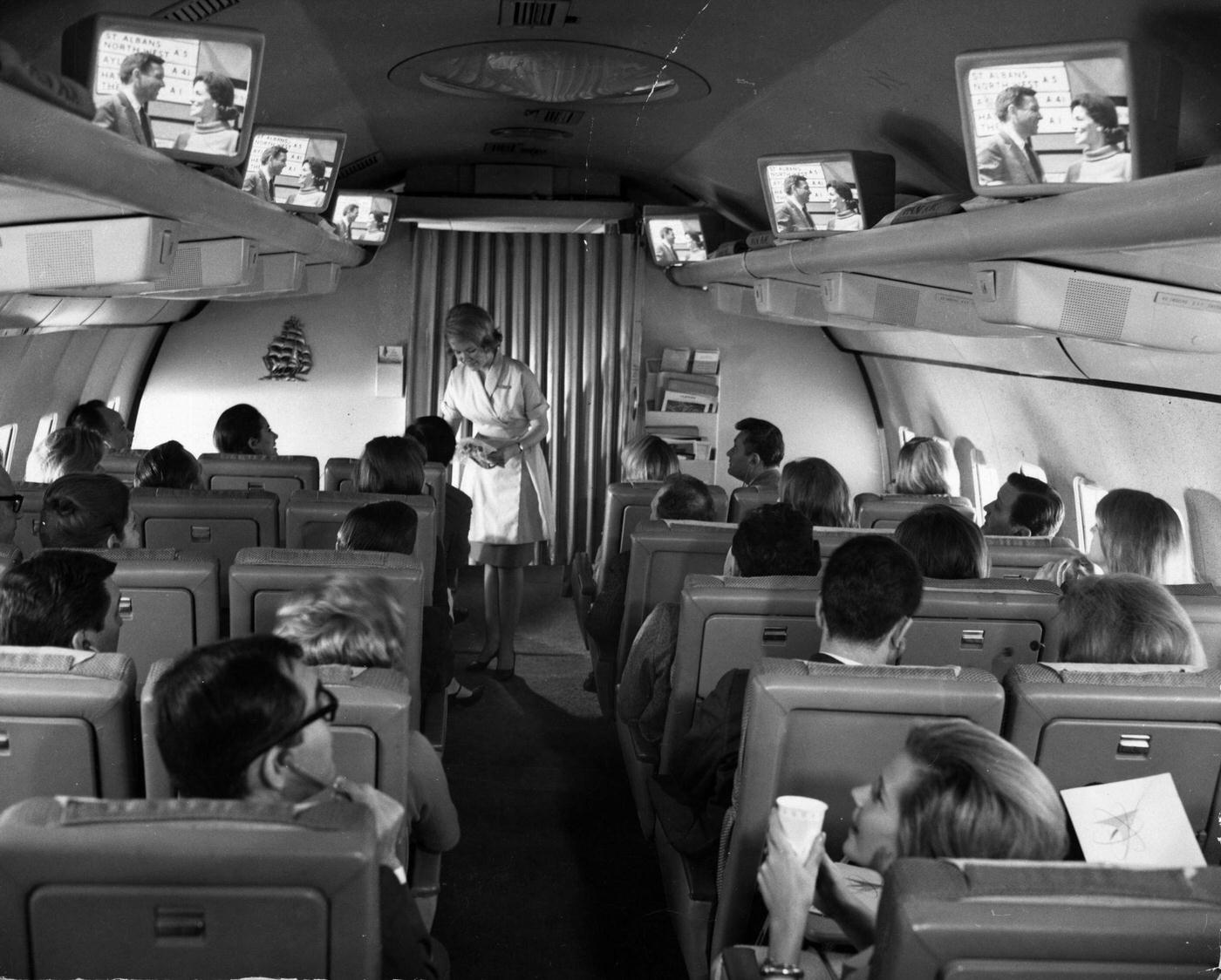
#40 Passengers on airplane at Tempelhof Airport, Berlin, ca. 1960.
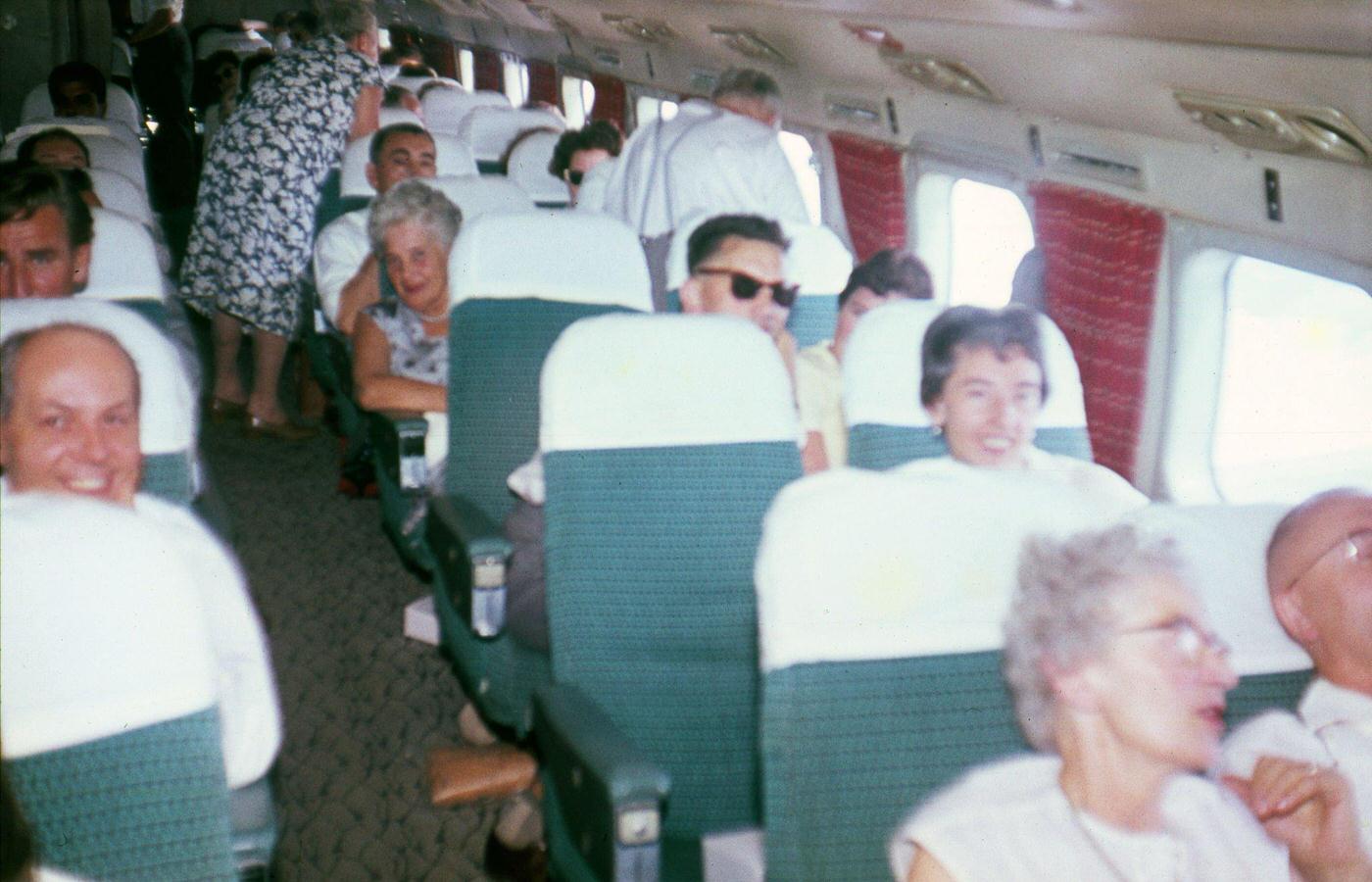
#41 Air hostess offering drinks to passengers on board plane. 1960s.
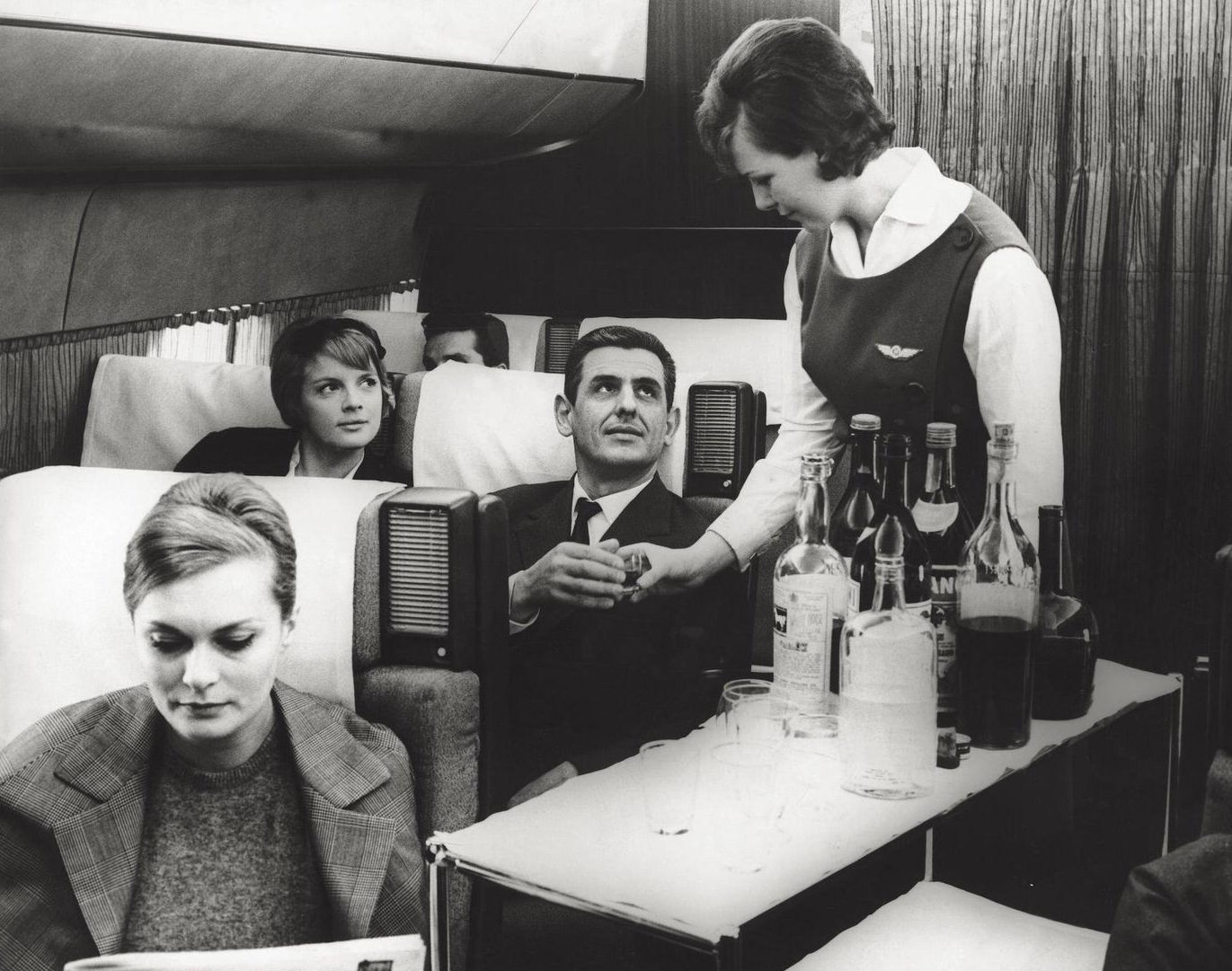
#42 Passengers on a Pan American airplane watching television for the first time. Date unspecified.
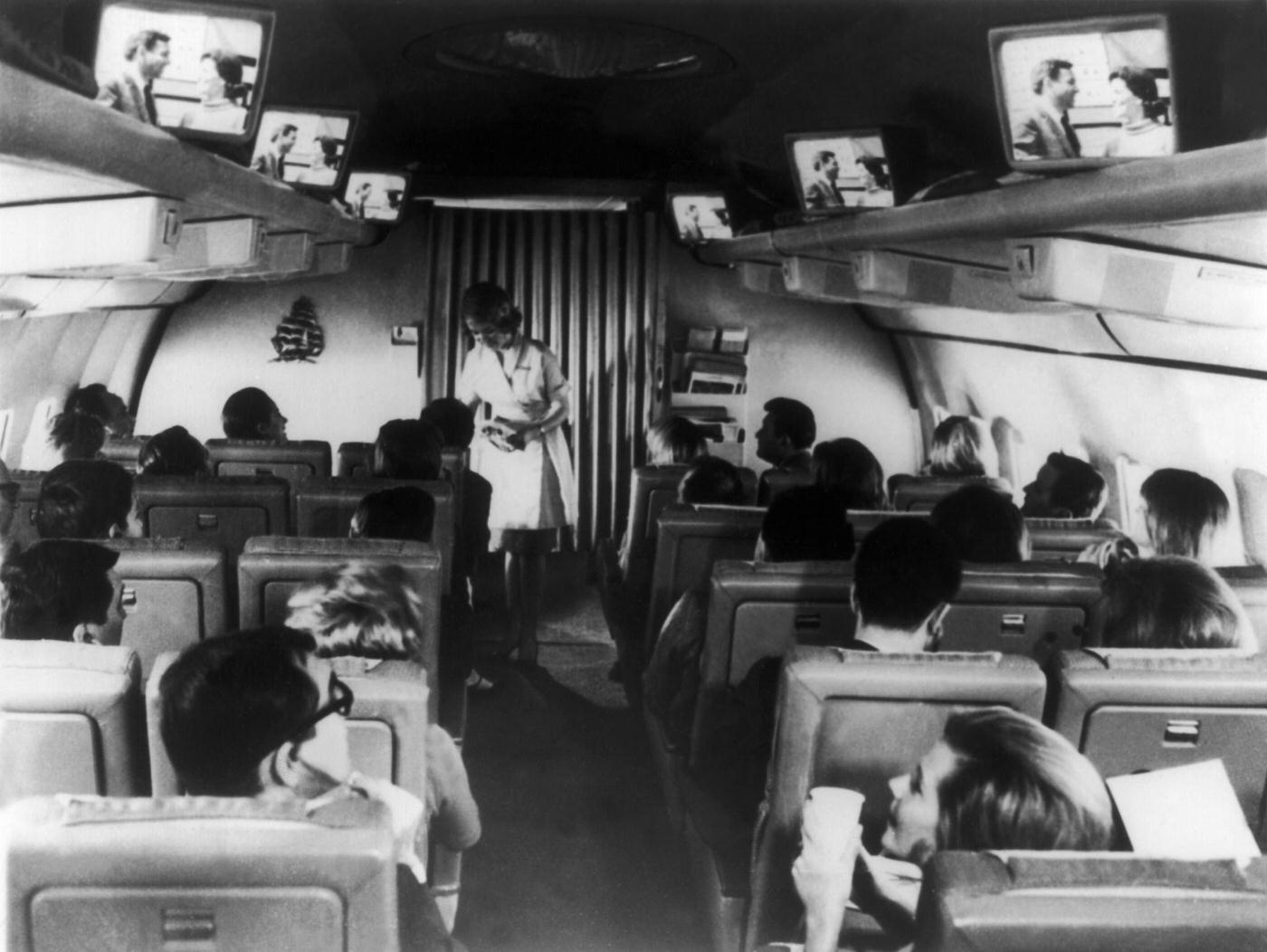
#43 Passengers on a jumbo jet. 1960.
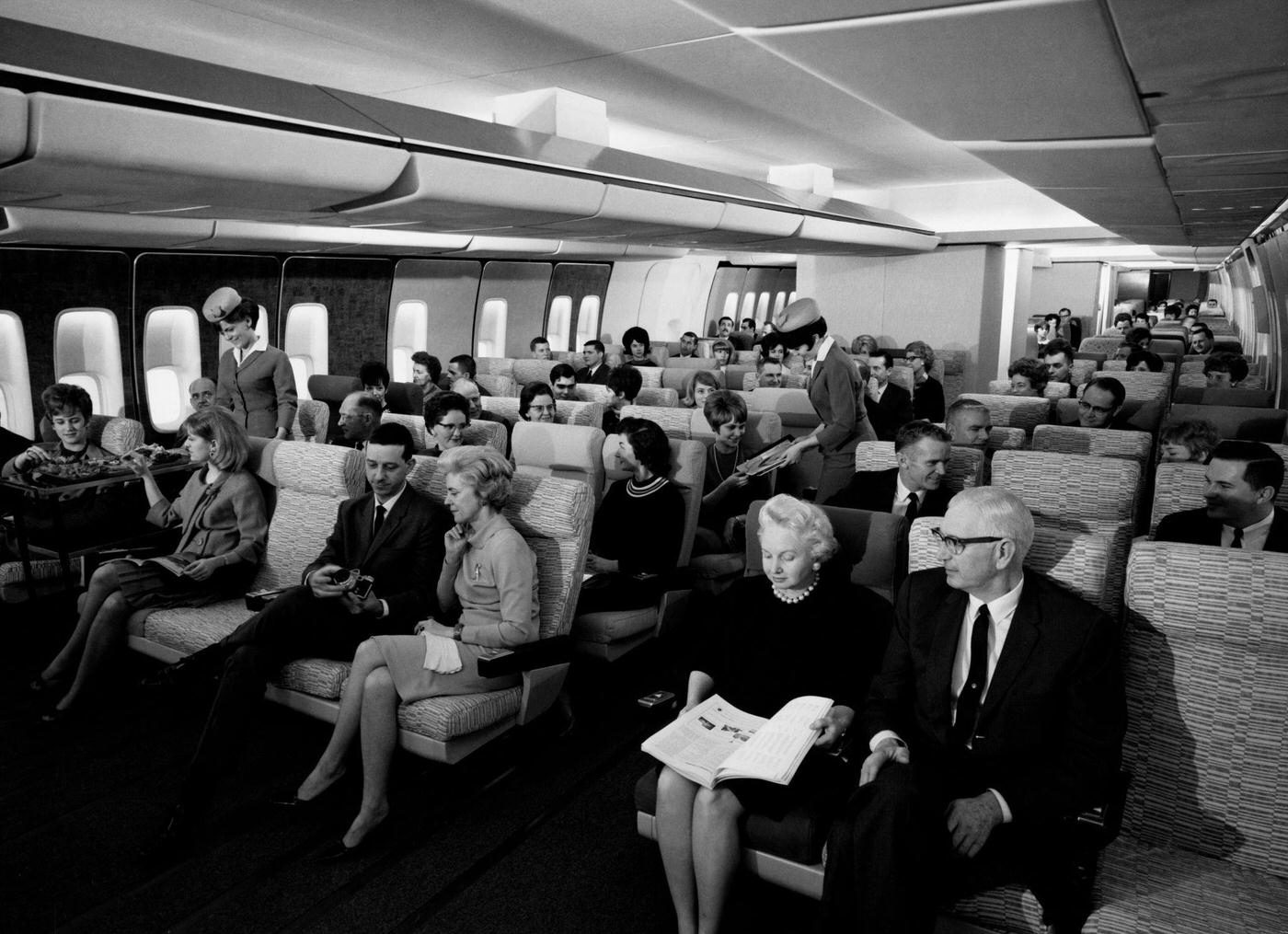
#44 Passengers at the airplane in Spain. Date unspecified.
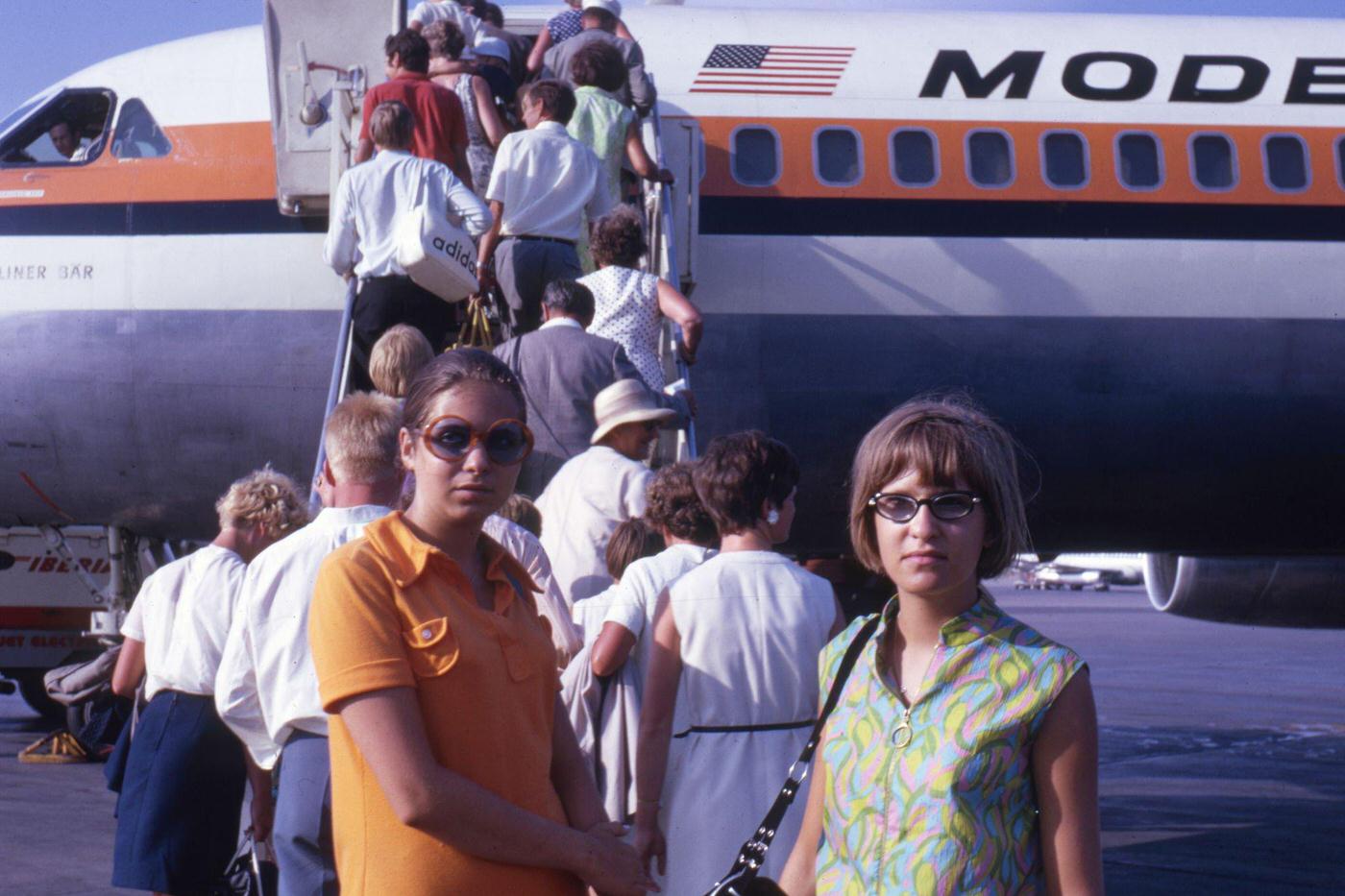
#45 Passengers aboard an airplane.
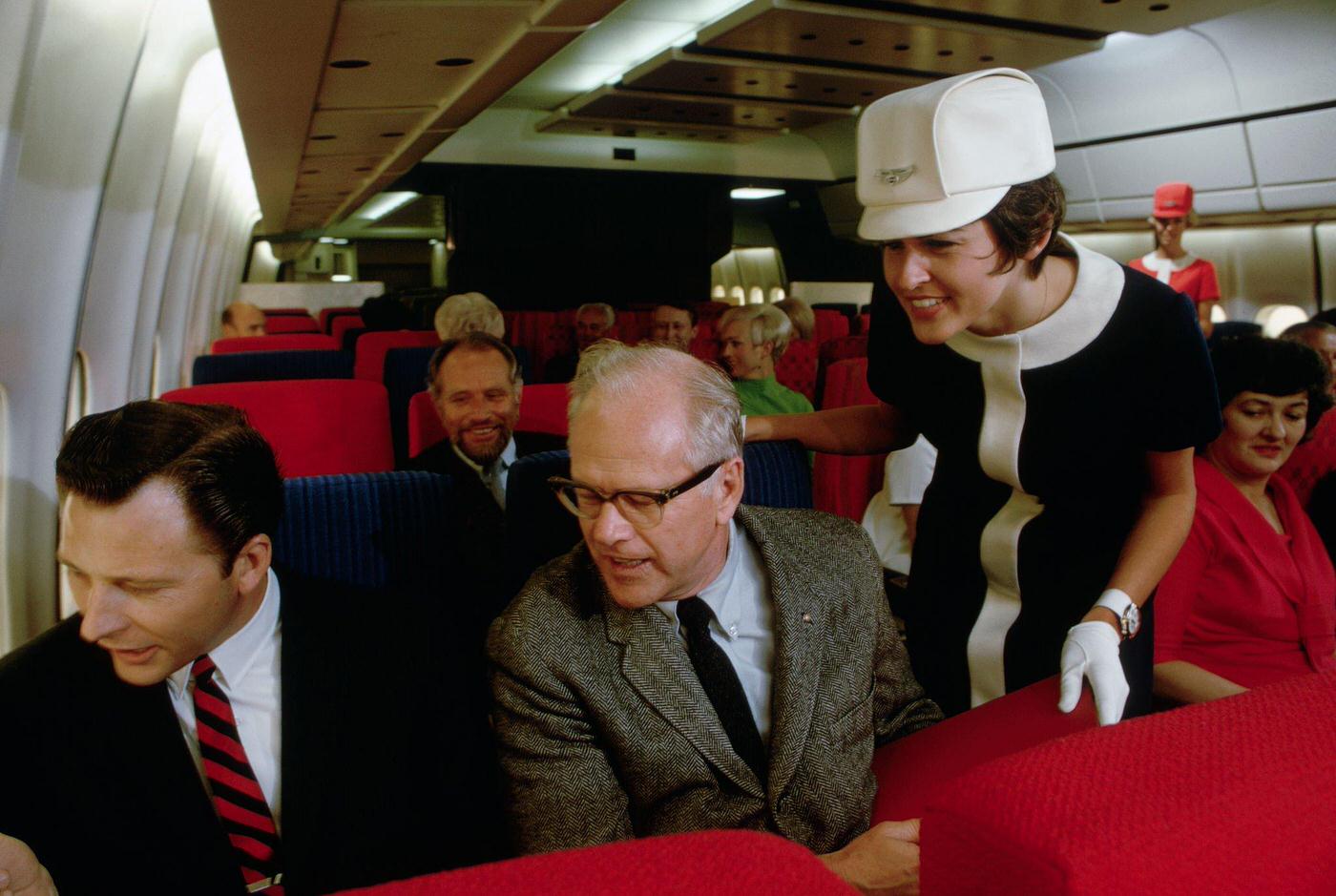
#46 Southwest Airlines stewardesses in Texas standing in front of planes belonging to the airline. 1968.
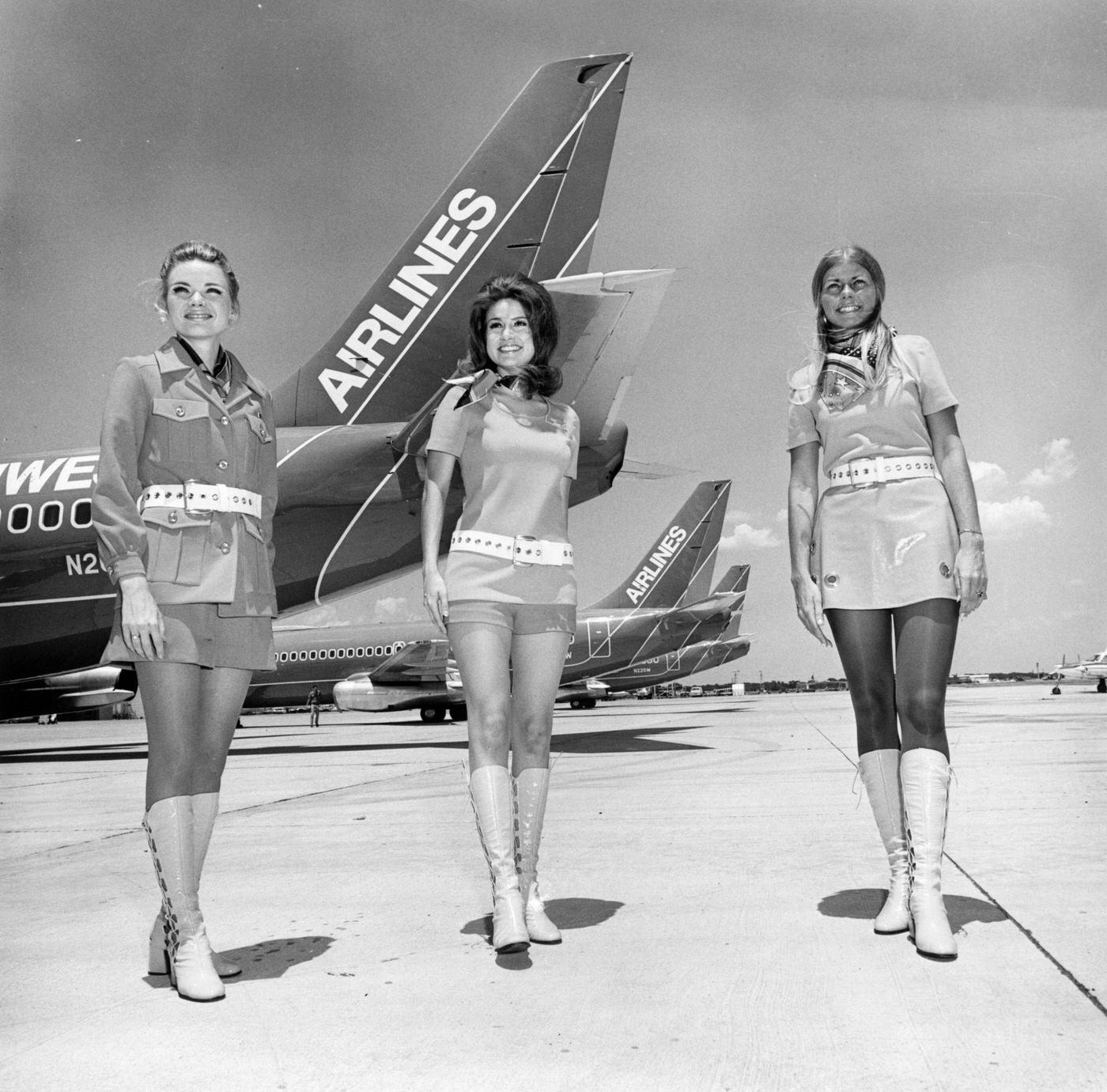
#47 Passengers waiting in line at American Airlines counter at John F. Kennedy International Airport during a machinists’ strike. July 8, 1966.
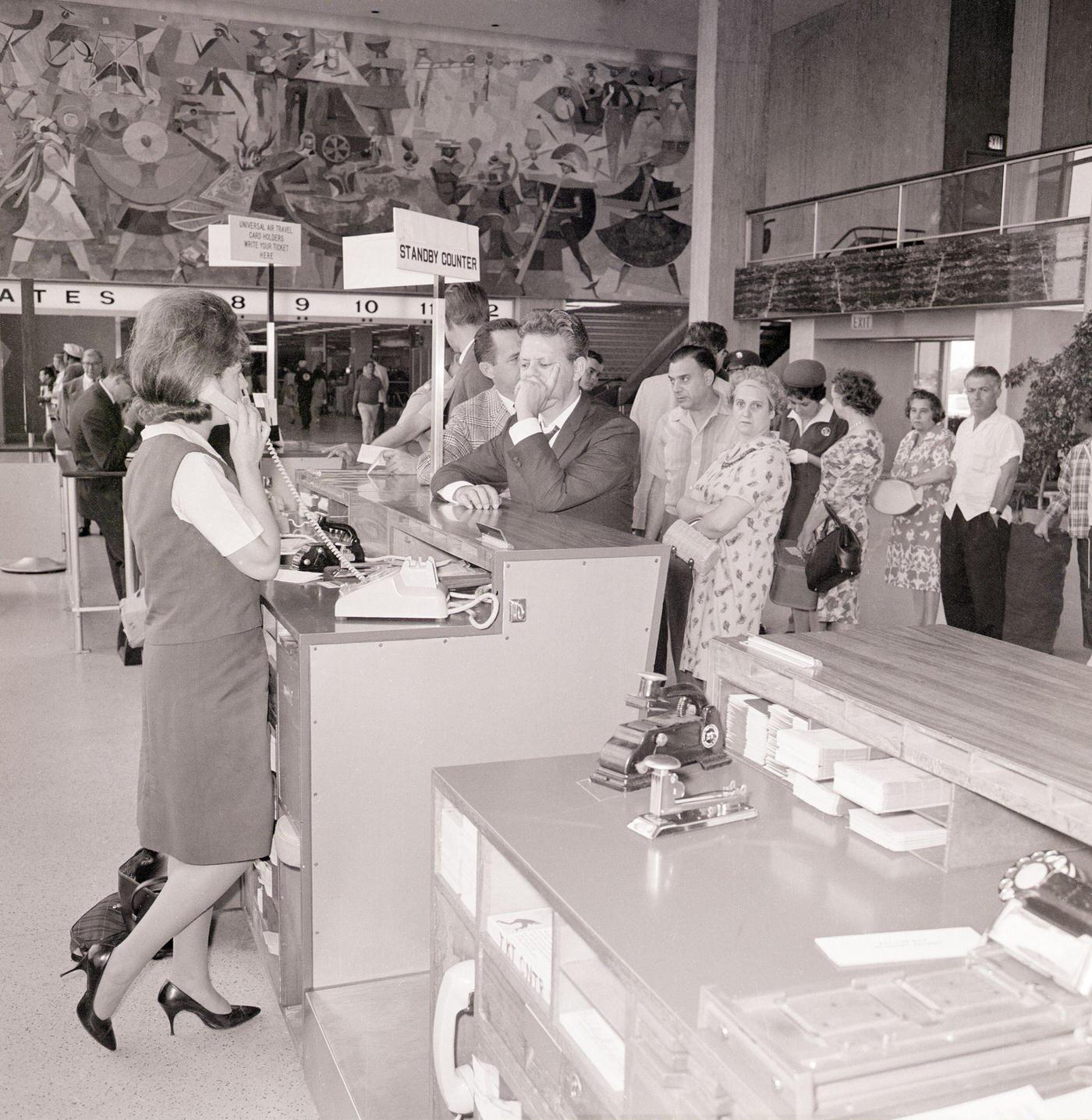
#48 Passengers view New York City from the window of a helicopter taxi to New York airports.
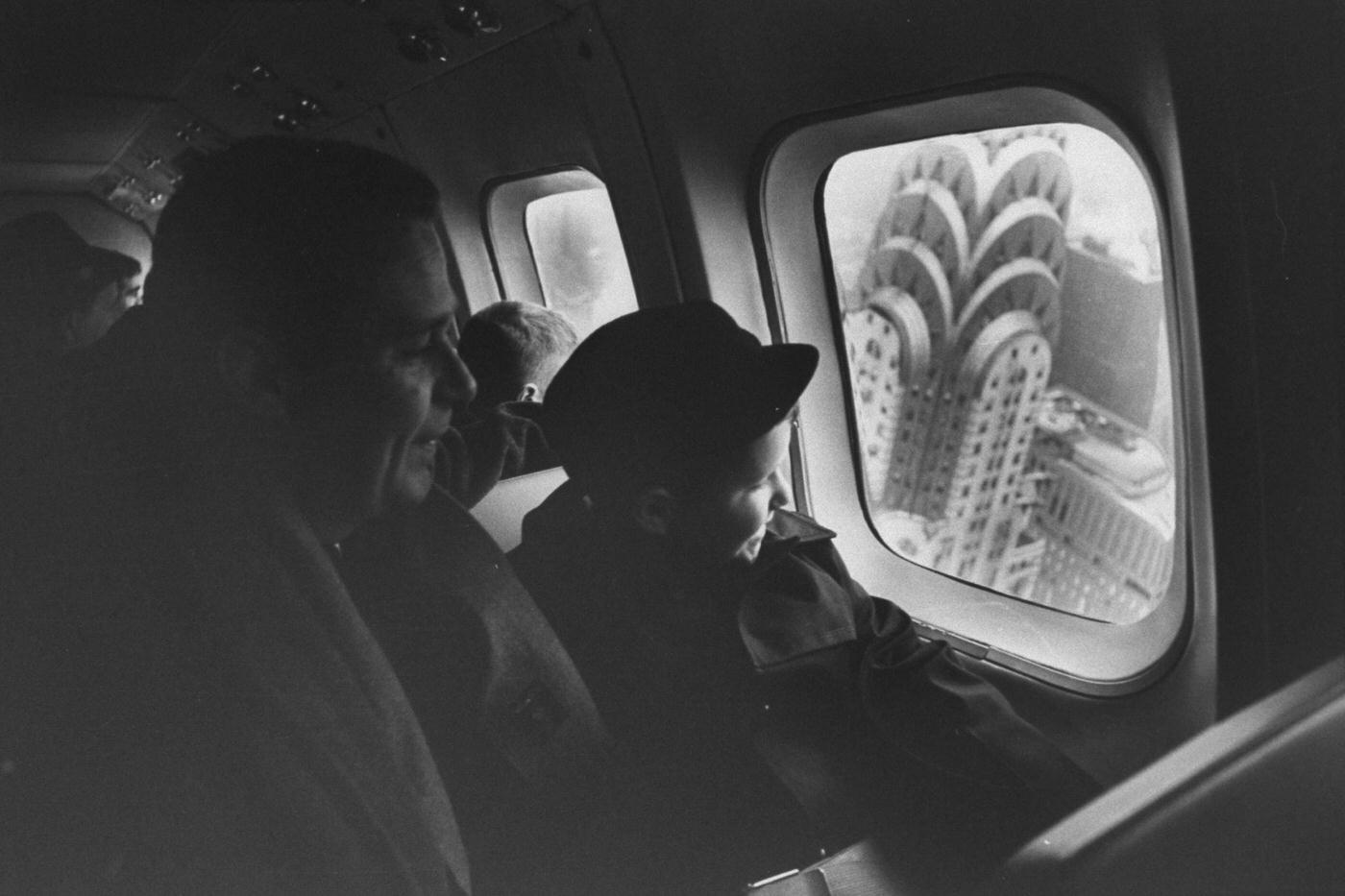
#49 Comet airplane. 1950-60.
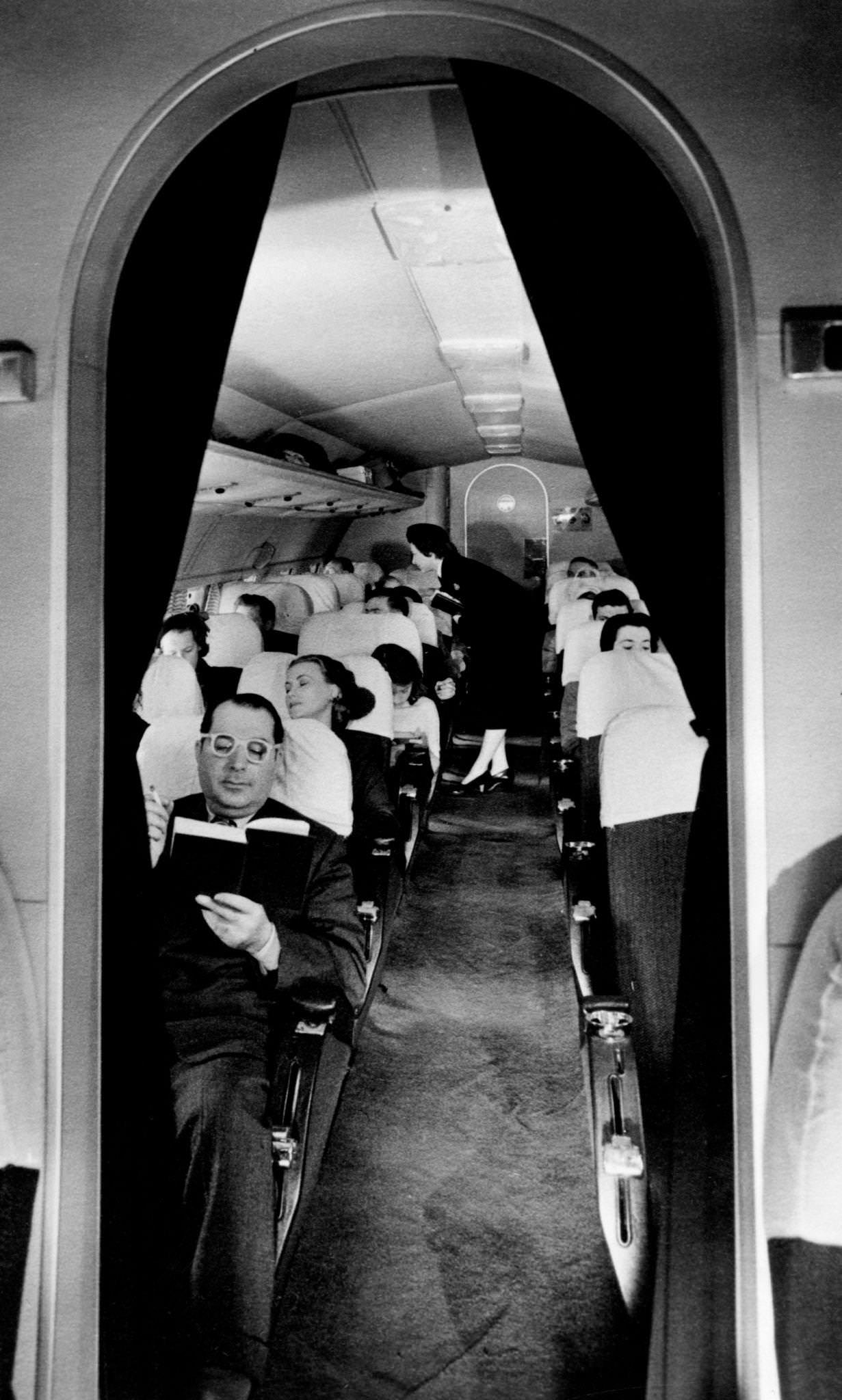
#50 First-class passengers on a jumbo jet. 1960.
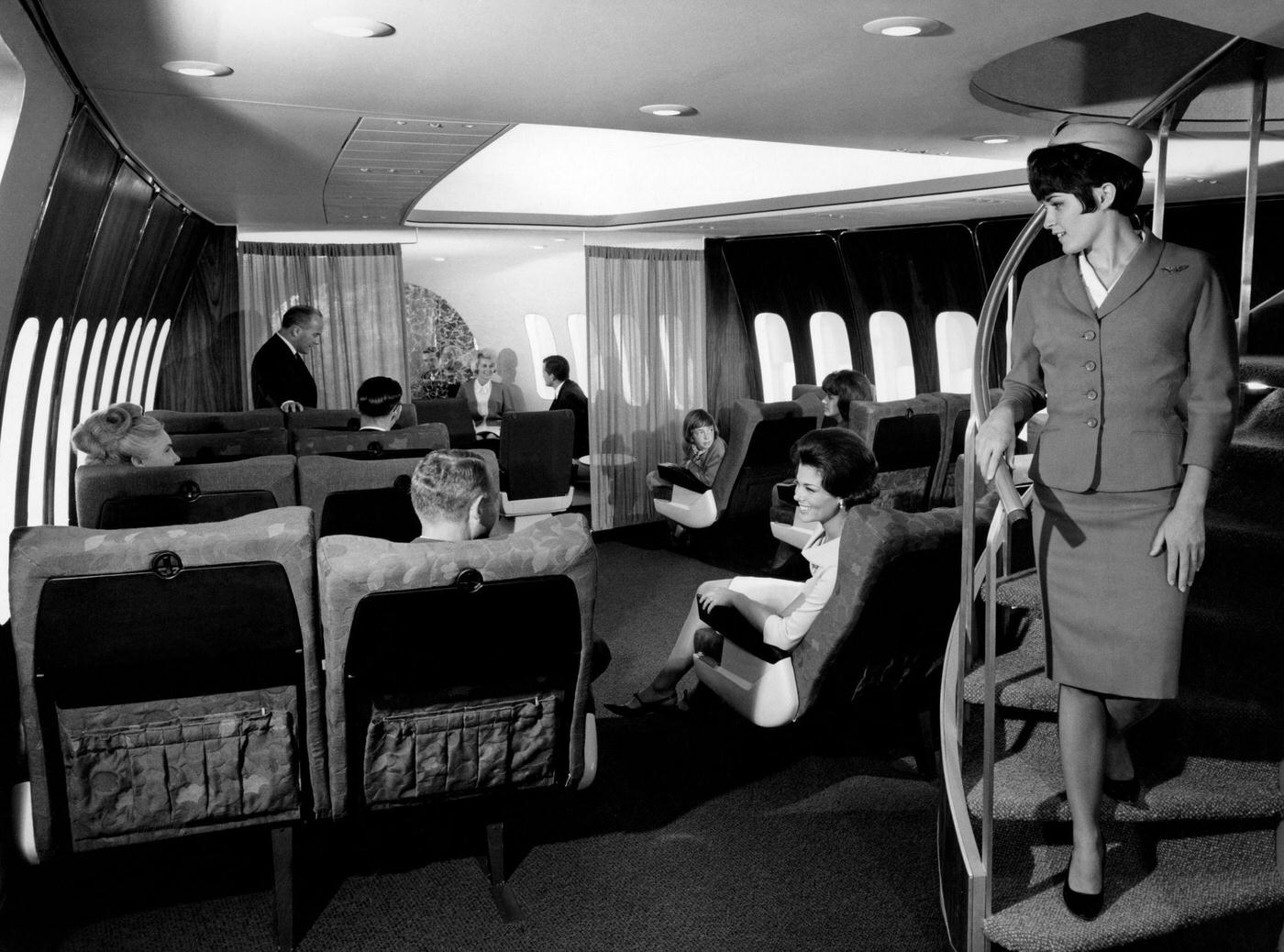

#51 Passengers filling a full-scale model of the Concorde supersonic airliner at the British Aircraft Corporation factory in Filton, Bristol. February 24, 1967.
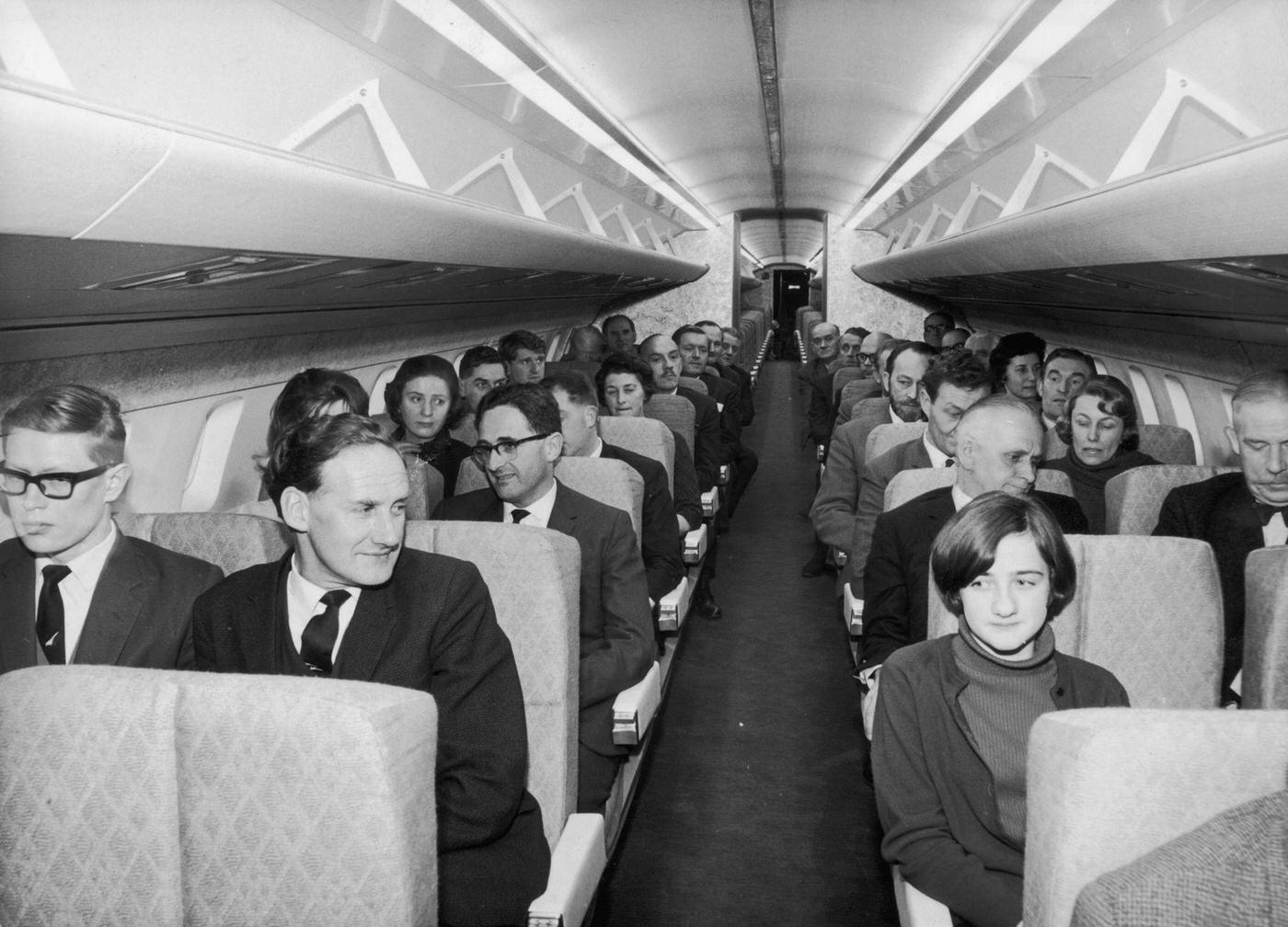
#52 Passengers sitting on an Air Canada plane on the runway during the 1965 blackout in NYC. November 9, 1965.
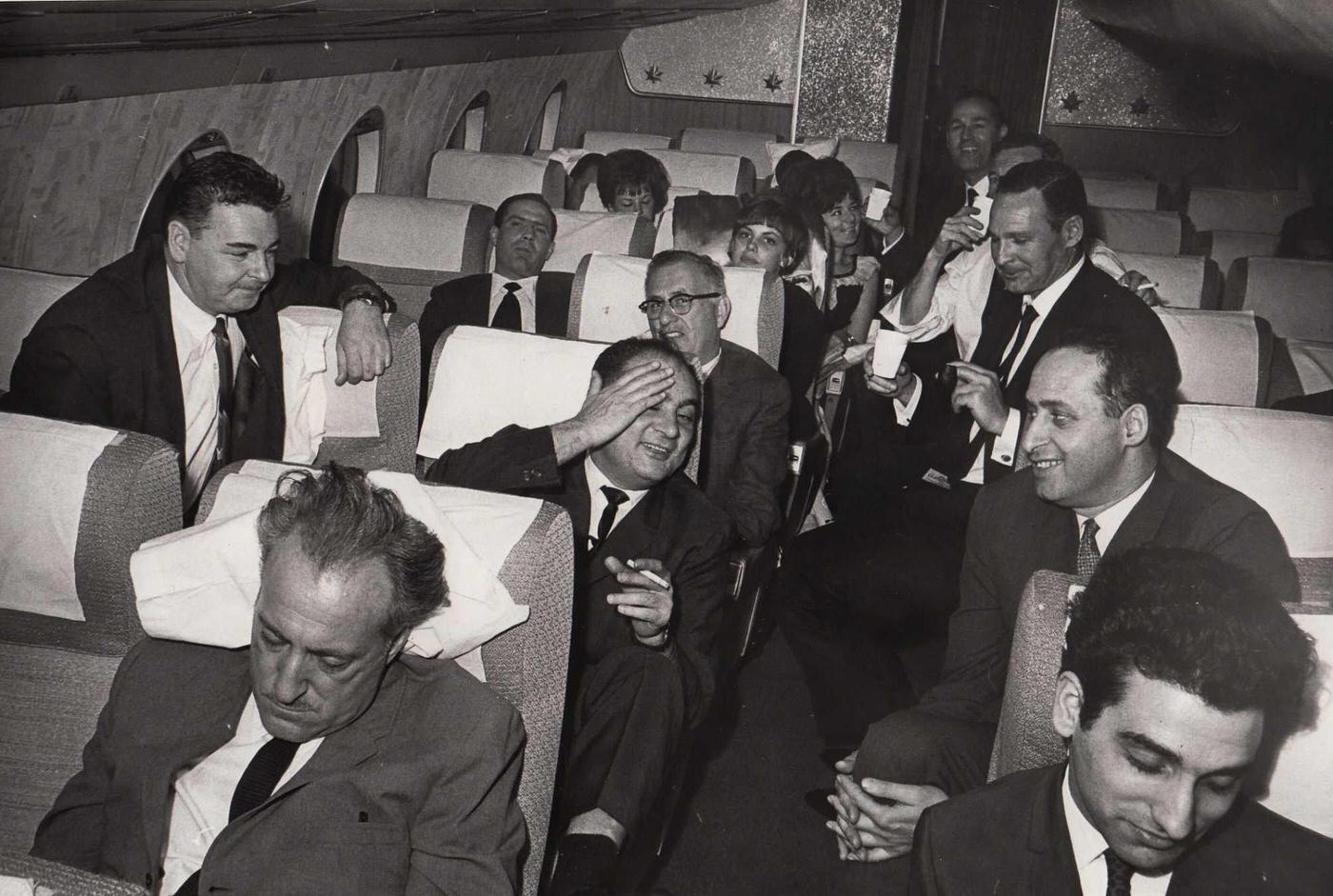
#53 Passengers boarding the first of the British United Airlines proving flights for their new BAC 1-11 aircraft. January 27, 19– (year missing).
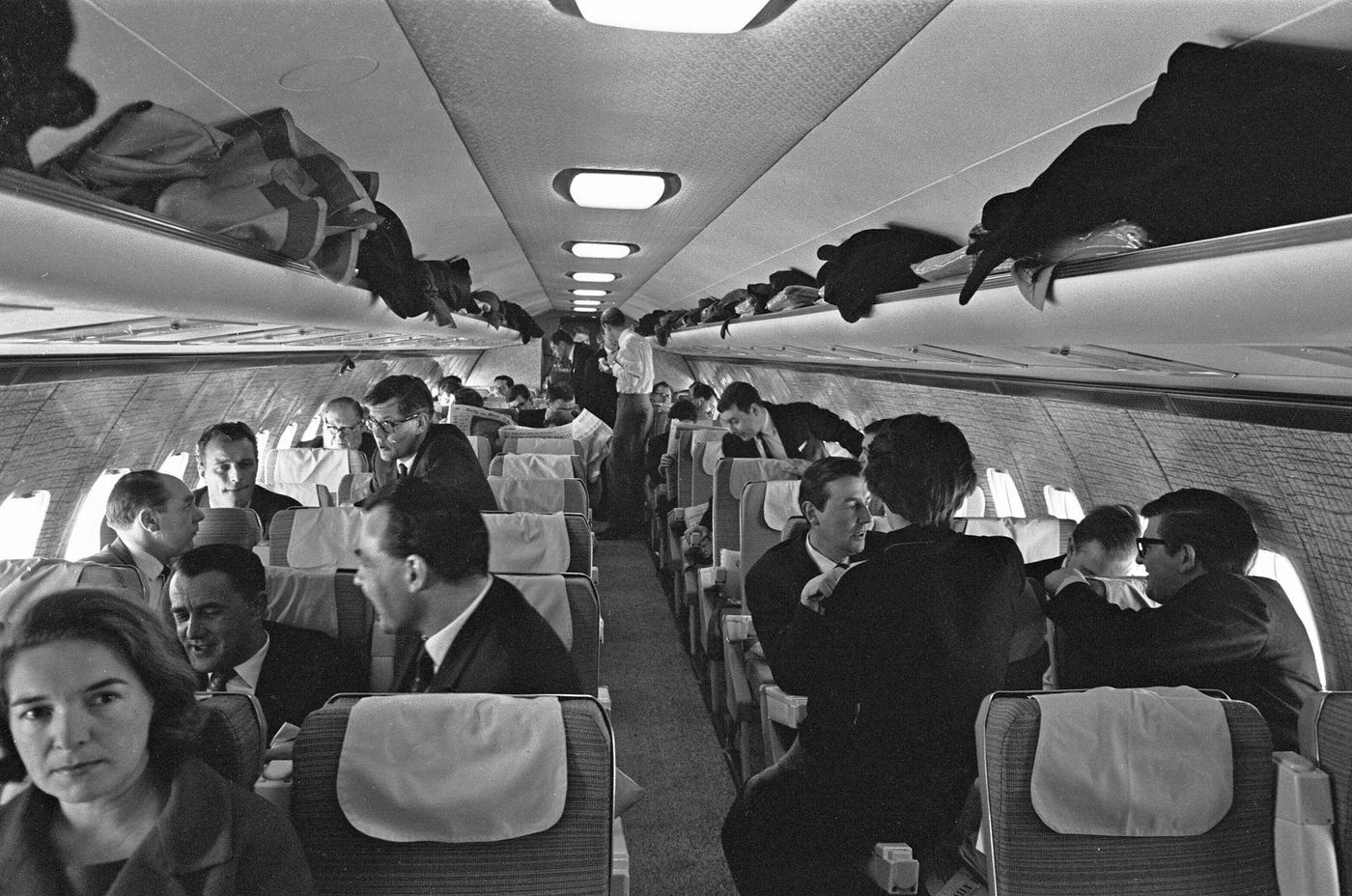
#54 Emergency landing of a Boeing 707 at Heathrow Airport. April 1967.
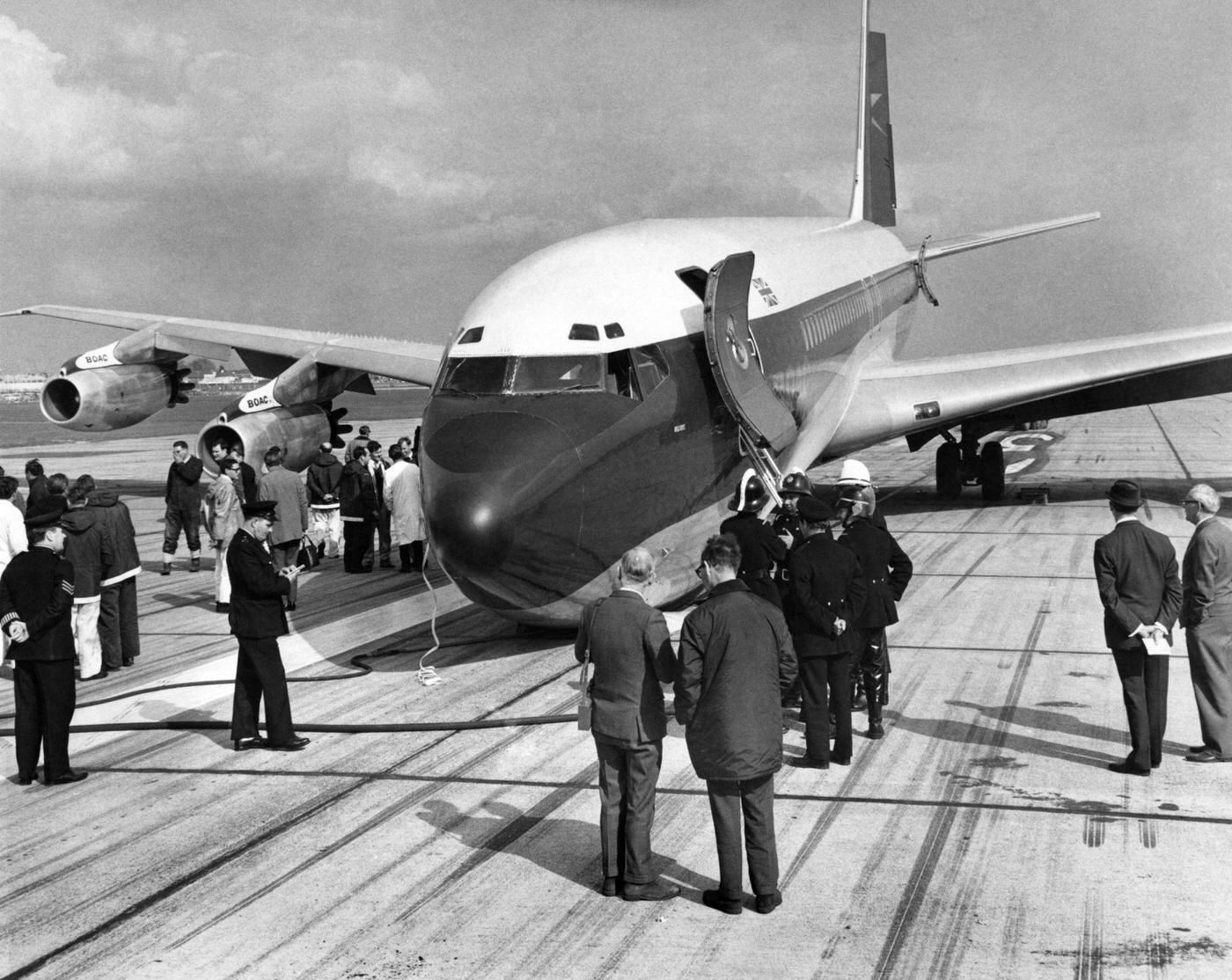
#55 Concorde prototype. February 1967.
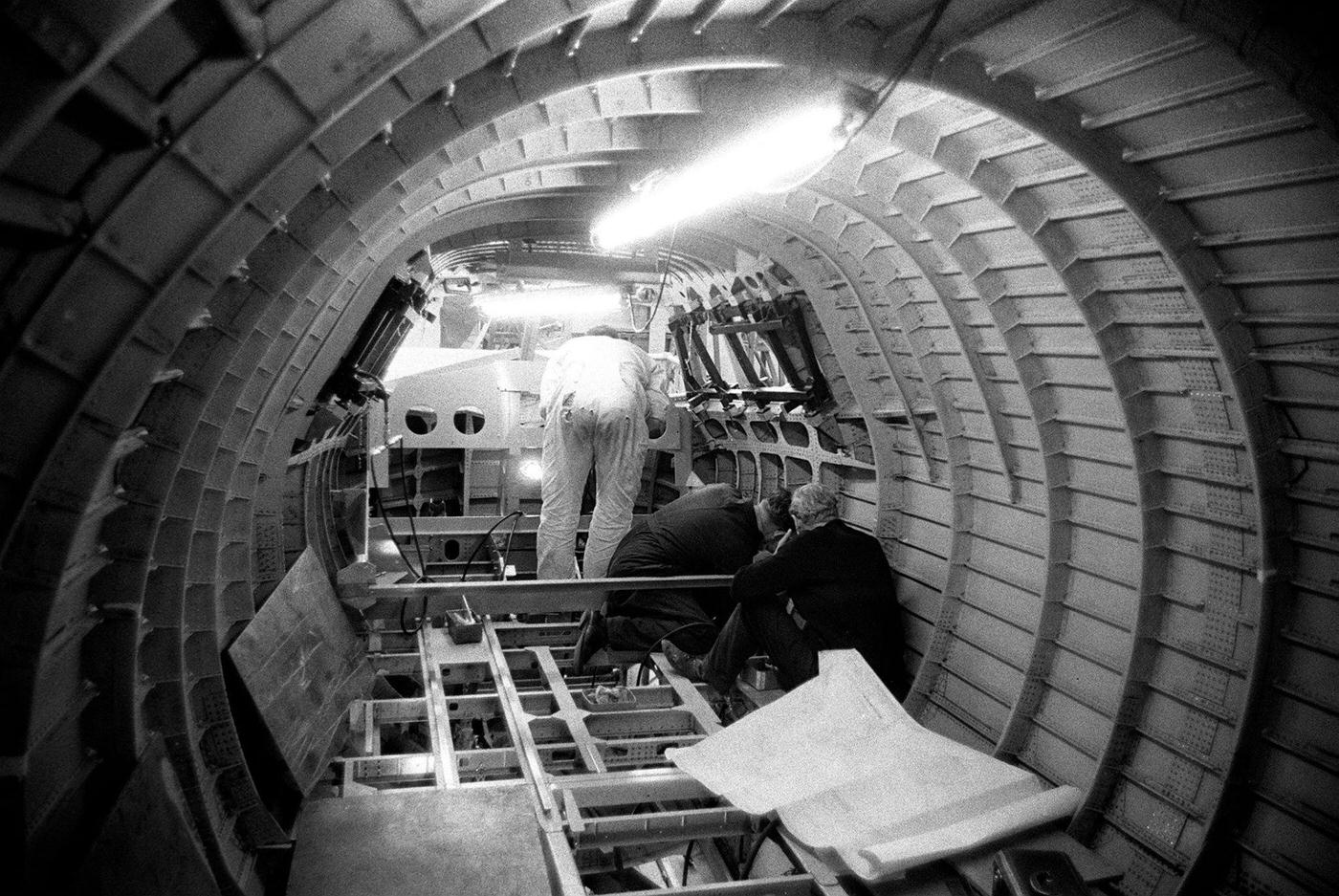
#56 Two first-class seats aboard a TWA jet from London to Washington, one occupied by a caesium beam timepiece accurate to one-millioneth of a second used in the USA’s space programme. Date unspecified.
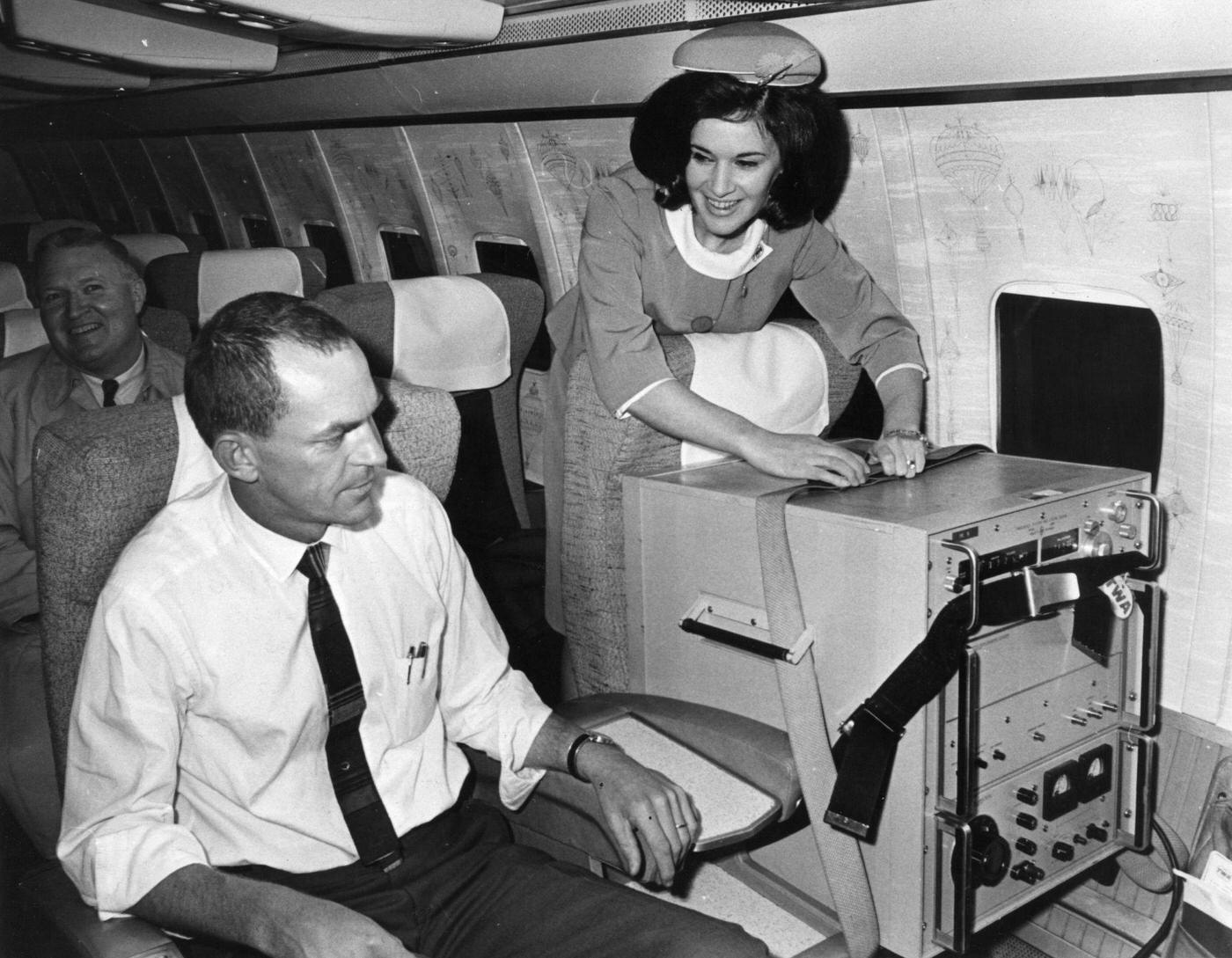
#57 A United Airlines flight attendant talks with a passenger in a simulated passenger compartment of a Douglas DC-10.
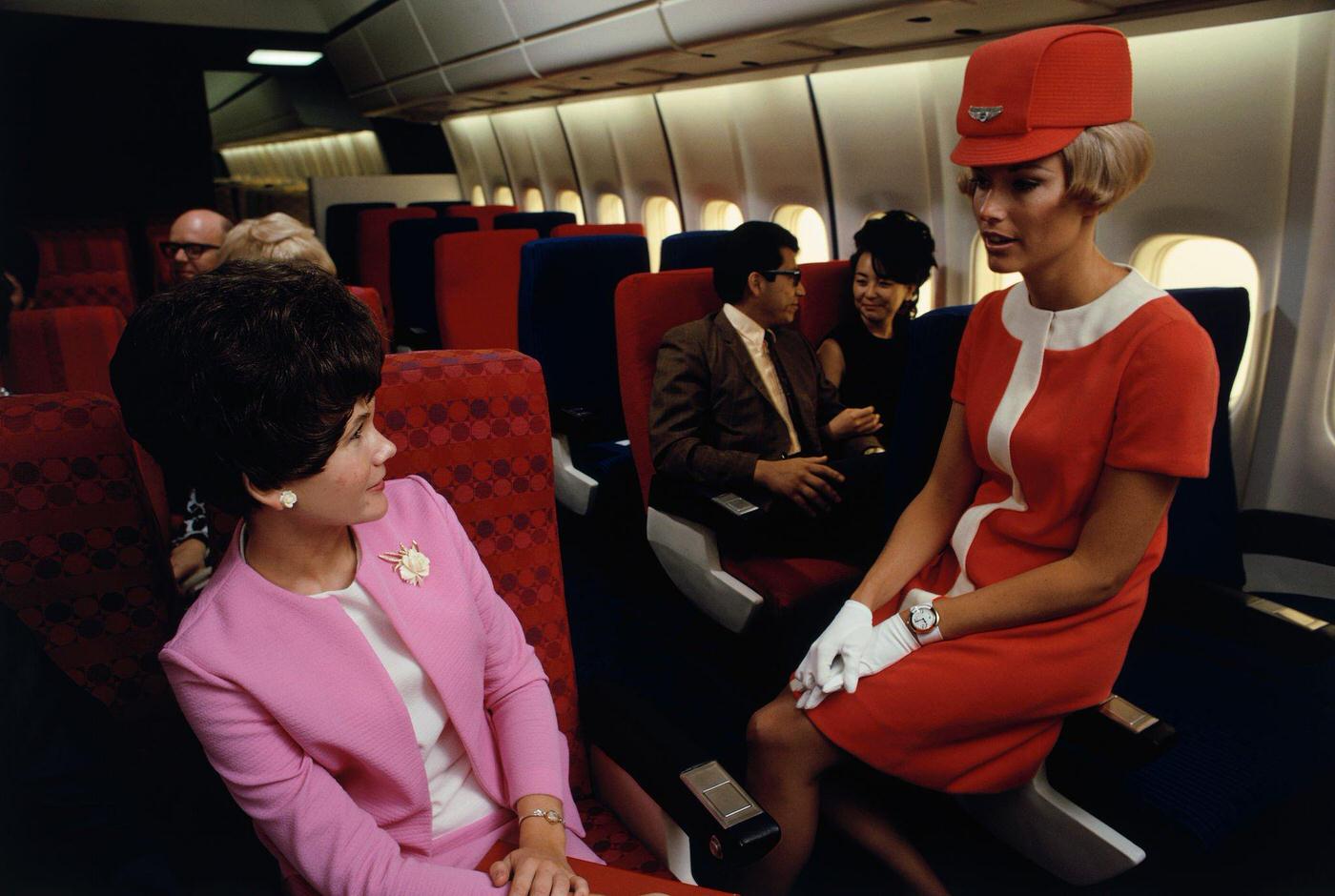
#58 Interior of a BEA Vickers airplane showing the passenger section; a stewardess is about to serve lunch. 1960.
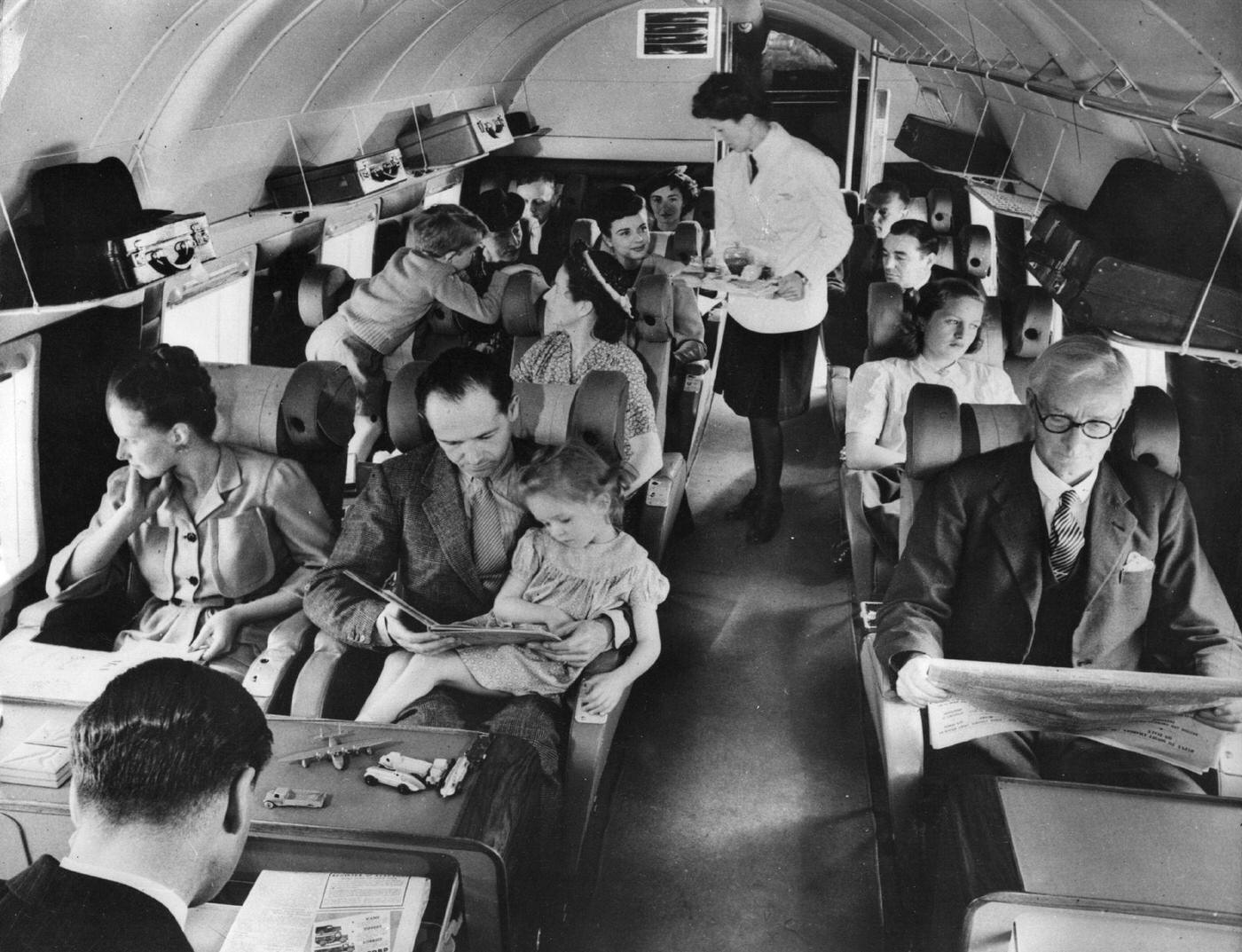
Written by Aurora Hale
I am a blogger, entrepreneur and small business coach. I'm an introvert and cat lover. My favourite hobbies are breakfast, lunch, and dinner.
Leave a Reply Cancel reply
Your email address will not be published. Required fields are marked *
Post Comment
© 2024 Bygonely
Share this Post 🥺
With social network:, or with username:.
Username or Email Address
Remember Me
Don't have an account? Register
Forgot password?
Enter your account data and we will send you a link to reset your password.
Your password reset link appears to be invalid or expired.
Privacy policy.
To use social login you have to agree with the storage and handling of your data by this website. Privacy Policy
Add to Collection
Public collection title
Private collection title
No Collections
Here you'll find all collections you've created before.
Hey Friend 🥺 Before You Go…
Subscribe to our newsletter and get the best historical content straight into your inbox.
Email address:
Don't worry, we don't spam
- Publisher’s Message
- Editor’s Notebook
- Airline News
- Airport Community
- Airport Employment News
- Airport Safety & Security
- AOA Reflections
- Company Spotlight
- Ground Services
- New York Aviation History
- Non-Rev Traveler
- Airport & Aviation Events
- Airport Employment
- Latest Issue
Subscribe for Updates
Get the latest local airport and aviation news delivered right into your inbox each week!
By signing up, you agree to the our terms and our Privacy Policy agreement.
News Updates

DH2 Chauffeured Transportation Achieves National WBE Certification

Drone Aviators of Tomorrow

Kale Logistics Solutions Welcomes Sanjeev Madavi as New Chief Innovation Officer

Travel By Air, The Golden Years: 1920s-1960s
The story of commercial air travel, in a heavier-than-air, winged aircraft, began on January 1, 1914, when the world’s first scheduled passenger service took to the skies in a single-engine Benoist flying boat piloted by pioneering aviator Tony Jannus for the St. Petersburg-Tampa Airboat Line. That morning, as a crowd of 3,000 gathered at St. Pete’s municipal pier, a ticket for the inaugural round-trip flight to Tampa was auctioned off, and former mayor Abraham Pheil won the honor with a bid of $400. Prior to lifting off from the St. Petersburg waterfront, Pheil climbed aboard the open cockpit biplane and squeezed onto a single wooden seat beside Jannus. Flying no higher than fifty feet over the water, the flight across the bay to Tampa took 23 minutes, as opposed to the two hours it would take by steamship, or the nearly 12 hours by railroad. Henceforth, the St. Petersburg-Tampa Airboat Line made two flights daily, six days a week, and charged a regular fare of five dollars per passenger. While the Airboat Line only operated for four months, it carried more than 1,200 passengers across the bay, and led the way for regularly scheduled trans-continental flights.
The Golden Age of Flight
In post-World War I, as the aviation industry grew, several commercial airlines began operations delivering U.S. Airmail, and then carrying passengers. In the 1920s and 1930s, the period between the two World Wars became known as the Golden Age of Flight. Many of the most notable early airlines were founded during this time period; Western Air Express and Ford Air Transport Service in 1925; Pan American Airways in 1927, which flew airmail from Key West to Havana, and Transcontinental & Western Airlines in 1930 (later TWA), when Western Air Express merged with Transcontinental Air Transport.
Life aboard a 1920s airliner was quite different from what it is today. Flying was a novel, upscale experience reserved for the wealthiest members of society and business travelers. Airliners carried less than 20 passengers and flew at lower altitudes in unpressurized cabins, frequently landing to refuel. Air travel was noisy and cold, and passengers wore their coats and hats to keep warm. In order to accommodate their every need, uniformed air stewards assisted passengers with their baggage and helped them board the aircraft. Onboard amenities included meals that typically included fruit compotes, cold fried chicken, and elegantly composed sandwiches served on lightweight dishware or wicker baskets. Before the advent of instrument flight in 1929, airplanes could not fly safely at night and had to circumvent mountains. Turbulence, lengthy flight times, airsickness, and other flight-related discomforts often resulted in travel anxiety. In order to keep air travelers at ease, airlines hired nurses to attend to passengers. In 1930, Ellen Church, a nurse and licensed pilot, was hired by Boeing Air Transport (now United Airlines) as the first female stewardess. Despite these discomforts, service evolved quickly in the 1930s. According to the Smithsonian National Air and Space Museum, the airline industry expanded from transporting 6,000 passengers in 1930 to over 450,000 by 1934, and 1.2 million by 1938.
The Douglas DC-3 would revolutionize commercial air travel when it had its first flight in 1935. Faster, larger, and more comfortable than its predecessors; the first DC-3, the Douglas Sleeper Transport, was the pinnacle of luxury, with plush seats in four main compartments designed to fold down from the cabin ceiling into sleeping berths. The aircraft could accommodate up to twenty-eight passengers for shorter day flights and fourteen overnight. As a reliable, economical, and profitable airliner, commercial aviation industry giants such as American, United, and TWA ordered the DC-3 for their fleets in 1936 and many other airlines followed suit in the next two years.

The 1930s heralded in many of the earliest commercial trans-Atlantic flights. Pan American Airways was a forerunner, carrying passengers across the Atlantic in their fleet of flying boats, or ‘Clipper’ aircraft. Transatlantic service began in May of 1939, first flying from Port Washington, Long Island, as the new Marine Air Terminal at LaGuardia was being built. That same year, Boeing 314s were considered the ultimate ‘Clippers’, carrying up to seventy-four passengers across the Atlantic and entering trans-Pacific service, linking all the continents in the Northern Hemisphere. The B-314 was a long-range flying boat that could land anywhere at sea, providing the destination had a sheltered harbor in which it could taxi to. But transport in the 314 was still reserved for the very wealthy, and a return ticket between Manhasset Bay in Port Washington to Southampton, England cost over $650; the equivalent of over $12,000 today.
Striving to provide the most pleasant flight experience, Pan American Airways set the gold standard of passenger service. The Boeing 314 had a large upper flight deck and a lower passenger cabin divided into five seating compartments. There was a galley kitchen, a baggage compartment, men, and women’s changing and restrooms, as well as a main lounge that converted into a dining room. White-gloved, tuxedo-clad stewards catered to their passenger’s needs. Meals were lavish experiences with gourmet foods and drink served on fine china, and silverware set on white linen tablecloths. Sleeping quarters on the 314 were roomier than earlier Clippers and its aft De Lux Compartment was called the ‘Bridal Suite’.
“I have heard many planes referred to as flying hotels, but none is more worthy of that description than the Pan American Airways Clipper.” A Wright Aeronautical Co. observer on a B-314 survey flight
First flown in 1938, the Boeing 307 Stratoliner was the first four-engine airliner with a pressurized cabin, allowing it to cruise at an altitude of 20,000 feet, well above the clouds and higher than rough weather. Pan American entered the B-307 into scheduled domestic service on July 4, 1940, with routes to Latin America, and from New York to Los Angeles. The nearly 12-foot-wide cabin carried thirty-three passengers in comfort and provided space for comfortable berths for overnight travelers, as well as observation areas for those who bought the more expensive seats. The airplane’s circular fuselage provided maximum space for five crew members and the Stratoliner was the first land-based airliner to have a flight engineer as a member of the crew.
With the onset of the Second World War, commercial air travel came to a virtual halt and was limited only to those serving the war effort. But commercial aviation, along with the aviation industry as a whole, grew substantially during wartime with the development and production of large-scale aircraft and the utilization of ex-military bombers and transports that were easily converted into commercial airliners. In the post-war years, Lockheed C-69 Constellations, used as transports by the U.S. Army Air Forces, were purchased from the government by TWA and converted into civilian airliners for their fleet. After TWA’s first transatlantic demonstration flight in the Constellation, or ‘Connie’ in December of 1945, TWA launched its transatlantic service in the Connie with a flight from New York to Paris on February 6, 1946.
The Golden Age of Air Travel
After 1945, American aircraft technology set the standard for international air operations, and toward the end of the 1940s, major carriers achieved a strong foothold on international travel.
As the decade of the 1940s ended, the era of commercial flight between the 1950s and 1960s was born and became known as the ‘Golden Age of Air Travel’ and the ‘Jet Age’. By 1950, the trans-Atlantic route became the most traveled in the world, and its growing trade produced high profits and intense competition between major international airlines. In the United States, commercial jet service began with the introduction of the Boeing 707 and Douglas DC-8. Larger and more economical than its previous airliners, Pan American began international flights on the B-707 in October of 1958. National Airlines soon began domestic jet service with the 707, and American Airlines opened its own domestic jet service in January of 1959, with a flight from New York to Los Angeles. At the end of the decade, for the first time in history, more people in the United States traveled by air than by railroad.

Despite its immense growth, air travel was still expensive and reserved for the elite – celebrities, and movie stars, who were called the ‘Jet Set,’ a name coined in the early 1950s by journalist Igor Cassini. Since commercial flight was still a unique, awe-inspiring event, passengers often documented their experience on airline postcards and posed for group photos prior to boarding. They dressed in their finest clothes, with women in dresses and heels, and men in tailored suits. First Class was spacious, and ‘economy’ seating provided up to six inches more legroom than today. With an increased market for air travel, airlines competed to outdo each other by offering their passengers extravagant amenities; in-flight entertainment, free-flowing cocktails, and fancy multi-course meals that included soup, salad, carved meats, vegetables, dessert, and even lobster. In a 1952 TWA (Trans World Airlines) ad captioned, ‘’Have dinner tonight with the stars!”, an elegantly dressed couple is depicted sitting before a lavishly set table while being served by a burgundy-coated steward and a perfectly coiffed stewardess in uniform and cap.
As the Golden Age of Air Travel led on, well into the 1960s, those who were fortunate enough to enjoy travel on the newest commercial jetliners featured some of the biggest celebrities of the day, including the Beatles, who arrived at JFK International in New York from London aboard a Pan American Boeing 707, to thousands of screaming fans, and some 200 journalists in February of 1964 ….fifty years after the first scheduled flight in the Benoist flying boat before a crowd of 3,000. And while the principles of flight remain the same, commercial air travel as we know it today may not be as lavish an experience as it once was during its Golden Days, but it certainly has come a very long way.

Experience the Golden Days of Air Travel
Today, the Pan Am Museum Foundation Exhibit at the Cradle of Aviation Museum in Garden City, Long Island pays tribute to Pan American World Airways as a pioneer in commercial aviation through the preservation of Pan Am artifacts, memorabilia, and images that commemorate the company’s history and the people behind this legendary airline.
Also today, at the TWA Hotel at JFK International Airport, visitors are welcome to view the New York Historical Society’s curated exhibitions celebrating TWA’s history. Located within and throughout the former iconic TWA terminal, designed by Eero Saarinen in 1962, the exhibits allow visitors to experience the Jet Age through authentic artifacts, interactive displays, uniforms, memorabilia, and personal narratives. Both are a must see!

Julia Lauria-Blum earned a degree in the Visual Arts at SUNY New Paltz. An early interest in women aviation pioneers led her to research the Women Airforce Service Pilots (WASP) of WW II. In 2001 she curated the permanent WASP exhibit at the American Airpower Museum (AAM) in Farmingdale, NY, and later curated 'Women Who Brought the War Home, Women War Correspondents, WWII’ at the AAM. Julia is the former curatorial assistant at the Cradle of Aviation Museum and is currently an editor for Metropolitan Airport News .
RELATED NEWS & UPDATES

Comair: One of the Original Delta Connection Carriers

JetBlue Announces First Regular Supply of Blended SAF for Commercial Air Travel in New York

Ethiopian Airlines lays a foundation for the future with SIRAX Solutions

British Airways Hath Released Its New Safety Video

dnata Expands Partnership With British Airways in USA

Stewart International Airport: Military to Commercial Transition
Such an interesting historical synopsis of commercial aviation! Well done!
In June 1967 I flew out of El Toro Marine Air Base California towards Vietnam. I returned to SF International in September 1968 via another commercial airline. As did thousands of other GIs going to Vietnam but not so many coming home. I highly recommend purchasing the book by BJ Elliott Prior titled Behind My Wings.
Thank you for comments, Robert. I look forward to obtaining a copy of Behind My Wings and reading about the GIs returning home. I have very strong visual memories of the returning veterans, and especially the POWs.
Save my name, email, and website in this browser for the next time I comment.
This site uses Akismet to reduce spam. Learn how your comment data is processed .
Type above and press Enter to search. Press Esc to cancel.
- Travel Advice
What flying was like in the 1950s and 1960s compared to now
THE 1950s and ‘60s are known as the golden age of flying. Sure, it was glamorous, but it had some pretty major drawbacks. Here’s how things have changed.

‘Failing’: Australia behind rest of the world
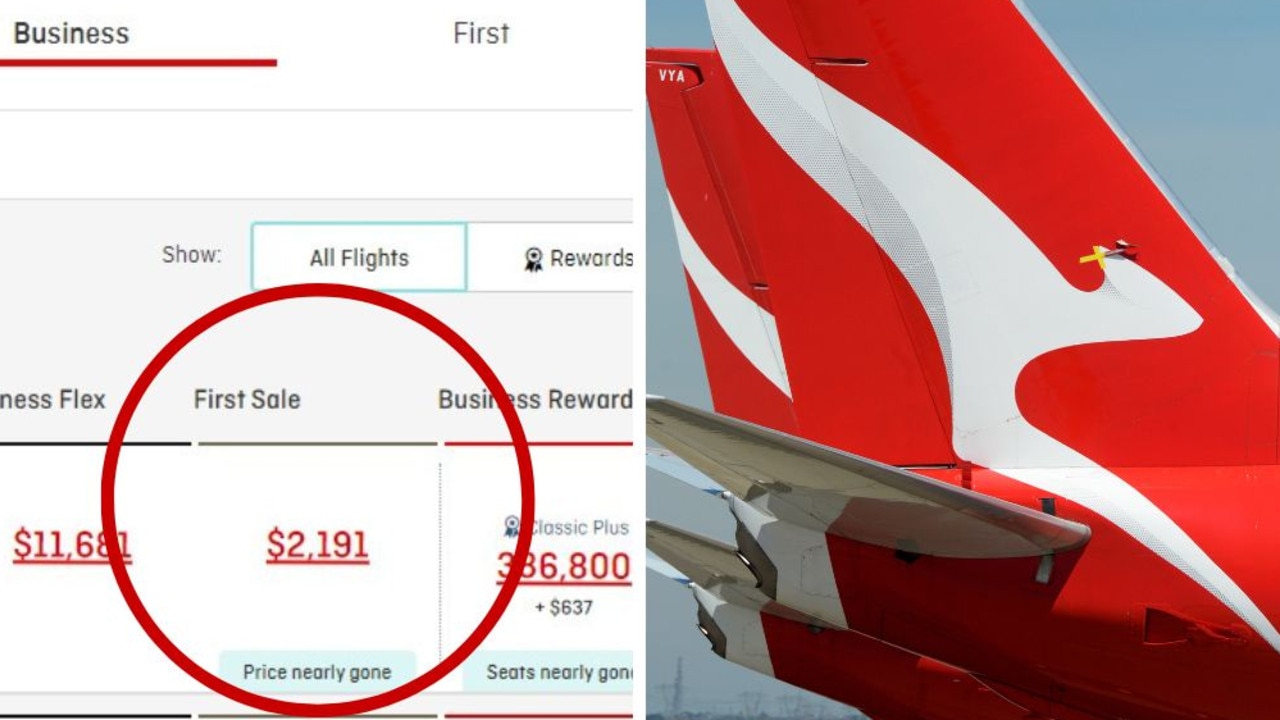
Qantas sells 300 first class fares by mistake
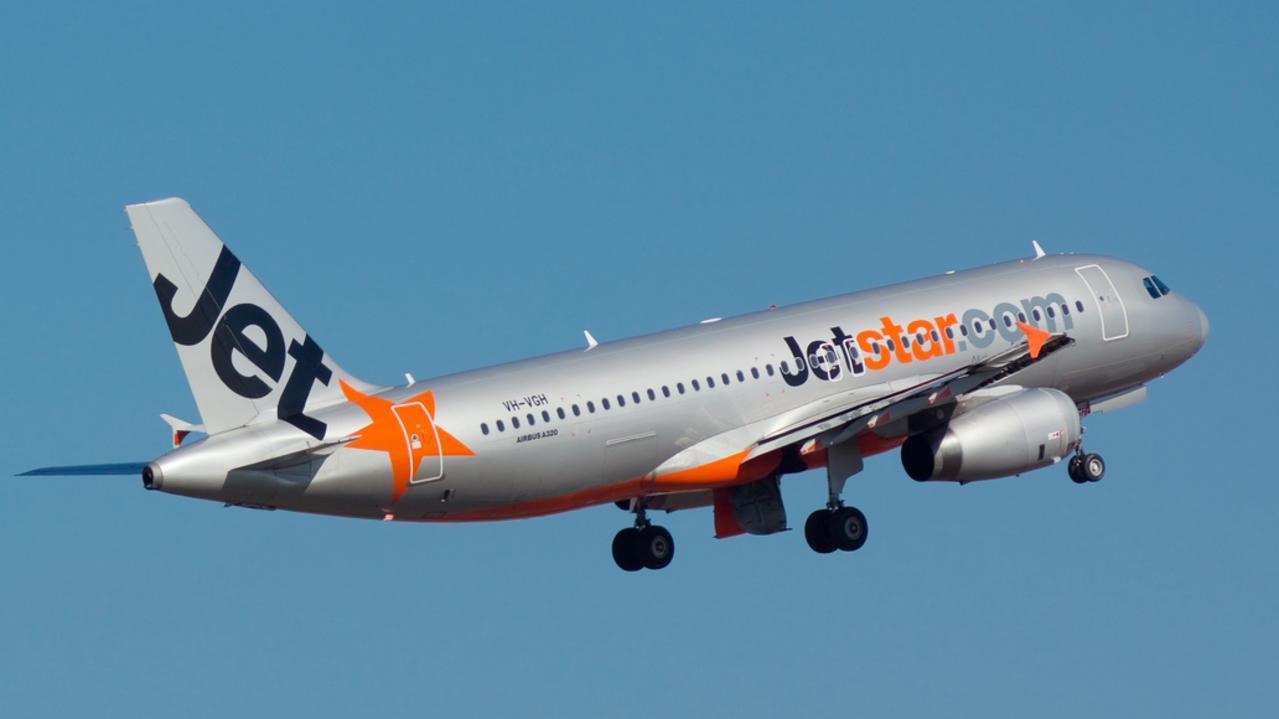
‘Finally’: Huge change on Aussie airlines
THE 1950 and 1960s have become known as the “Golden Age” of flying. It was a time of glamorous air hostesses and gourmet meals, and of great leg room for all.
But taking to the air back then had its downsides. For a start it was much more dangerous, and far more expensive.
Then there was the smoke from all those cigars, cigarettes and pipes. And, once you’d looked out of the window there was not a lot to do but twiddle your thumbs.
But there were upsides to flying back then too — like ever-flowing drinks and a party atmosphere.
HOW LONG DID IT TAKE, AND HOW MUCH DID IT COST?
When Qantas started flying from Brisbane to Singapore in 1935, to connect with the British-operated Imperial Airlines (now British Airways) for the flying boat flight to England, the total journey took around two weeks, with up to 43 stops.
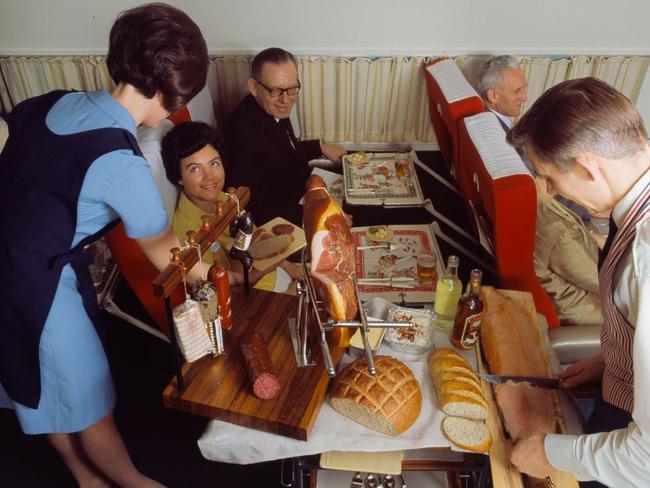
By the time Qantas introduced the Kangaroo Route from Sydney to London in 1947 the journey took four days, and included stops in Darwin, Singapore, Calcutta, Karachi, Cairo and Tripoli, and two overnight stays.
Compare that to the 22-to-23 hours it takes to fly from Sydney to London today, with just one refuelling stop, or the 17-hour non-stop flight from Perth to London due to start in March 2018 aboard a Qantas 787-9 Dreamliner .
As for cost, these days, you can pick up a return flight to London for as little as $1300, with ticket prices averaging out at around $2000.
In the 1950s and 1960s a return flight from Sydney to London was so prohibitively expensive only a few people could afford it.
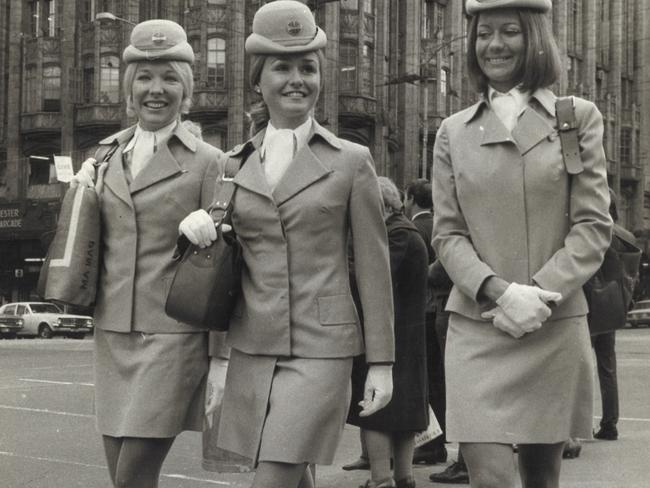
THE PLANES: THEN AND NOW
Qantas used Lockheed Constellation, and later, Super Constellation planes (with air conditioning, and reclining seats) in the 1950s on the Kangaroo Route. They had four noisy propeller engines.
In 1959 a Boeing 707 made an appearance on Qantas’s Sydney to San Francisco route — and the modern-era jet age had just begun.
Next came the Boeing 747, also known as the jumbo jet, which ushered in an era of mass travel when it made its Qantas debut in 1971. Today, of course, we can travel on relatively quiet and much more comfortable A380s, and ultra-long-distance 787-9 Dreamliners.
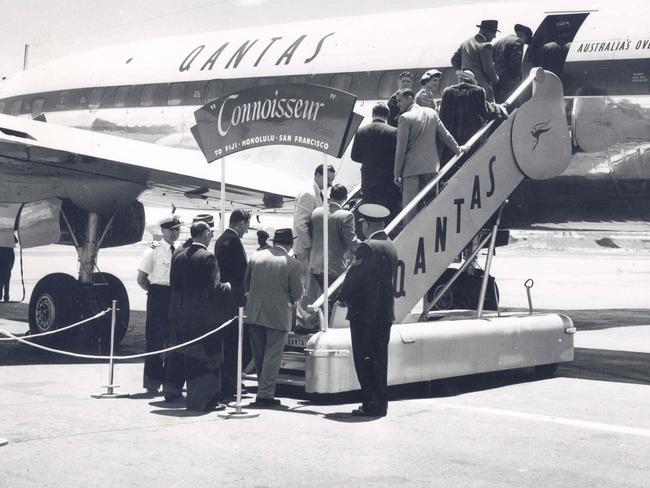
Next on the shopping list for Qantas could be either the Boeing 777X or the Airbus A350-900ULR. With these planes, non-stop flights from Sydney to London could take around 20 hours, and Sydney to New York around 18 hours.
LIFE ON-BOARD
Forget about economy, economy plus, business class and first class. Initially there was only one class — and it was pretty luxurious.
In the 1950s you might have a bed made up for you at night on some flights. You might see framed pictures on the walls.

Aisles were wider and seats reclined a lot more than they do in economy these days and you had lots of legroom.
There were endless free drinks and people could socialise in the cocktail bar with fellow Jet Setters. But the whole plane stank of cigarettes and the air was so thick with smoke you could barely breathe.
It wasn’t until the end of the 1950s that airlines started introducing tourist (or economy) class, and things started to go downhill .
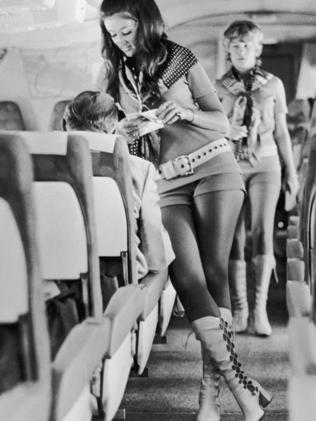
WHAT PEOPLE WORE
T-shirts, tracksuit pants, hoodies, shorts, thongs, doughnut-pillows affixed to your neck — almost anything goes on today’s flights , but back in the Golden Age of air travel things were very different.
Almost everyone wore their finest clothes to travel. In the 1950s men wore three-piece suits and sombre ties, and women wore dresses, high heels and pearls.
Things relaxed a bit in the 1960s, when a man could get away with a polar-neck shirt or a flowery tie, and a woman could wear hippie beads and a fashionable scarf.
In the 1950s, air hostesses were like movie stars. They were selected for their looks and there were regulations on how much they could weigh.
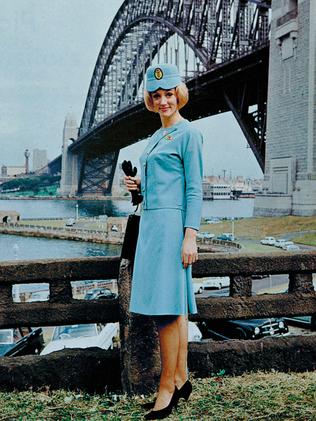
They had to be single too. And they wore body-sculpted uniforms, corsets, and sometimes white gloves. And always a hat.
Adding to flying’s image of glamour and excitement, hem lines rose to miniskirt length and colours brightened as the 1960s wore on.
THE FOOD AND DRINK ON-BOARD
In the 1950s and 1960s flying was an expensive thing and you expected food and drink to match.
Forget a can of beer or a miniature plastic bottle of wine, back then champagne and brandy flowed endlessly and a flight seemed like a cocktail party in the sky.
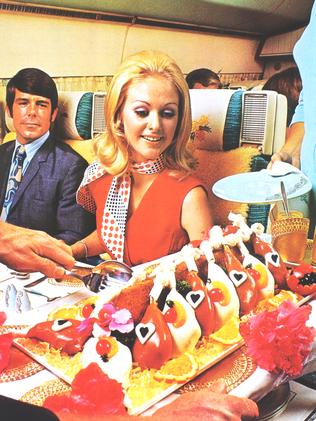
There was lobster, and beef carved as you salivated, and buffet tables instead of a packet of peanuts. You also were given a nicely-folded napkin.
Some meals lasted for three hours. Oh, for the good old days.
IN-FLIGHT ENTERTAINMENT
These days we have state-of-the-art in-seat entertainment systems to keep us occupied, as well as iPads, Kindles, game consoles and more.
Qantas has even announced that it will be providing free Wi-Fi, Netflix, Spotify and Foxtel on its domestic flights this year.
Back in the 1950s and 1960s you had hours of boredom to look forward to. To break the monotony you could read a book, or a newspaper. You could smoke another cigarette and have yet another glass of booze.
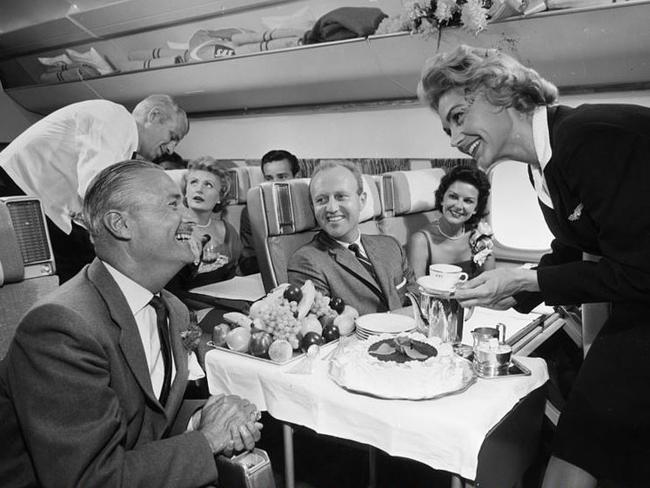
Or you could describe your flight to your friends back home on postcards provided by the airline, often with a picture of your plane or in-flight meal on the front.
BUT WHAT ABOUT SAFETY?
Statistically, you have a much better chance of surviving a flight now than you did in the 1950s and 1960s, when crash landings, injuries from turbulence and midair collisions were much more common.
There were sharp edges in the cabins, glass partitions, inferior seat belts, worse pilot training, and inherent mechanical problems.
But at least you didn’t have the hassle of today’s strict airport security to deal with.
This article originally appeared on Skyscanner.com.au .
Aviation experts have described the shake-up to the industry as “disappointing” saying it shows where Australia is falling behind.
Aussies have snapped up hundreds of long-haul first class fares for just $4300 return – but it is not as it seems.
It’s something Aussie passengers have been waiting a very long time for following a massive move that will see airlines forced to compensate customers.
Longing for the ‘golden age’ of air travel? Be careful what you wish for
Professor of History, University of Dayton
Disclosure statement
Janet Bednarek does not work for, consult, own shares in or receive funding from any company or organisation that would benefit from this article, and has disclosed no relevant affiliations beyond their academic appointment.
University of Dayton provides funding as a member of The Conversation US.
View all partners
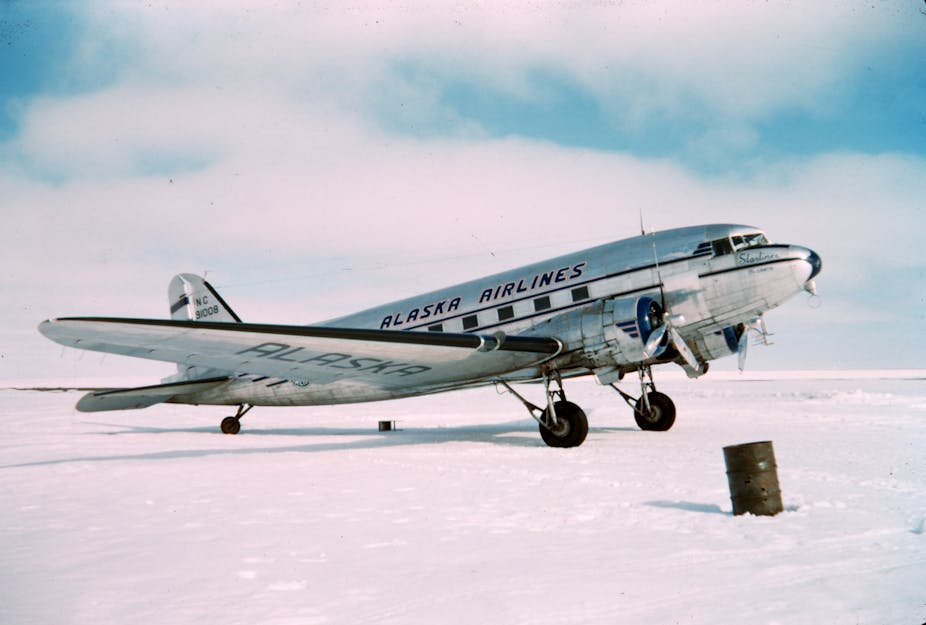
Long lines at security checkpoints, tiny plastic cups of soda, small bags of pretzels, planes filled to capacity, fees attached to every amenity – all reflect the realities of 21st century commercial air travel. It’s no wonder that many travelers have become nostalgic for the so-called “golden age” of air travel in the United States.
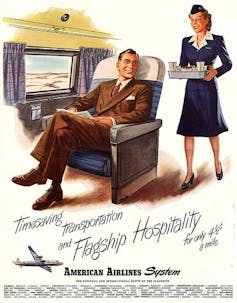
During the 1950s, airlines promoted commercial air travel as glamorous: stewardesses served full meals on real china, airline seats were large (and frequently empty) with ample leg-room, and passengers always dressed well.
After jets were introduced in the late 1950s, passengers could travel to even the most distant locations at speeds unimaginable a mere decade before. An airline trip from New York to London that could take up to 15 hours in the early 1950s could be made in less than seven hours by the early 1960s.
But airline nostalgia can be tricky, and “golden ages” are seldom as idyllic as they seem.
Until the introduction of jets in 1958, most of the nation’s commercial planes were propeller-driven aircraft, like the DC-4. Most of these planes were unpressurized, and with a maximum cruising altitude of 10,000 to 12,000 feet, they were unable to fly over bad weather. Delays were frequent, turbulence common, and air sickness bags often needed.
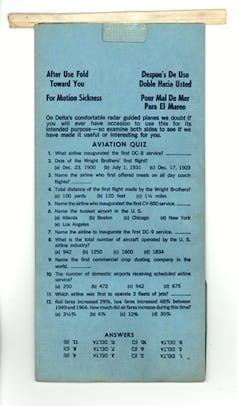
Some planes were spacious and pressurized: the Boeing Stratocruiser , for example, could seat 50 first class passengers or 81 coach passengers compared to the DC-3’s 21 passengers. It could cruise at 32,000 feet, which allowed Stratocruiser to fly above most bad weather it encountered. But only 56 of these planes were ever in service.
While the later DC-6 and DC-7 were pressurized, they still flew much lower than the soon-to-appear jets – 20,000 feet compared to 30,000 feet – and often encountered turbulence. The piston engines were bulky, complex and difficult to maintain, which contributed to frequent delays.
For much of this period, the old saying “Time to spare, go by air” still rang true.
Through the 1930s and into the 1940s, almost everyone flew first class. Airlines did encourage more people to fly in the 1950s and 1960s by introducing coach or tourist fares, but the savings were relative: less expensive than first class, but still pricey. In 1955, for example, so-called “bargain fares” from New York to Paris were the equivalent of just over $2,600 in 2014 dollars. Although the advent of jets did result in lower fares, the cost was still out of reach of most Americans. The most likely frequent flier was a white, male businessman traveling on his company’s expense account, and in the 1960s, airlines – with young attractive stewardesses in short skirts – clearly catered to their most frequent flyers.
The demographics of travelers did begin to shift during this period. More women, more young people, and retirees began to fly; still, airline travel remained financially out-of-reach for most.
If it was a golden age, it only was for the very few.
People also forget that well into the 1960s, air travel was far more dangerous than it is today. In the 1950s and 1960s US airlines experienced at least a half dozen crashes per year – most leading to fatalities of all on board. People today may bemoan the crowded airplanes and lack of on-board amenities, but the number of fatalities per million miles flown has dropped dramatically since since the late 1970s, especially compared to the 1960s. Through at least the 1970s, airports even prominently featured kiosks selling flight insurance.
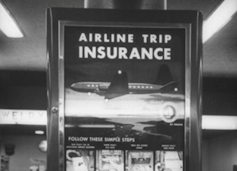
And we can’t forget hijackings. By the mid-1960s so many airplanes had been hijacked that “Take me to Cuba” became a punch line for stand-up comics. In 1971 D.B. Cooper – a hijacker who parachuted from a Boeing 727 after extorting $200,000 – might have been able to achieve folk hero status. But one reason US airline passengers today (generally) tolerate security checkpoints is that they want some kind of assurance that their aircraft will remain safe.
And if the previous examples don’t dull the sheen of air travel’s “golden age,” remember: in-flight smoking was both permitted and encouraged.
- Advertisement
- Flight mechanics
- Plane Facts

Project Manager SSTP

Head of Evidence to Action

Supply Chain - Assistant/Associate Professor (Tenure-Track)

OzGrav Postdoctoral Research Fellow

Casual Facilitator: GERRIC Student Programs - Arts, Design and Architecture
The golden age of travel? Here's what it was really like to fly in the 1950s

CORRECTION: A previous version of this story incorrectly stated that Boeing produced the DC-8 aircraft in the 1950s. In reality, Douglas made the DC-8. It wasn't until 1997 that Boeing merged with the DC-8's creator (then known as McDonnell Douglas after a separate merger in 1967).
We've traveled backwards against the tailwinds of time in recent weeks, revisiting what it was like to fly in the birth of the commercial airline industry in the 1930s and then looking back on how innovation and industry really began to pump the gas in the 1940s . Now we get along to the real meat and potatoes (carved by hand and served on fine china in first class, naturally). Welcome to the golden age of commercial aviation! This is what it was like to fly in the 1950s:
Welcome to The Jet Age. The Boeing 707 made its first flight on December 20, 1957, and was put into commercial service the following October by Pan Am. Boeing had dedicated $16 million in the 50s to develop a commercial jet of its own following the tragic British de Havilland Comet midair explosions. At $142,807,547.16 with today's inflation, Boeing president William Allen is said to have bet the company on the jet's success, putting up nearly the entire profit that Boeing had earned since the end of WWII. And you know what? It worked. Boeing may have made the 707, but the 707 also made Boeing , and continued to be sold until 1994.
At 100 feet long, the 707 possessed the largest cabin ever created, infinitely customizable by Boeing for any airline that had the cash and vision to create an enviable seating layout. Long-range variations were built to cross the Atlantic. High altitude 707s were built for airlines flying in South America. But one thing all 707s had in common were round windows. The unsafe square windows of the Comet had nearly ended the Jet Age before it had begun.
Adult supervision required. With air travel eclipsing train and boat travel in the 50s, it was finally decided that someone ought to be policing this booming industry. In November of 1958, the Federal Aviation Administration (FAA) was born , and Elwood R. Quesada got to work building the network of air traffic control towers and unified flight tracking systems that continue to serve our aviation industry today.
A chance to catch up on your correspondence. The high-tech in-flight entertainment of the 50s was really just a stack of postcards . Flight attendants handed endless amounts of cards bearing pictorials of say, the California coast with the airline's logo emblazoned in a corner, out to passengers during boarding, and then people really did just sit there and write to their loved ones.
Scandal in the skies! An ambitious attempt to restructure the U.S. mail delivery apparatus in the 1930s embroiled much of the aviation industry in career-ending, merger-inducing scandal for decades to come. In an attempt to garner incredibly lucrative government contracts that paid airlines not by the weight of the mail they carried, but by the amount of space potentially available within their planes, some of the industry's biggest players merged to create regional monopolies. By the 1950s, these carriers were now operating national route maps and dominating the industry.
The scandal in effect brought about or had lasting repercussions on Eastern Airlines, Pan Am, American Airlines, United Airlines and Transcontinental & Western Air — better known as TWA. In fact, much of the shuffling about on our comprehensive list of airline mergers over the decades was put into play by the Airmail Scandal.
The blueprint for low-cost carriers. We remember Pan Am through a particularly glamorous lens and with the same warm nostalgia that bubbles up at the site of vintage travel posters. But perhaps what the airline ought to be most remembered for was the democratization of air travel. Pan Am introduced the world's first "tourist-class" tickets (so that's where Andie MacDowell got that from) in 1948 between New York and San Juan. Tourist-class seats on planes were placed closer together into something resembling today's economy class, but dubbed the much more affectionate Rainbow Class .
The offering was a sensation, and quickly duplicated with routes across the Caribbean and Latin America in the early 1950s. By 1955, Pan Am was flying more than 1 million passengers across Latin America, propelling the airline to an operating revenue of $238,100,000 . That's more than $2 billion when adjusted for inflation. The tourist-class model would, decades later, be emulated across the entire route portfolios of airlines like Southwest and Spirit.
The (other) fear of flying. It's easy to forget in the baby-proofed, ADA compliant, ergonomically designed world we live in today that it wasn't so long ago that the world surrounding us was designed without our safety in mind. In the 1950s, first class was separated from the rest of the cabin with a glass wall — stunning and minimalist, I'm sure, but also fragile and prone to shattering in flight, spraying passengers with crystalline shards of terror and danger. Just walking to the bathroom could lead to death in the 50s, when a turbulent stumble could bring passengers crashing down on sharp edges or cabin interiors built without safety in mind. And worse yet still, midair collisions in the 50s weren't an entirely uncommon occurrence.
Smoke 'em if you've got 'em. Smoking was practically de rigueur during flights in the 50s — and not just old-timey cigarette brands like Chesterfields and Viceroys, either! Passengers puffed away on in-flight pipes and cigars, reeking havoc upon many a non-smoker's lungs and attire. More than half of all men and a third of women were regular smokers in the 50s, and they were welcome to do so when flying. Though strangely, passengers weren't permitted to light up within the airport, where it was feared their cigarettes might ignite the fumes emitting from planes as they were refueled.
- Our Campaigns
Were the 50s and 60s really The Golden Age for air travel?
The 50s and 60s are often referred to as ’The Golden Age‘ of air travel. Commercial aviation had existed before the second world war, but it really got into its stride in the 50s. It was new, exciting and for some years, an exclusive way to travel. Aircraft designs were developing fast (not all were successful – some were disastrous); the destinations were exotic, and the passengers often glamorous. The pilots, many of whom had flown in the war, were respected professionals living a life many envied.
My career as a commercial pilot began in 1958 with British Overseas Airways Corporation (BOAC) and spanned 44 years until 2002. (I had learnt to fly whilst at school and gained my RAF ‘wings’ during two years of National Service). Thus, whilst I was part of that ’golden era‘, my career lasted well into the ‘modern age’.

Exclusivity brought several benefits to air travel 60-odd years ago. Tickets were costly leading to fewer passengers and more space and legroom even for the ‘cheap seats’. The ratio of cabin crew to passengers was much higher and the ‘air hostess’ treated passengers as the airline’s guests. These sometimes-formidable ladies, were able to lavish attention on the 70 to 100 passengers. The service was complimentary and to very high standards. In first class meals were actually cooked on board and achieving a soft-boiled egg for breakfast was a great art in a cabin at an equivalent pressure height of 8,000 feet.
Post-war aviation fell at time of great innovation and design. Everything about air transport felt the effect of this rapid development, from the machines we were flying to the way the cabin looked. From the outfits the cabin crew wore, through to the silverware and china the passengers used all were top-of-the-range. The passengers actually ‘dressed up’ before they travelled – no tracksuits then!
However, to remember those early days as a vintage travel brochure come to life would be incorrect. Compared to now, air travel in the 50s and 60s was not only expensive, but was also potentially dangerous, sometimes smoky, and at times boring. The Golden Age certainly had its downsides.
For Golden Age passengers a significant hurdle was expense. I recall an item in a Qantas inflight magazine which suggested that, in the 60s, a worker on the average Australian wage would need to work for three months to pay for a flight from Sydney to London. The equivalent time today would be measured in one or two weeks.
It was an era before package holidays and the rise in low cost airlines. An air ticket was just too expensive for most people. Later the advent of the ‘wide bodies’, led by the Boeing 747 and followed by the Lockheed Tristar and Douglas DC10 produced many more seats at a substantially lower operating cost. All those extra seats needed to be filled and airlines started to offer discounted fares. More recently, South West Airlines in the USA developed the concept of the ‘budget airline’ where costs were reduced to a minimum and passengers were provided with little more than a seat with everything else requiring extra money.
In-flight activities
Another feature of 1950s-60s flying was boredom. Journeys took a long time, often with many stops en-route. Once the view from the window had been admired there was not all that much to do. Time could pass slowly but snoozing and the inflight meal service provided welcome breaks. Magazines and newspapers were provided to passengers, and a good long book was useful. The fortunate found themselves sitting next to someone with interesting conversation. Inevitably there was also drinking and smoking.
Smoking and drinking
On a flight from London to New York the cliché joke was: “When you can’t see across the flight deck we must be close to top of descent”! Smoking was allowed on the flight deck as well as the cabin – cigarettes, pipes and even cigars were allowed once in flight. After an eight-hour flight, during which there was little else for passengers to do but snooze, read, chat, drink and smoke, the atmosphere became fairly rich.
Alcohol on board was free and drinking and chatting was good entertainment. Some passengers did have too much to drink and the elevated cabin altitude made alcohol more potent. Remarkably it was quite rare for there to be drunken behaviour – the age of drunken airborne stag and hen parties was long in the future.
Today passengers can rest assured that air travel in an established airline is the safest form of public transport. In fact, figures out last week hailed 2017 as the safest year in history for commercial airlines. It is no wonder. Modern safety levels far exceed those of the 1950s and 1960s, when crash landings, structural failures, injuries from turbulence and mid-air collisions were prevalent. At current safety levels, you would need to be continuously airborne for two and a half average lifetimes of 75 years, to be statistically liable to be involved in an accident!
Back in the 50s and 60s the aircraft technology was new and rules and regulations about safe operation and maintenance were also emerging. The International Civil Aviation Organization (ICAO) was founded in 1944 and its rules, procedures and regulations were starting to have effect. During the First World War aviation developed a virtuous safety circle. When an accident or even a serious incident happens, it is thoroughly investigated in detail and the causes established. Recommendations for improvements in design, operating procedures or crew techniques are published. These are then adopted for future aircraft designs, operating procedures and crew drills. Aviation has been continually learning lessons from the past and other safety critical industries are starting to copy it.

In the 50s and 60s some (not all) of the wartime pilots operated in their own, often eccentric, styles. The advent of Crew Resource Management (CRM) has ensured all pilots, no matter how senior, operate in a similar manner and to common standards. CRM also ensures that all members of an aircraft crew are equally aware of safety requirements.
Learning from the bitter lessons of past accidents, cabins have been redesigned with safety in mind. In the 50s and 60s luxury and style were the priority; there were hard, sharp edges, flammable seats and furnishings, even glass dividing screens. Modern cabins have improved seating standards, seatbelts, overhead lockers, lighting etc. making the cabin a much safer place in an accident.
Airline management styles
The race to reduce costs has had adverse effects on aviation. In some cases, modern airline managements regard staff as ‘production units’ with the emphasis on maximum work for minimum cost. This attitude bears down particularly hard on flight crews often operating under stressful circumstances and on fatiguing schedules.
Managements in the 50s and 60s were more benign. In BOAC the main working unit in operations was the fleet. Each aircraft type had a flight manager who was responsible for not only the flight deck crews but also the cabin crew on that type. He also liaised with the hangar floor. There was a department called ‘personnel’ but it had nowhere near the power and influence of human resources. BOAC even had a medical department dedicated to maintaining the good physical and mental health of its flight deck and cabin crews.
The result was that each aircraft type was operated by a fairly cohesive group, often well known to each other. The relatively small fleet size encouraged this, and the effect of this crew bonding was apparent in the way the passengers were treated. With Flight Time Limitations in their infancy, crews would often voluntarily substantially extend duty hours.
In the days of open flight deck doors, the captain and flight deck crew were very much part of the PR process and, at the captain’s discretion, flight deck visits were generally encouraged. There was even a ‘Junior Jet Club’ and its young members were eager to get their ‘log book’ signed by the captain.
The rewards of the job
For my first year of employment – spent mostly on the ground doing a mini university course on Navigation, BOAC paid me just £50 a month – as a ‘cadet pilot’. Once qualified the salary rose slowly but steadily with seniority and rank. However, when, after 18 years I achieved my first command on the Boeing 747 my salary did not exceed £7,000 pa by Government command.
Under the rules of the 19th century Railways Act airlines had to provide both free accommodation and sustenance to crew when away from base. Some accommodation was fairly basic, such as the BOAC rest house in Karachi which was a converted barracks for the 19th century British Army of India. But later, in Singapore we stayed in the Raffles, then rather run down, but still splendid. In most places meals were free but taken at the accommodation. Because of this the crew’s cohesion was actually improved by eating together. Initially only on the North Atlantic routes, were crews were given cash allowances – in the 50s this was (US)$10 per day.
One other oddity in BOAC was the policy at some destinations of having the flight deck and cabin crews staying in different hotels. Indeed, in other places the captain would stay in yet another (superior) hotel, although the more sociable captains would trek across town to join their crews.
Was it a Golden Age?
It was not a mass transport industry. There was more time, more attention, more space and more glamour than today. Some might say of the passengers that unless you were a chain smoking, alcohol swigging bookworm, then flying in a sealed aircraft breathing second hand smoke was not the most pleasant way to travel. But that would be unfair, passengers were treated very much as individuals and properly considered with all that this implies. They probably disembarked in a better frame of mind than today’s tightly packaged people.
In this so-called Golden Age the crews were also treated more as individuals and cared for, in all respects. The financial rewards in the cabin and the junior ranks of the flight deck were not immense, although the senior captains were comparatively well off. But all were part of a relatively new and exciting travel industry. Above all it was FUN.
Was it a Golden Age? On balance maybe not – perhaps just silver.
More News & Views
Bristow pilots and technical crew accept pay deal, balpa welcomes government’s ambition to make aviation more accessible, balpa welcomes the end to ‘fire and re-hire’, navigating political shifts and seizing opportunities in aviation , balpa sends message of solidarity to aer lingus pilots, balpa calls on politicians to support its aviation manifesto, acas: a mediator, not a magic bullet, response to bristow helicopters question in parliament.
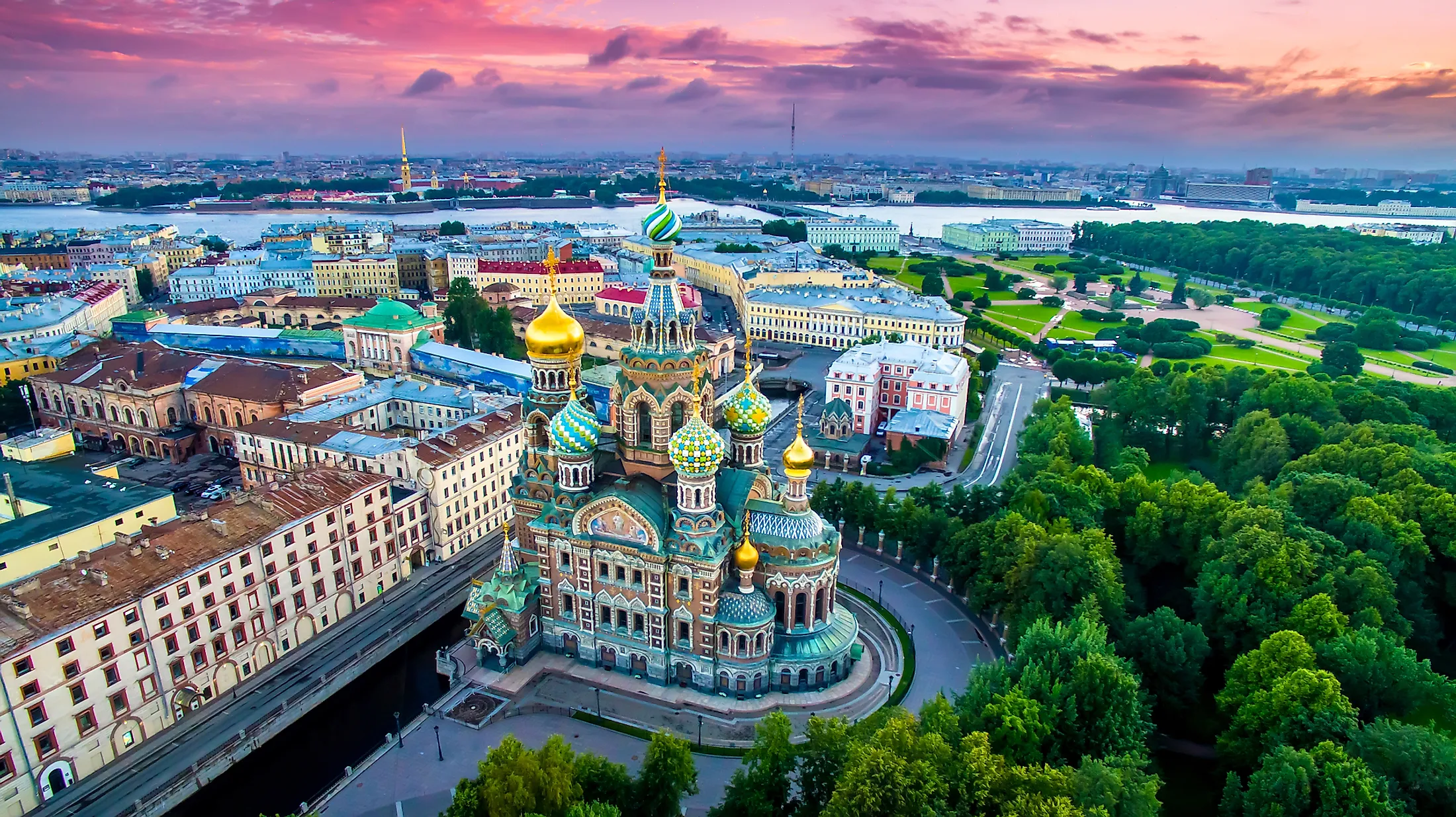
- Saint Petersburg
Sankt-Petersburg in nativity, Petrograd from 1914 to 1924 and Leningrad until 1991, is adorned by Russians and global tourists alike. This port-bound metropolis, located in the extreme northwest of the largest country in the world, Russia , comprises a major historical and cultural mecca, with an area of 550 square miles (1,400 square km). As the former day capital of the Russian Empire (from 1712 to 1918), this, Russia's second-largest city, lies some 400 miles (640 km) northwest of Moscow and only about 7° south of the Arctic Circle. Architecturally magnificent, state-of-art St. Petersburg is remembered for the Russian Revolution and is commemorated for its fierce defense during the Second World War.
Landscape And Climate Of St. Petersburg
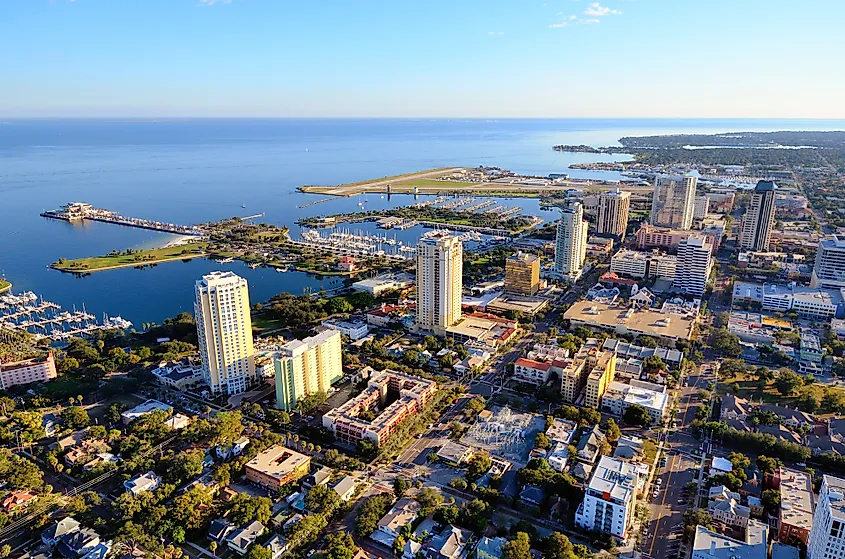
Sitting at a very low elevation, in the vicinity of the mainland floodplain, it is no surprise that the originally marshy site makes the city subject to frequent and recurrent autumn and spring floods, with cyclonic winds driving the gulf waters upstream. Severe cases of flooding occurred in 1777, 1824, and 1924. The city has built an 18 mile (29 km) long dike across the Gulf of Finland and cut numerous canals to assist the drainage to avoid such disasters.
Although the harsh winter temperatures can occasionally drop below 40 °C, the Atlantic Ocean has blessed St. Petersburg with a milder climate, despite its northern location and proximity to the Arctic Circle, with the mean January temperature being around -6 °C. The city sees varying degrees of snow cover for some 132 days of the year, while the Neva river begins to freeze in mid-November, with the last ice breaking up in April. The moderately warm and wet summers see temperatures of around 65 °F (18 °C) in July, while the yearly mean precipitation is around 25 inches (634 mm).
Layout Of St. Petersburg
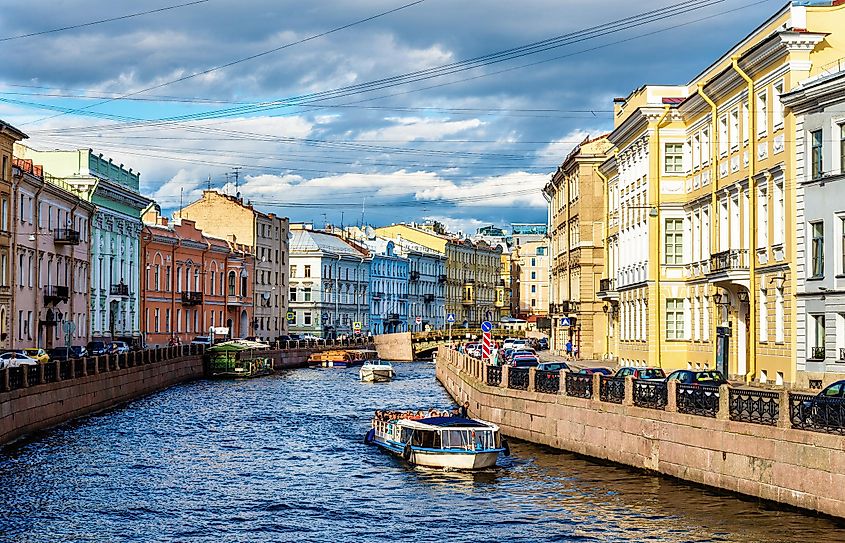
Set in the Neva River's delta at the head of the Gulf of Finland, 42 islands spread around the delta to comprise the city of Saint Petersburg. Much of the cultural and historical identity of the horseshoe-shaped Greater city is centered on the Admiralty Side, being the nucleus of the Tsar's original city, and containing an elegant spire topped by a weather vane in the form of a ship, as its principal landmark. East of there, the grand Palace Square has the 600-ton Alexander Column made of granite. The famed Winter Palace is the former main residence of the tsars, lying between the square and the river. It is a Baroque masterpiece built in eight years from 1754 to 1762, with dazzling-of-luxury exterior and interior. Destroyed by a fire in 1837, with only the adjoining Hermitage, a treasury of paintings and sculptures, and an art collection of worldwide significance that was the private holdings of Tsarina Catherine II, surviving, the palace was restored almost identically, just two years after.
The river divides central St. Petersburg into four sections, while the Nevsky Prospekt, the main avenue, extending from the Admiralty to the Moscow Railway Terminal, is considered the city center. The Admiralty Side is on the south left bank of the Neva, where the river is also called the Bolshaya or Big Neva. In between the Bolshaya Neva and the river's other main arm, the river's other main arm, the Malaya or Little Neva, is the Vasilyevsky Island. Between the latter and the north right distributary called the Bolshaya Nevka is the Petrograd Side island group, and east of the Bolshaya Nevka is the Vyborg side, just north of the Neva proper.
Notable Sites And Communities In Petersburg
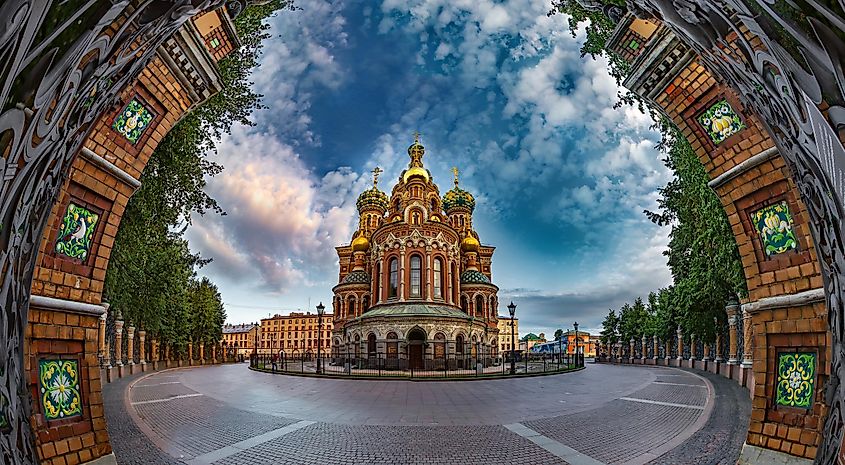
The Nevsky Prospekt contains the Pushkin Academic Drama Theatre, the Stroganov, Shuvalov, and Anichkov palaces, the St. Peter's Lutheran Church (1833–38), as well as the St. Catherine's Roman Catholic Church (1763–83) and Kazan Cathedral (1801–11). Gostiny Dvor (1761–85), an irregular-square former mercantile center that opens up onto four streets, is also there, as is the Alexander Nevsky Square, at the eastern end of the Prospect, in the embrace of gardens.
Many natural channels cut through the Admiralty Side, including the Griboyedov and Obvodny canals and the Moyka and Fontanka rivers. Downstream from the northern entrance of the latter is a beautiful open space, known as the Field of Mars, intended for popular festivities and fireworks. Extreme east to the center within the sharp bend of the Neva is the Smolny complex of a former convent containing a five-domed cathedral and the Smolny Institute, which was designated Lenin's headquarters in 1917. Further east on the island, the Summer Garden contains more than 250 statues made by Venetian masters, with the Summer Palace, Peter's first building project in the city, also on its territory.
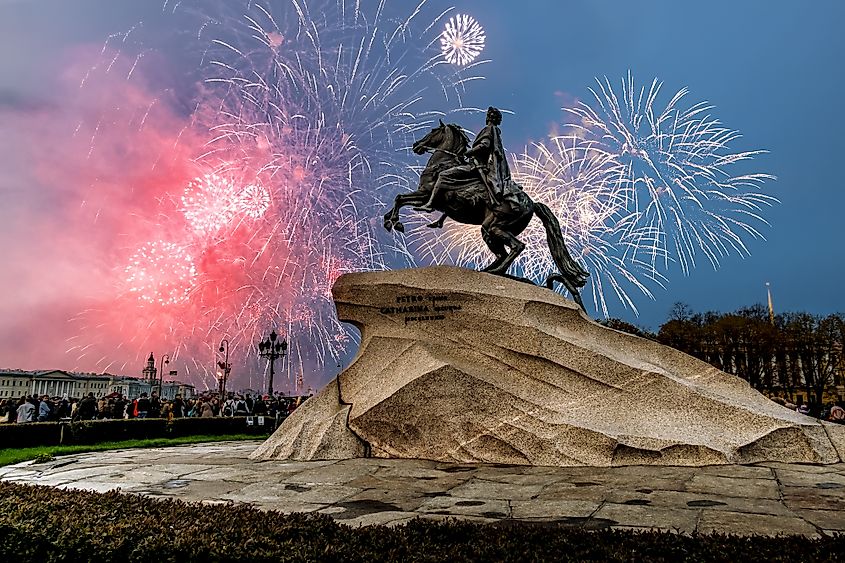
Peterhof, a unique garden-park that contains works from two centuries of Russian architectural and park styles as well as The Great Palace itself, is one of the most famous communities with stretching terraces rising above the Gulf of Finland. The Pushkin town, or the former Tsarskoye Selo, is a beautifully decorated large space containing the Catherine Palace, with the Amber Room of Russian Baroque style at its peak. The former country residence for Tsar Paul I in the south, Pavlovsk, contains the central Great Palace built over 64 columns, while Gatchina community with the namesake Park, full of monuments, sculptures, and gardens, was Catherine's favorite.
Zelenogorsk, to the north of the city, is a recreation and relaxation suburb set among extensive coniferous forests. Bordered by fine beaches and sand dunes, and surrounded by a collection of dormitory towns, resorts, sanatoriums, and children's camps, some of the upper-class city dwellers also have their summer cottages or dachas there.
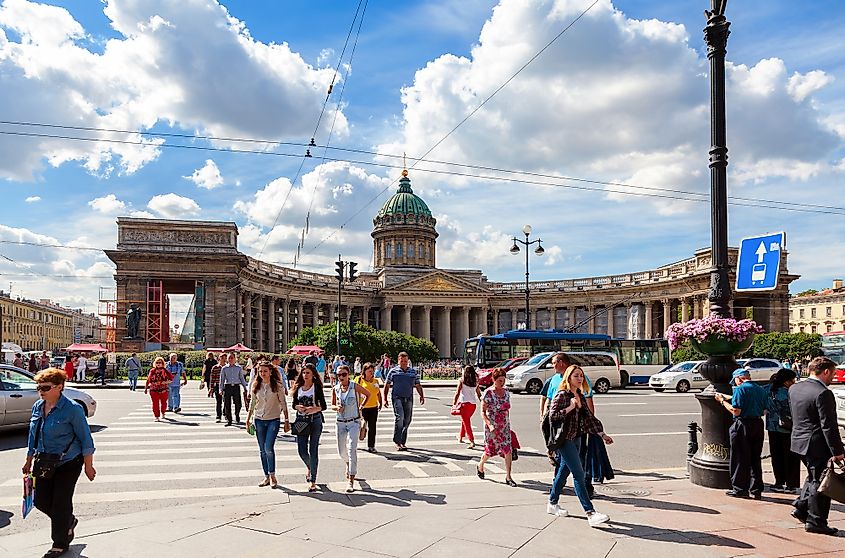
The population of St. Petersburg is overwhelmingly Russian, whereas prior to the Revolution there were sizeable communities of Polish, Baltic, and German people, as well as smaller groupings of Tatars, Jews, and Chinese, who emigrated soon after 1917, for remaining in the city made them subject to Joseph Stalin's purges as alleged "enemies" to be sent to the prison camps in the 1930s. Although hate crimes against different-looking nationalities were popular even in the post-soviet period, they have declined in the last decade and a half, with the more tolerant and open-minded generation of the new century inhabiting the city that is designed a cultural mecca.
Cultural Life In St. Petersburg
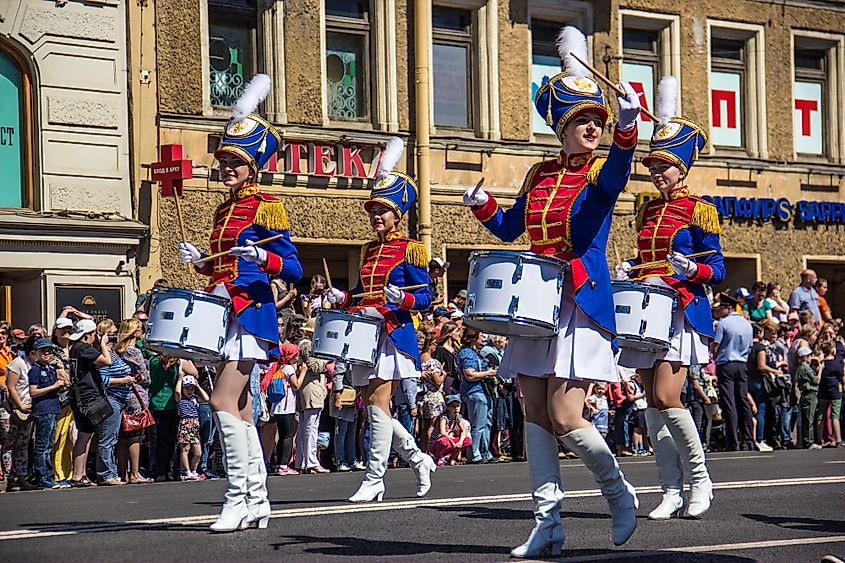
St. Petersburg has some of the most known cultural attractions in the world, including The Mariinsky Theatre, of international reputation, whose company is frequently on tour abroad, and the October Great Concert Hall that sits some 4,000 people. The reputable museums, the Hermitage and the State Russian Museum, are both of international prominence, while the outdoor recreational sites include the Kirov Park of Culture and Rest, the zoo, and botanical gardens.
Having been found by Peter the Great as Russia's "window on Europe," Saint Petersburg is a definitive cultural capital of Europe that is to the east, although in a long-lasting competition with Moscow. The equal mix of western European and Russian architecture, the ultra-developed riverside historic embankment containing many of the city's most famed architectural sites, as well as the "White Nights" from June 11 to July 2, with over 19 hours of daylight, give St. Petersburg an upper hand as the top acclaimed characteristics of the city.
Economy Of St. Petersburg
While during the late Soviet era, more than half of the city's population labored in factories, that number has fallen to one-fifth post-USSR, with the rest mainly working in the service industry. After a decade of decline, by the early 21st century, St. Petersburg's economy was growing faster than Russia's as a whole, with the industrial output also booming more than ever and new industries emerging while older ones were being revived.
Today, St. Petersburg is only outperformed industrially by Moscow. Its most prominent industries evolved from mechanical engineering and metalworking of the late 20th century to engineering that requires a skilled labor force. The original shipbuilding industry also remains an important pillar of the economy and one of the country's largest in this port city. Plants producing nuclear reactors, electrical and power machinery, cable, diesel engines, batteries, generators, medical equipment, cameras, elevator parts, automotive machinery, food processing, large breweries, and dairy are the other prominent industries in St. Petersburg.
Municipal Services In St. Petersburg

Much of the city's population resides in modern apartments, some of which are skyscrapers. Many Soviet-style buildings surviving the 900-day siege during World War II remain in use for communal living, where several families occupy one apartment with a shared kitchen and bathroom. Many of those are located in the historical area of St. Petersburg. Still, just like the contemporary buildings, they have access to central heating and are part of the city's sanitation and power services.
Although the overall quality of the city's healthcare deteriorated following the breakup of the Soviet Union, St. Petersburg is fully equipped to provide modern health services. Nevertheless, many private health clinics claim to be higher on the healthcare provision scale than those run by the state. Still, with the latter being free, they are more economically accessible to the larger population. All-in-all, several hundred public and private clinics providing medical, dental, nursing, and maternity services, along with many general and specialized hospitals, have become available in the 21st century.
It is no surprise that in this culturally-advanced city, much of the population finds employment in arts, education, and sciences, with St. Petersburg posing as a major center for education and scientific research not only in Russia but worldwide. Following Moscow and with dozens of public and private universities in St. Petersburg, the most notable ones include St. Petersburg State University, founded in 1724, the Academy of Arts (1757), the Institute of Mines (1773), and the Military Medical Academy (1798).
Although the headquarters of the Russian Academy of Sciences moved back to Moscow after the Revolution, its library remained in St. Petersburg. Some of its research establishments include the Pulkovo Observatory and the Botanical, Geological, Forestry, and Zoological institutes. Last but not least, St. Petersburg is one of the world's leading cities for Arctic research, headed by the Arctic and Antarctic Research Institute and the Institute for the Study of Permafrost.
Transportation
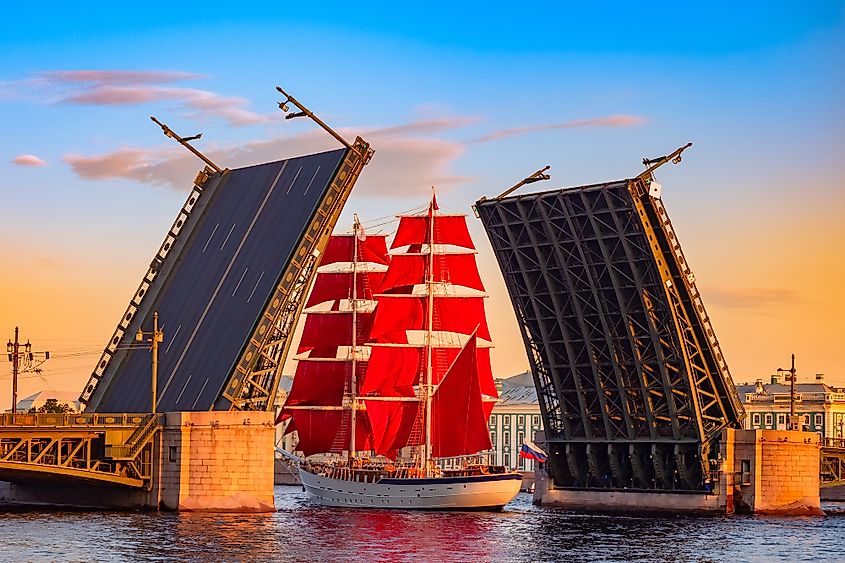
An equally important hub for transportation, as Moscow is, the port of St. Petersburg is also of international significance, with the main harbor protected by breakwaters and reachable from Kronshtadt via a dredged channel, as well as regular summertime ferry departures to various western European ports. Unfortunately, with the insufficient infrastructure for cruise vessels of the 21st century, those wishing to board ships have to pass through cargo facilities, while the smaller sea ships have access throughout the inland waterway system of European Russia from Neva to Lake Ladoga. Onward, there are water pathways to the White Sea and the Russian Arctic coast, the Volga basin and the Caspian Sea, and the Black Sea and the Sea of Azov.
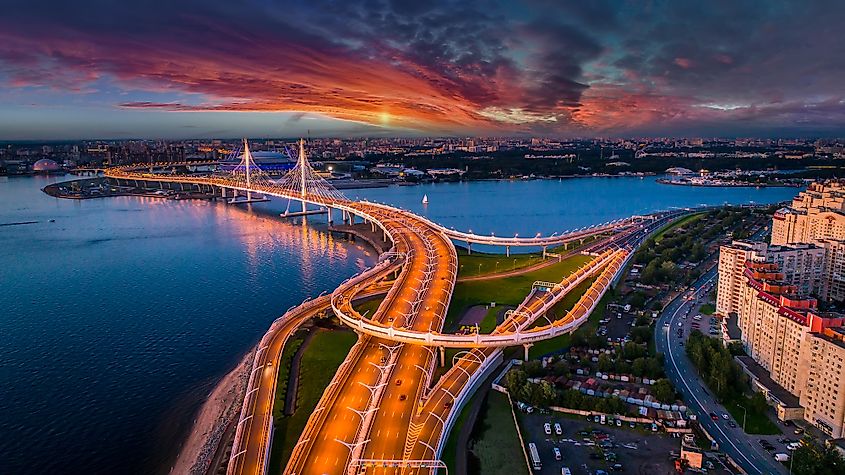
Pre-Covid-19 times, international train connections outside of Russia's main cities, such as Helsinki and Warsaw, were also subject to regular usage. Suburban electric tram service connects the outer parts of St. Petersburg to its satellite towns, while the internal city traffic is handled by a subway system, which was opened in 1955. The city's circulation system also includes a well-developed network of buses, streetcars, and trolleybus lines. The main Pulkovo International Airport sits 11 miles (18 km) south.
St. Petersburg experienced a major change upon the fall of the Soviet Union like the rest of Russia and its adjoining countries. Over the years, it has bloomed in terms of culture and services it forwards to the public and international visitors. New cafés and restaurants have sprouted everywhere, and bridges and landmarks have been illuminated. Nevertheless, the never-before-seen amount of homelessness also appeared on its decorated streets coinciding with the time that native residents begun to serve in influential posts and in the national government.
More in Places
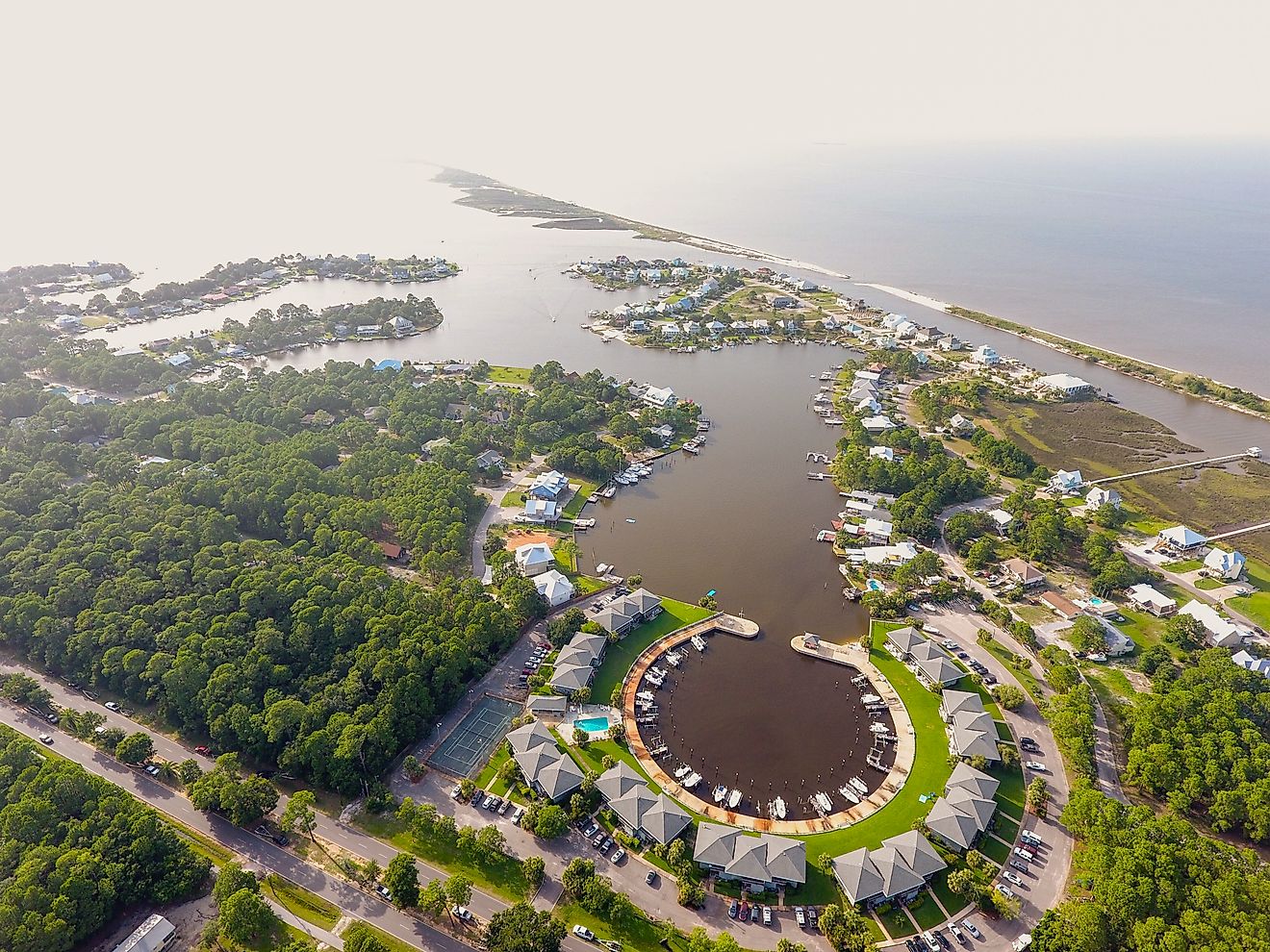
6 Whimsical Towns To Visit In Alabama
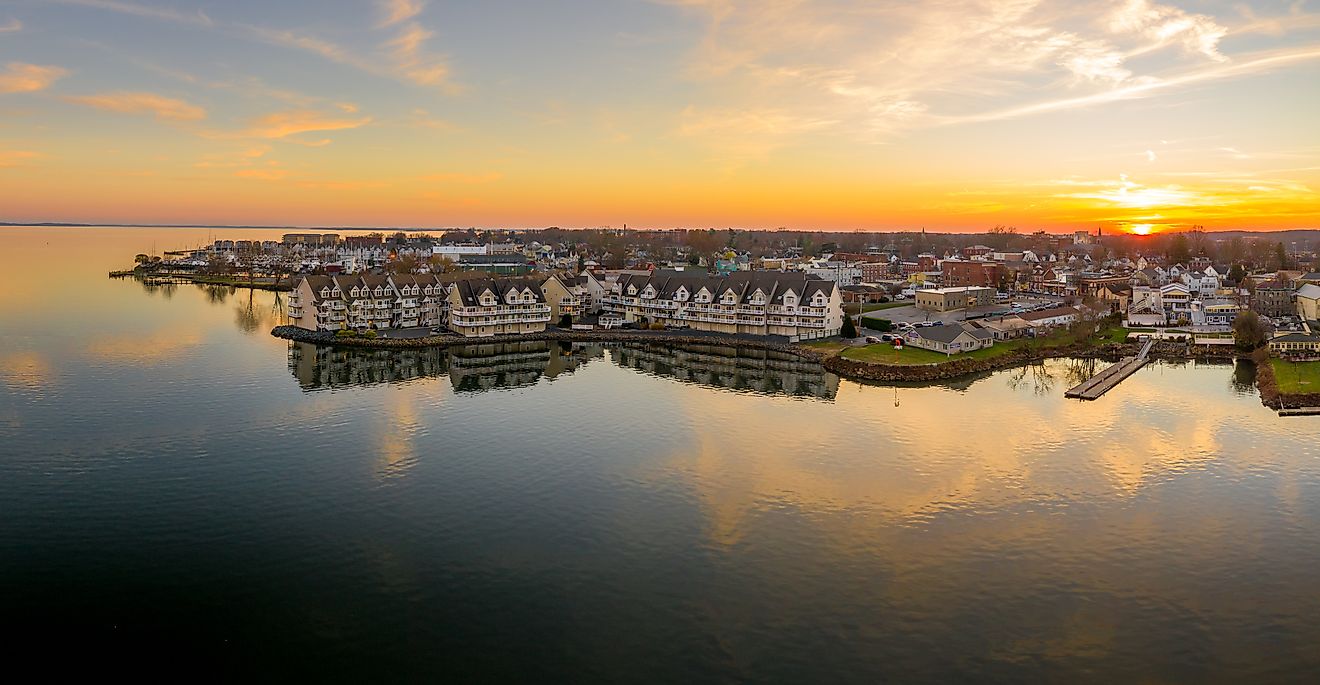
8 Whimsical Towns to Visit in Maryland
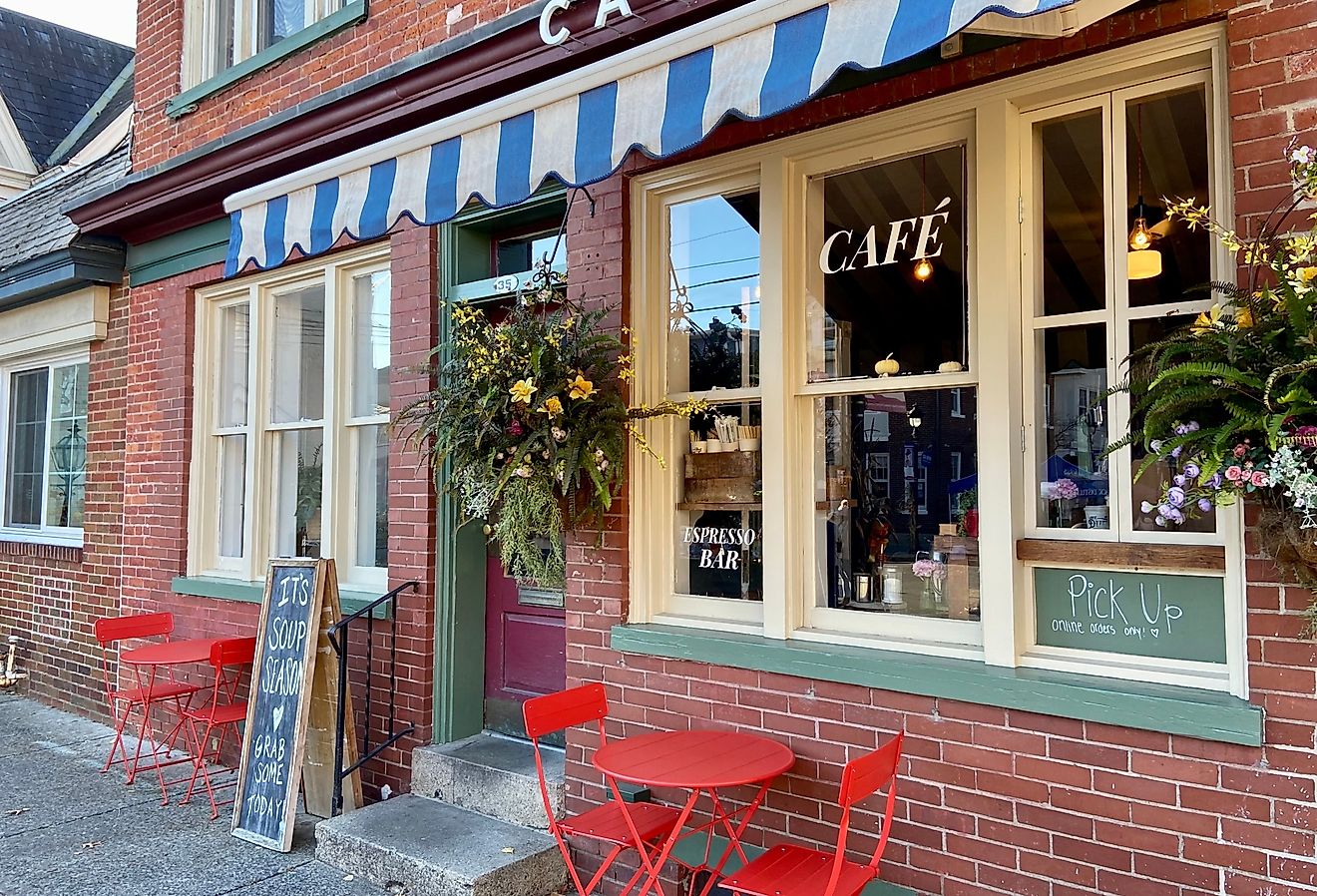
7 Towns in The Poconos With the Best Downtown Areas in 2024
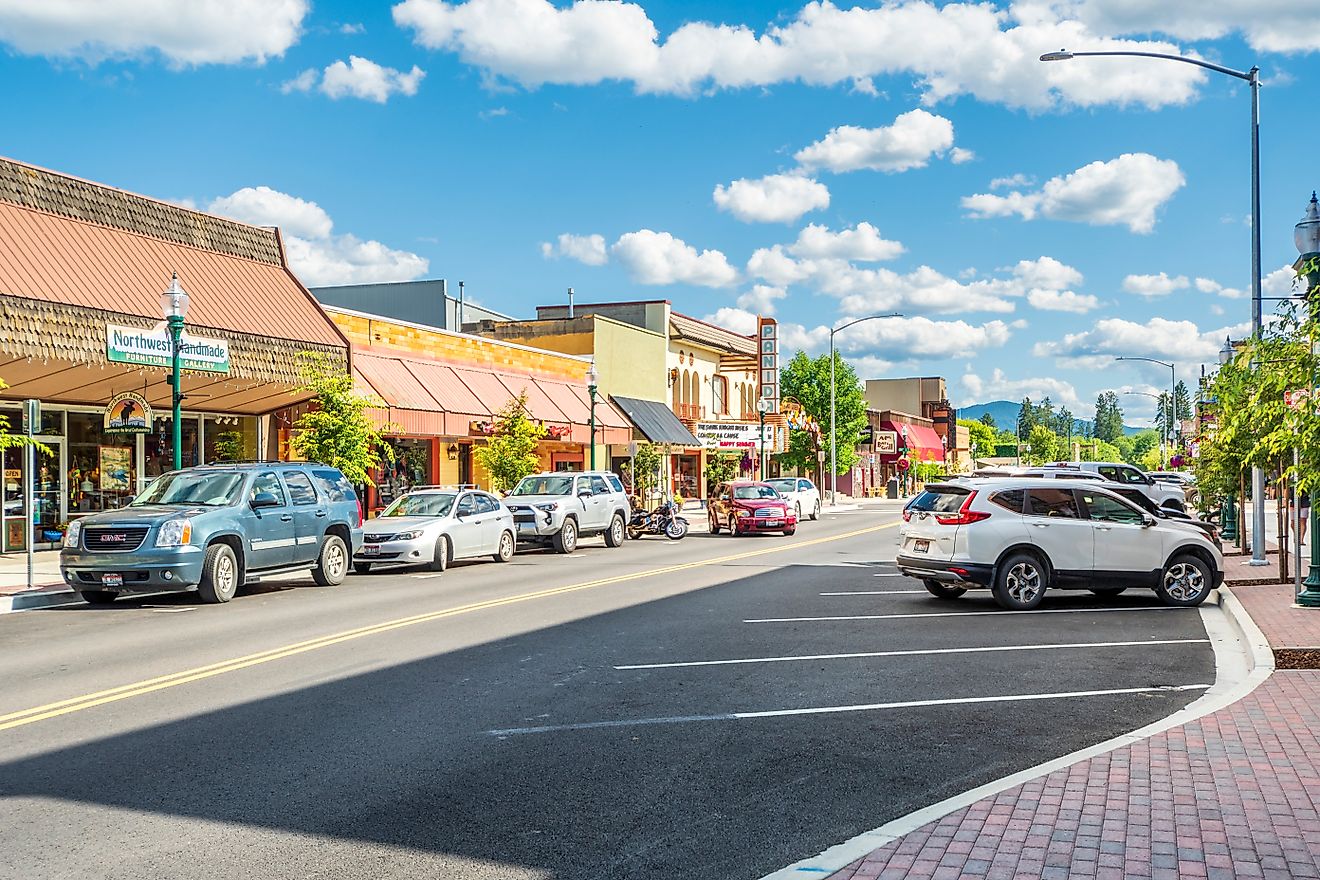
9 Towns in The Pacific Northwest with Vibrant Downtown Areas
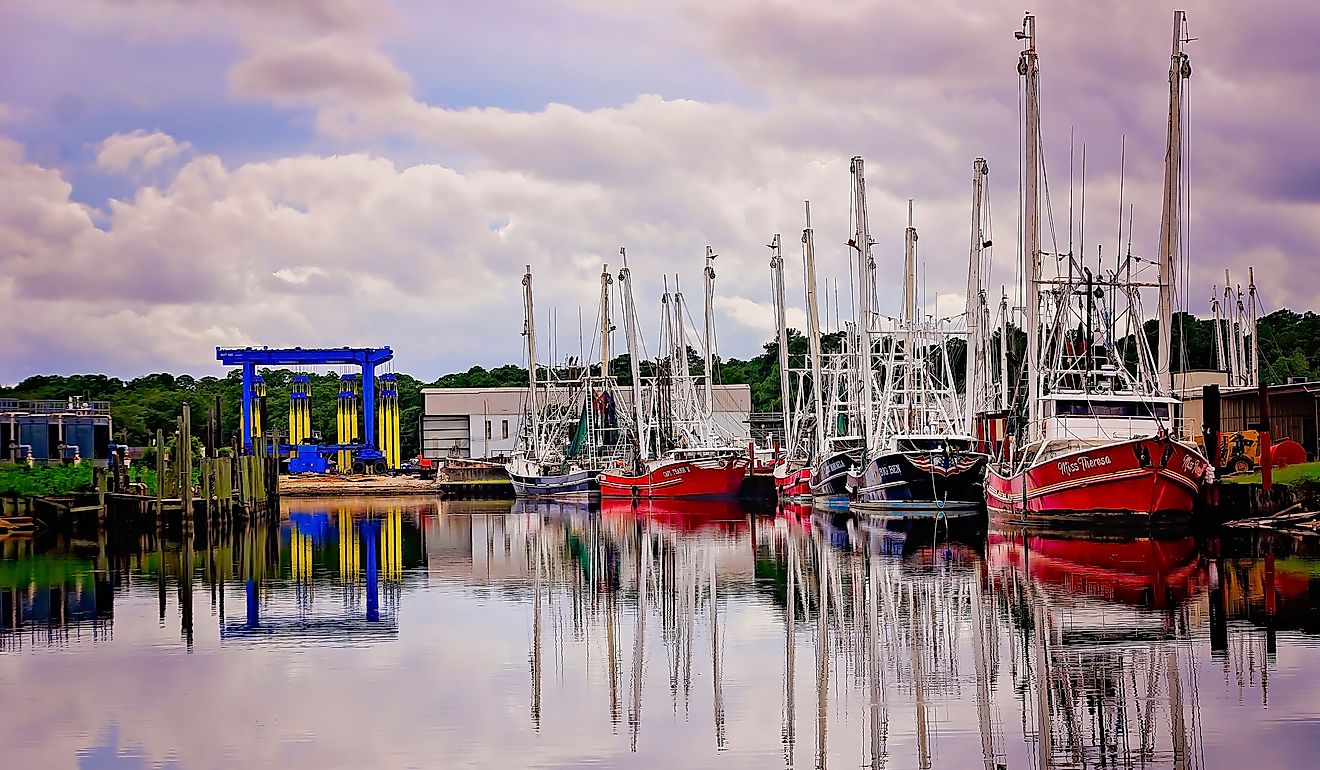
7 Ideal Alabama Destinations for a 3-Day Weekend in 2024
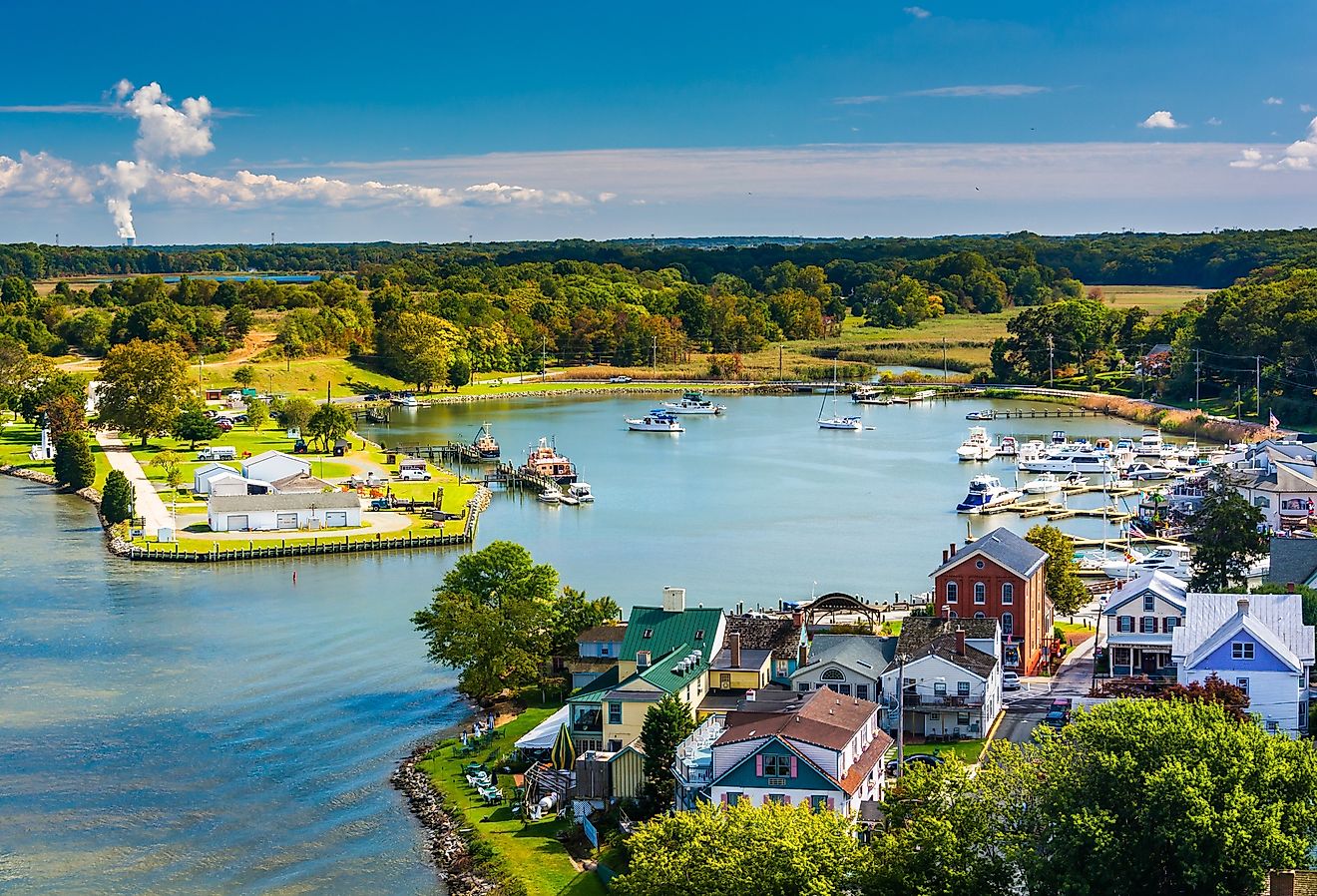
9 Prettiest Towns to Visit on the Chesapeake Bay
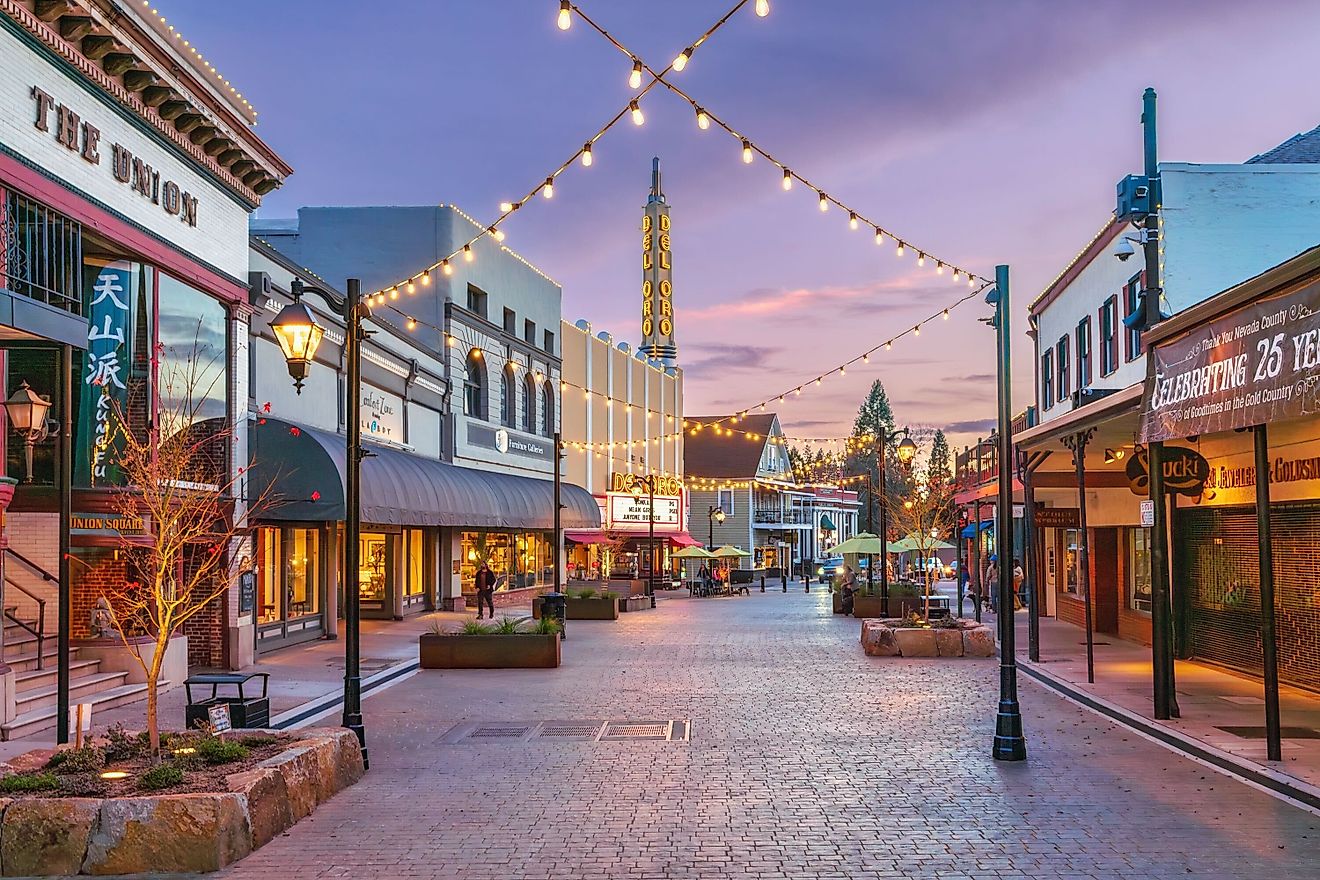
6 Most Bike-Friendly Towns in Northern California
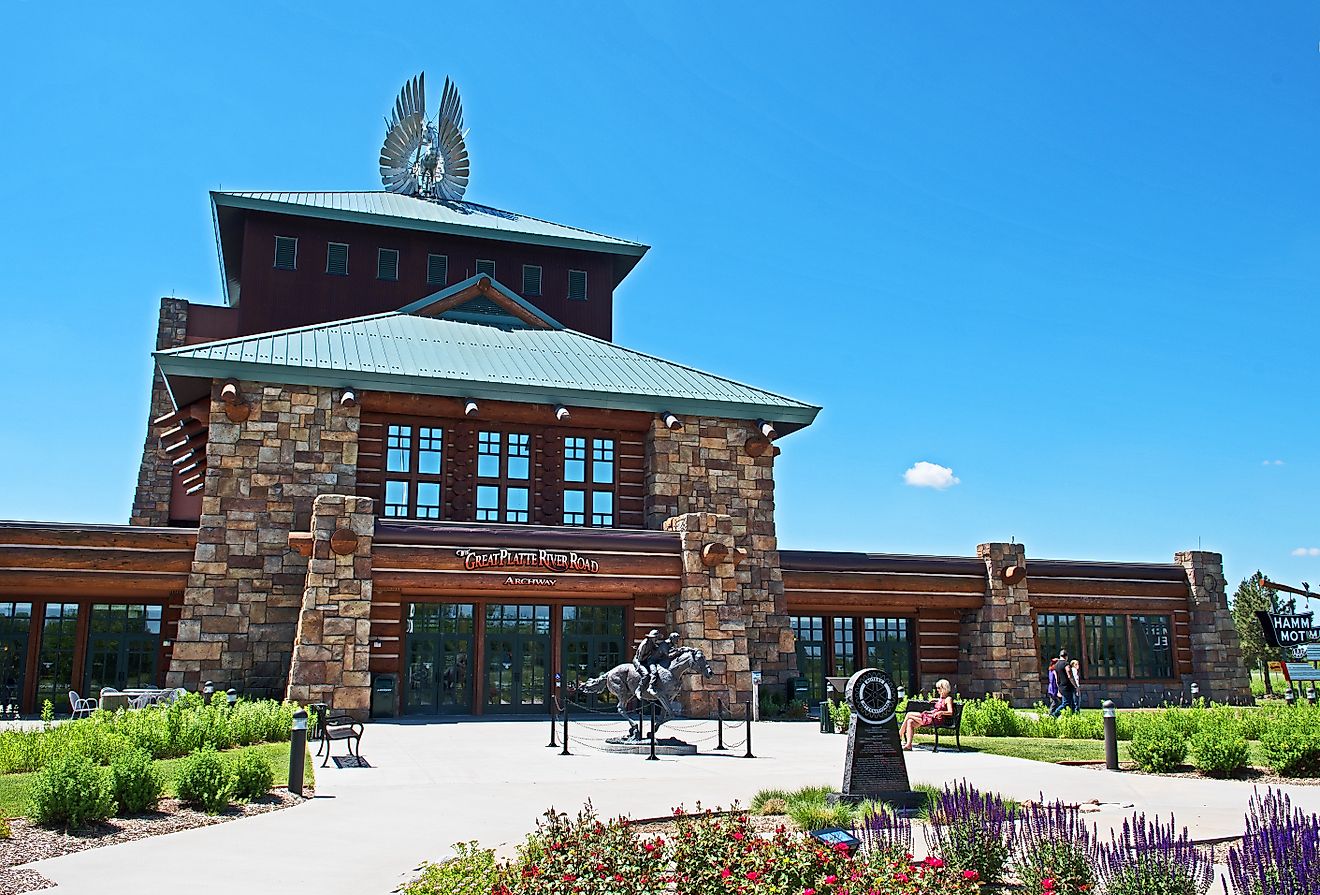
8 of the Most Charming Towns in Nebraska to Visit in 2024
- Quick Facts
- Sights & Attractions
- Tsarskoe Selo
- Oranienbaum
- Foreign St. Petersburg
- Restaurants & Bars
- Accommodation Guide
- St. Petersburg Hotels
- Serviced Apartments
- Bed and Breakfasts
- Private & Group Transfers
- Airport Transfers
- Concierge Service
- Russian Visa Guide
- Request Visa Support
- Walking Tours
- River Entertainment
- Public Transportation
- Travel Cards
- Essential Shopping Selection
- Business Directory
- Photo Gallery
- Video Gallery
- 360° Panoramas
- Moscow Hotels
- Moscow.Info
- History of St. Petersburg
- Petersburgers
- Scientists and inventors
Mikhail Lomonosov
Born: Denisovka, Archangelsk Province - 19 November 1711 Died: St. Petersburg - 15 April 1765
Mikhail Lomonosov was the great polymath of the Russian Enlightenment. Born in the deepest provinces of Northern Russia, he managed to gain a first-class education through a combination of natural intelligence and sheer force of will, and went on to make significant advances in several fields of science, as well as writing one of the first Russian grammars, several volumes of history, and a great quantity of poetry. In short, he was instrumental in pulling Russia further into the modern world, and in helping to make St. Petersburg a centre of learning as great as almost any in Europe.
Lomonosov was born in the village of Denisovka (now Lomonosovo), a village about 100 kilometers south-east of Arkhangelsk on the Severnaya Dvina river. His father was a peasant fisherman who had grown rich transporting goods from Arkhangelsk to settlements in the far north. His mother, the daughter of a deacon, died when he was very young, but not before she had taught him to read. From the age of ten, he accompanied his father on voyages to learn the business.
In 1730, however, determined to study, he ran away from home and walked over 1 000 kilometers to Moscow. Claiming to be the son of a provincial priest, he was able to enroll in the Slavic Greek Latin Academy, where he studied for five years before being sent on to St. Petersburg's Academic University. The following year (1736), he was a select group of outstanding students sponsored by the Academy of Sciences to study mathematics, chemistry, physics, philosophy and metallurgy in Western Europe. Lomonosov spent three years at the University of Marburg as a personal student of the philosopher Christian Wolff, then a year studying mining and metallurgy in Saxony, and a further year travelling in Germany and the Low Countries. While in Marburg, he fell in love with and married his landlady's daughter, Elizabeth Christine Zilch.
Due to lack of funds to support his young family, Lomonosov returned to St. Petersburg at the end of 1741, and was immediately appointed adjunct to the physics class at the Academy of Sciences. In 1745 he became the Academy's first Russian-born Professor of Chemistry, and in 1748 the first chemical research laboratory in Russia was built for him.
Throughout his career at the Academy, Lomonosov was a passionate advocate for making education in Russia more accessible to the lower ranks of Russian society. He campaigned to give public lectures in Russian and for the translation into Russian of more scientific texts. In this, he found himself in conflict with one of the founders of the Academy, the German ethnologist Gerhard Friedrich Miller (whose views on the importance of Scandinavians and Germans in Russian history Lomonosov also hotly disputed). By composing and presenting at an official Assembly of the Academy in 1749 his ode to the Empress Elizaveta Petrovna, Lomonosov gained considerable favour at court and a powerful ally in his pedagogical endeavours in the form of Elizaveta's lover, Count Ivan Shuvalov. Together, Lomonosov and Shuvalov founded Moscow University in 1755. It was also thanks to Shuvalov's influence that the Empress granted Lomonosov a manor and four surrounding villages at Ust-Ruditsa, where he was able to implement his plan to open a mosaic and glass factory, the first outside Italy to produce stained glass mosaics.
By 1758, Lomonosov's responsibilities included overseeing the Academy's Geography Department, Historical Assembly, University and Gymnasium, the latter of which he again insisted on making open to lowborn Russians. In 1760, he was appointed a foreign member of the Swedish Royal Academy of Sciences, and in 1764 he was similarly honoured by the Academy of Sciences of the Institute of Bologna. The same year, he was granted by Elizaveta Petrovna the rank of Secretary of State. He died 4 April 1765, and was buried in the Lazarev Cemetery of St. Petersburg's Alexander Nevsky Monastery.
Much of Lomonosov's work was unknown outside Russia until many years after his death, and even now it is more the extraordinary breadth of his inquiry and understanding, rather than any specific grand advancements in a particular field, that make him such a seminal figure in Russian science. Among the highlights of his academic career were his discovery of an atmosphere around Venus, his assertion of the Law of Conservation of Mass (nearly two decades before Antoine Lavoisier), and his development of a prototype of the Herschelian telescope. In 1764, he arranged the expedition along the northern coast of Siberia that discovered the Northeast Passage between the Atlantic and Pacific Oceans. His works also contained intuitions of the wave theory of light and the theory of continental drift. He made improvements to navigational instruments and demonstrated the organic origin of soil, peat, coal, petroleum and amber. Without knowledge of Da Vinci's work, he developed a working prototype of a helicopter.
He wrote the first guide to rhetoric in the Russian language, and his Russian Grammar was among the first to codify the language. His Ancient Russian History compared the development of Russia to the development of the Roman Empire, a theme that would become increasingly popular in the 19th century. His poetry was much praised during his lifetime, although it has been largely ignored by posterity.
Lomonosov is remembered in central St. Petersburg in the names of Ulitsa Lomonosova ("Lomonosov Street"), Ploshchad Lomonosova ("Lomonosov Square") and the adjacent bridge across the Fontanka River. During the Soviet Period, his name was given to the Imperial Porcelain Manufactory, and hence to the nearby metro station, Lomonosovskaya. The Soviets also renamed the suburban town of Oranienburg as Lomonosovo. In 1986, a magnificent monument to Lomonosov was unveiled in front of the Twelve Colleges, the main campus of St. Petersburg State University, acknowledging the enormous debt that institution owes the great polymath who is rightfully considered the father of Russian science.
We can help you make the right choice from hundreds of St. Petersburg hotels and hostels.
Live like a local in self-catering apartments at convenient locations in St. Petersburg.
Comprehensive solutions for those who relocate to St. Petersburg to live, work or study.
Maximize your time in St. Petersburg with tours expertly tailored to your interests.
Get around in comfort with a chauffeured car or van to suit your budget and requirements.
Book a comfortable, well-maintained bus or a van with professional driver for your group.
Navigate St. Petersburg’s dining scene and find restaurants to remember.
Need tickets for the Mariinsky, the Hermitage, a football game or any event? We can help.
Get our help and advice choosing services and options to plan a prefect train journey.
Let our meeting and events experts help you organize a superb event in St. Petersburg.
We can find you a suitable interpreter for your negotiations, research or other needs.
Get translations for all purposes from recommended professional translators.

IMAGES
COMMENTS
"Air travel at that time was something special," says Graham M. Simons, an aviation historian and author. ... a transatlantic flight ticket in the early 1960s would cost around $600, which is ...
In the 1950s, men wore three-piece suits and sombre ties, and women wore dresses, high heels and pearls. Things relaxed a bit in the 1960s, when a man could get away with a polar-neck shirt or a flowery tie, and a woman could wear hippy beads and a fashionable scarf. In the 1950s, air hostesses were like movie stars.
The 1950s and '60s are often regarded as the golden age of airlines, offering luxurious seating, fancy meals, and beaming flight attendants. But while it was...
How was flying in the 60s? Find out about the glamour, luxury and style of the jet set, the classes of travel, the food and the prices. See photos and menus of first class and economy flights from the 60s.
Sweeping cultural changes in the 1960s and 1970s reshaped the airline industry. More people began to fly, and air travel became less exclusive. Between 1955 and 1972, passenger numbers more than quadrupled. By 1972 almost half of all Americans had flown, although most passengers were still business travelers.
The golden age of travel in the 1950s and 1960s was the epitome of glamour and luxury. Flying was a huge event and only for the relatively wealthy. It was a prestigious and glamorous experience to have. ... The distinguishable design was ultimately rejected by the Air Force but led to the major success of a revolutionary airliner. 14. Jul 26, 2024.
1900s. The 1900s was all about that horse-and-carriage travel life. Horse-drawn carriages were the most popular mode of transport, as it was before cars came onto the scene. In fact, roadways were ...
During the 1960s, air travel became even more luxurious, with airlines offering more premium services and amenities. First-class cabins became more spacious and offered more luxurious amenities, and many airlines began to offer lounge access for first-class passengers. With the introduction of audio and video systems, in-flight entertainment ...
Are you looking for some retro travel inspiration or vintage aesthetic videos? Check out this video, where I take you on a tour of some vintage air travel fe...
As the Golden Age of Air Travel led on, well into the 1960s, those who were fortunate enough to enjoy travel on the newest commercial jetliners featured some of the biggest celebrities of the day, including the Beatles, who arrived at JFK International in New York from London aboard a Pan American Boeing 707, to thousands of screaming fans, and ...
What flying was like in the 1950s and 1960s compared to now. THE 1950s and '60s are known as the golden age of flying. Sure, it was glamorous, but it had some pretty major drawbacks.
An airline trip from New York to London that could take up to 15 hours in the early 1950s could be made in less than seven hours by the early 1960s. But airline nostalgia can be tricky, and ...
Do you know how much flying was different back in the day?#Travel #AirlineTravel #FlyingHave Your Idea Become A Video! https://wmojo.com/suggestTravel to our...
Extremely racist. There's another unpleasant side of flight in the 1950s and 1960s that tends to be glossed over. "I think it's important to point out that in the Golden Age of Flying, only ...
This is what it was like to fly in the 1950s: Welcome to The Jet Age. The Boeing 707 made its first flight on December 20, 1957, and was put into commercial service the following October by Pan Am ...
Air travel has come a long way since the 1950s, this we know. But in the '50s, flying was something different. It was something magical and marvelous. Air travel exploded into its Golden Age, and airplane trips weren't just a means of getting to your vacation -- they were a vacation in themselves. Passengers dressed in their finest to fly.
The 50s and 60s are often referred to as 'The Golden Age' of air travel. Commercial aviation had existed before the second world war, but it really got into its stride in the 50s. It was new, exciting and for some years, an exclusive way to travel. Aircraft designs were developing fast (not all were successful - some were disastrous); the ...
A National Airways Corporation (NAC) stewardess and passengers dressed their best to travel in 1959. NAC later merged with Air New Zealand. Photo " Air Hostess Uniform 1959 Summer 001 " by Archives New Zealand under CC 2.0. Travel in style. In the 1960s and 1970s, flying was a special experience.
Airlines, Airports and Air Travel: Vintage Allegheny Airlines film restored. This film provides an excellent overview of what typical airline travel was li...
Pargolovo is a municipal settlement in the Vyborgsky District of Saint Petersburg, Russia. Pargolovo has about 81,000 residents. Mapcarta, the open map.
Saint Petersburg. Sankt-Petersburg in nativity, Petrograd from 1914 to 1924 and Leningrad until 1991, is adorned by Russians and global tourists alike. This port-bound metropolis, located in the extreme northwest of the largest country in the world, Russia, comprises a major historical and cultural mecca, with an area of 550 square miles (1,400 ...
Mikhail Lomonosov was the great polymath of the Russian Enlightenment. Born in the deepest provinces of Northern Russia, he managed to gain a first-class education through a combination of natural intelligence and sheer force of will, and went on to make significant advances in several fields of science, as well as writing one of the first Russian grammars, several volumes of history, and a ...
Saint Petersburg, [a] formerly known as Petrograd and later Leningrad, [b] is the second-largest city in Russia after Moscow.It is situated on the River Neva, at the head of the Gulf of Finland on the Baltic Sea.The city had a population of 5,601,911 residents as of 2021, [5] with more than 6.4 million people living in the metropolitan area.Saint Petersburg is the fourth-most populous city in ...